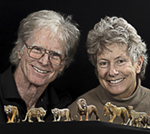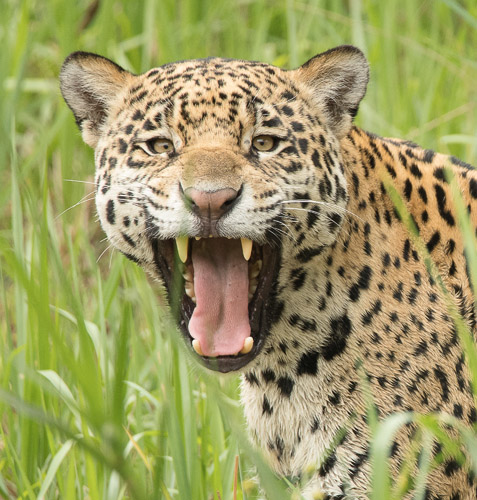
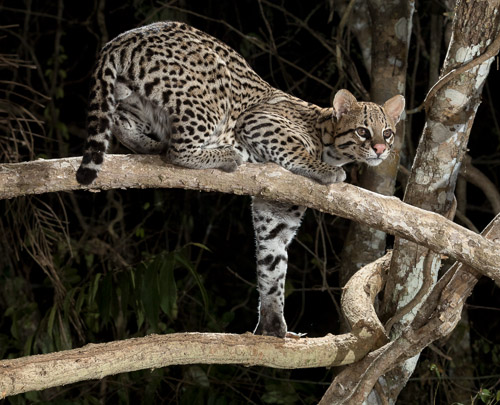
Jaguars and the Wildlife of the Pantanal
September 2017
Trip Report
This was our third Photo Tour to the Pantanal for 2017, and Mary and I were probably more excited about doing this trip than all the others, because we knew how good the 2017 Year was stacking up to be. We were not disappointed.
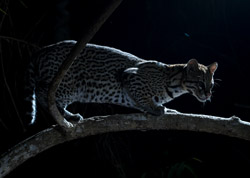 We had at least 16 Jaguars, two opportunities for Ocelots, where we were quite successful, and our best encounters, ever, for Brazilian Tapir and Giant Otters. We found two active dens, and at one we were treated to witness as the female swam with her 10 day old pups, still with their eyes closed, to a new den. At another den, we watched as pups just a few days older made what might have been their first swim and exploration outside the den.
We had at least 16 Jaguars, two opportunities for Ocelots, where we were quite successful, and our best encounters, ever, for Brazilian Tapir and Giant Otters. We found two active dens, and at one we were treated to witness as the female swam with her 10 day old pups, still with their eyes closed, to a new den. At another den, we watched as pups just a few days older made what might have been their first swim and exploration outside the den.
Until this year, tree-climbing with Jaguars was rarely observed, but on our first full-day in Jaguarland we had a great female Jaguar sprawled out along a limb about 14 feet above the lagoon. We had two other Jaguars that climbed up or out onto fallen logs, giving us classic shots.
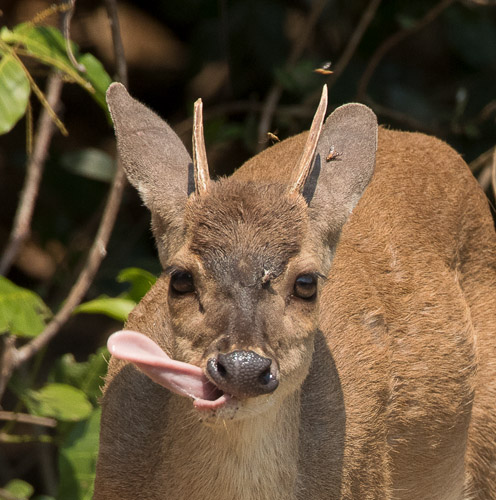
Male Brocket Deer from my water-level blind
I even tried something new that I'm hoping to incorporate into next year's shoot, and that's being close to some waterholes, camouflaged by netting and camou clothing. I spent a morning in one of these make-shift blinds I built, and I loved the experience.
Finally, this trip was special as it was composed of old friends that have traveled with us many times before, and we not only had great shooting but we had an enormous amount of fun as well.
N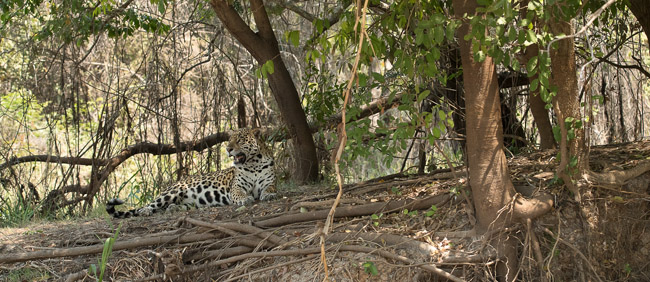 ext year, we're planning on two trips to the Pantanal, and despite the claims of some of our competitors, no one offers more diversity or knows the Pantanal, its wildlife, and the natural history of the wildlife than do we. Join us next year for an experience of a lifetime!
ext year, we're planning on two trips to the Pantanal, and despite the claims of some of our competitors, no one offers more diversity or knows the Pantanal, its wildlife, and the natural history of the wildlife than do we. Join us next year for an experience of a lifetime!
Sao Paulo
Hurricane Irma threatened to devastate Florida, and the threat of airport closures throughout the South caused disruptions for nearly everyone. Mary, Sam, and I were scheduled to fly out of Atlanta on Monday, giving us one full day in Sao Paulo for insurance – in case of weather! Instead, we were able to reschedule our flight and we left on Sunday, giving us two days in Sao Paulo … where we relaxed. Although we did office work and writing, the schedule was not as hectic as our Sunday would have been at home.
Everyone arrived on time, with the exception of one where American Airlines continued to cancel flights. Fortunately, though, only one day was missed.
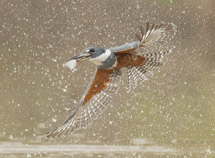 Day 1 Cuiaba to Santa Theresa
Day 1 Cuiaba to Santa Theresa
After arriving in Cuiaba and having lunch as a typical, meaning an over-the-top meat fest, barbeque, we headed toward the Pantanal and our first destination, South Wild’s Santa Theresa ranch. As we always do, we prepped everyone that we’d be driving fairly direct, as most everything we’d see we’d get better later. If there was something extraordinary, we’d stop. And we did!
Halfway between Pueso Allegre and ST I spotted a Brazilian Tapir feeding on water plants at a large roadside canal. It was nearing 5PM, still with plenty of light, and as the bus came to a long, slow stop and backed 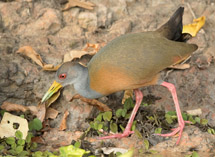 up, the Tapir remained. Nearly everyone got a few shots before it spooked and exited the pond, but after walking parallel to the shoreline for a few yards the Tapir reentered the pond, giving a great view, and shots, as it did so. The Tapir swam for several yards, then veered back to the opposite bank where it climbed out and headed through the brush back to the forest. This was a first, something we’ve never seen from the Transpantaneira Highway before, and a great omen.
up, the Tapir remained. Nearly everyone got a few shots before it spooked and exited the pond, but after walking parallel to the shoreline for a few yards the Tapir reentered the pond, giving a great view, and shots, as it did so. The Tapir swam for several yards, then veered back to the opposite bank where it climbed out and headed through the brush back to the forest. This was a first, something we’ve never seen from the Transpantaneira Highway before, and a great omen.
Day 2 – Santa Theresa
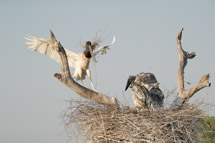 Prior to breakfast several of us made visits to the Jabiru Stork viewing tower where the adults performed, returning repeatedly with bill’s full of sticks to replenish their huge nest. The chicks, chicken-size when we left them 3 weeks ago, are now nearly half the size of the adults. Hummingbirds – at least two, but perhaps as many as six species, visited a flowering tree beside the lodge, and Caracaras, Kiskadees, and Pigeons fed at the feeder.
Prior to breakfast several of us made visits to the Jabiru Stork viewing tower where the adults performed, returning repeatedly with bill’s full of sticks to replenish their huge nest. The chicks, chicken-size when we left them 3 weeks ago, are now nearly half the size of the adults. Hummingbirds – at least two, but perhaps as many as six species, visited a flowering tree beside the lodge, and Caracaras, Kiskadees, and Pigeons fed at the feeder.
After breakfast we did our usual boat ride, for Ringed Kingfishers and Black-collared Hawks. The Hawks were sparse – we had two come in for fish, but those two opportunities were very good ones, with birds swooping in from the side, making it easy to follow and focus. One Great Black Hawk watched us from a tree, but never went for a fish.
All of us did very well with Ringed Kingfishers. Sometimes two birds would fly in at the same time, surprising us by appearing out of nowhere. The light was good, and the boats positioned well. The tame Amazon Kingfisher landed on Sam’s head – he was wearing a hat, and later grabbed a fish out of my hand.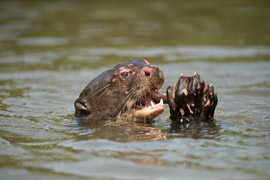
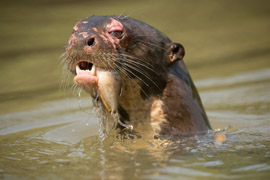
We traveled far upstream to where Giant Otters are quite tame, and we had two that swam around our boats. One looked quite old, with pink patches around his eyes. En route, we passed a lone Otter, which I thought was a Neotropical Otter, but that identification is just speculation.
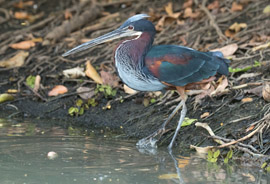 The morning highlight, though, was the Agami Heron, the most beautiful of the Western Hemisphere Herons, a bird with electric blue colors and a disproportionately long beak. We shot it in the open, a very rare occurance, at a location we’d never had them at before.
The morning highlight, though, was the Agami Heron, the most beautiful of the Western Hemisphere Herons, a bird with electric blue colors and a disproportionately long beak. We shot it in the open, a very rare occurance, at a location we’d never had them at before.
Returning at 10:45, we headed to the Ocelot blind for those with multiple flashes to have time to set up and position the flashes for the night’s shooting. That took over an hour and a half, and we returned late for lunch, hot and sweaty and tired.
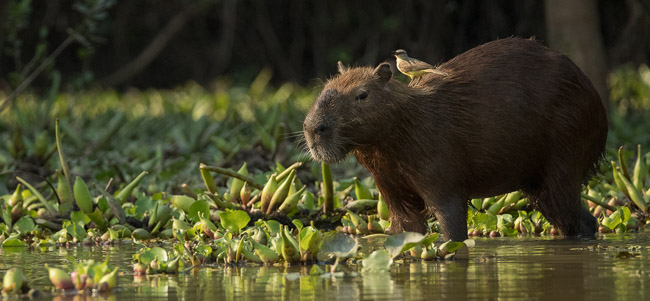
PM. At 3PM we headed downriver, passing where, at 8AM this morning and just out of sight of us as we set off on our morning boat ride, a Jaguar had grabbed a Capybara and carried it into the forest. One of South Wild’s drivers saw it happen, and may have shot a cell phone image of an event that may have lasted seconds.
We had several highlights, including very close shots of Green Kingfisher, Capybaras nursing and with cowbirds and Cattle Tyrants riding the rodents, and a Great Black Hawk that waited for us to toss it a fish. There were too many Water Hyacinths about, so our boatman tossed a fish onto the open river bank and the hawk swooped down and consumed it there, in beautiful light and completely in the open. The Great Potoo, an incredibly cryptic nightjar relative, was visible and worth the shore hike to reach this bird in good light.
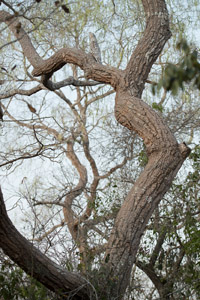
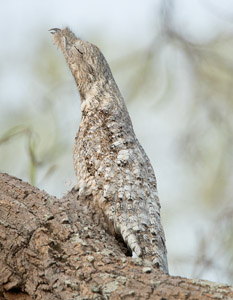
Great Potoo, showing the camouflage and the detail
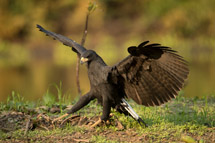

Great Black Hawk; Limpkin
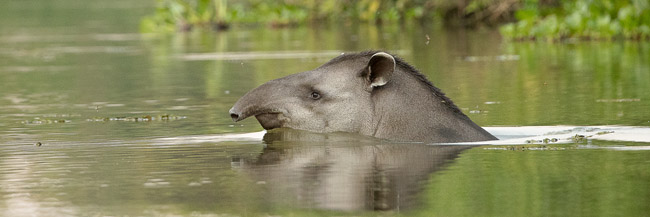
As we returned to the lodge we encountered a Tapir – this stretch of river has often had them. The Tapir, instead of exiting at its nearest shore, swam across the small river right in front of us before gaining the shoreline and galloping into the woods. I used the Tamron 150-600 on a monopod and the images were sharp!
After dinner he headed to the Ocelot blind, getting there a few minutes early to  turn on the flashes and confirm exposures. Doing so with everyone was a bit noisy, and Marcos worried that we may have frightened off the cat. Once we settled in, we waited for ten minutes, a nerve-wracking time as I worried, but soon Mary spotted an Ocelot coming in from the right. The same Ocelot returned several times, sometimes pausing to look intently into the forest. We wondered if there was another Ocelot, or if it sensed the Jaguar that had laid tracks along this trail yesterday. After 1.5 hours the food was done and we took down the flashes. I stayed with Marcos an extra ten minutes, in the dark, hoping the cat would return so that we could do some video without flashes firing. The cat returned, for two quick checks of the area, and then vanished for good.
turn on the flashes and confirm exposures. Doing so with everyone was a bit noisy, and Marcos worried that we may have frightened off the cat. Once we settled in, we waited for ten minutes, a nerve-wracking time as I worried, but soon Mary spotted an Ocelot coming in from the right. The same Ocelot returned several times, sometimes pausing to look intently into the forest. We wondered if there was another Ocelot, or if it sensed the Jaguar that had laid tracks along this trail yesterday. After 1.5 hours the food was done and we took down the flashes. I stayed with Marcos an extra ten minutes, in the dark, hoping the cat would return so that we could do some video without flashes firing. The cat returned, for two quick checks of the area, and then vanished for good.
When I returned, I found Mary and Scott by the river, working on some star shots of the Milky Way. I joined them, and we headed to the Stork nest for a better foreground, and shot some great images where we lightly painted the tree, balancing that with the glowing Milky Way. Beautiful!
Day 3. Santa Theresa to Jaguarland
No one shot this morning as we packed to head to the Flotel, a fortuitous decision since the landscape was shrouded in a smog – fog and smoke, diffusing the light in an-unmotivating way for early light. At 8 we headed out, crossing one bridge that had Mary very nervous as our bus’s tires sank into the rotten wood. After passing by, Marcos, the Driver, and I gathered some planks to shore up what was beginning to look like a very unsafe bridge.
En route we had a 6-7 foot long Yellow Anaconda that stretched across the road, which eventually doubled back, doing a serpentine, looping motion as it raced off. It’s trail showed the more typical locomotion of a constrictor – a caterpillar-like movement where belly scales inch forward, grip, and pull, leaving a track that is essentially a straight line. It’s exit was a series of loops.
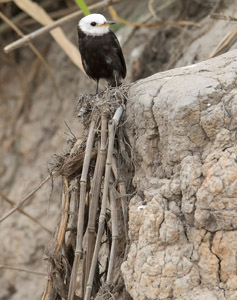 PM. At 3 we headed out, and my boat explored the Black Lagoon while Mary headed up the Charles Creek, where they had some good bird shooting. My boat cruised, heading further upriver than I think I’ve ever gone, but we saw nothing. On our return, I faced backwards, hoping to spot a hidden cat that everyone facing forward might miss. I didn’t, but we received a radio call that a Jaguar was on the Cuiaba River. We raced there, but the cat was gone. While we waited, we had another call, and we raced downriver where Mary’s boat arrived first, and had a brief glimpse. I saw the cat, seconds worth, before it disappeared into the grasses. We waited, as the light increasingly faded, and headed back
PM. At 3 we headed out, and my boat explored the Black Lagoon while Mary headed up the Charles Creek, where they had some good bird shooting. My boat cruised, heading further upriver than I think I’ve ever gone, but we saw nothing. On our return, I faced backwards, hoping to spot a hidden cat that everyone facing forward might miss. I didn’t, but we received a radio call that a Jaguar was on the Cuiaba River. We raced there, but the cat was gone. While we waited, we had another call, and we raced downriver where Mary’s boat arrived first, and had a brief glimpse. I saw the cat, seconds worth, before it disappeared into the grasses. We waited, as the light increasingly faded, and headed back
Mary had left five minutes earlier and on the Piquiri River she spotted a new Jaguar, a nursing female – teats were visible in her shot – but the cat only stayed in the open for a few minutes before disappearing. My boat, following behind, missed it.
As we neared the Flotel at 6 the atmosphere above the Flotel was thick with hanging with smoke.
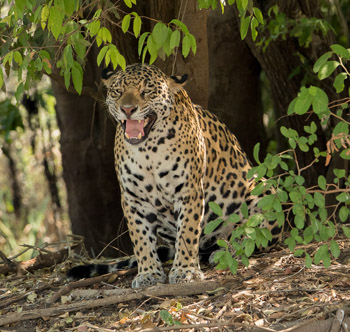
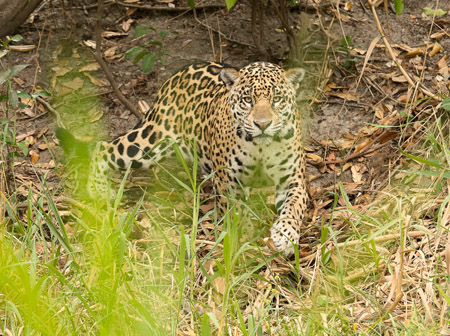
Day 4. Jaguarland
Five Jaguars today! Surprisingly, an Arctic Front blew in during the night and we started our boat ride under windy, quite cool, and overcast conditions. I wondered if it would rain, and having a cold front this late in the season was completely unexpected.
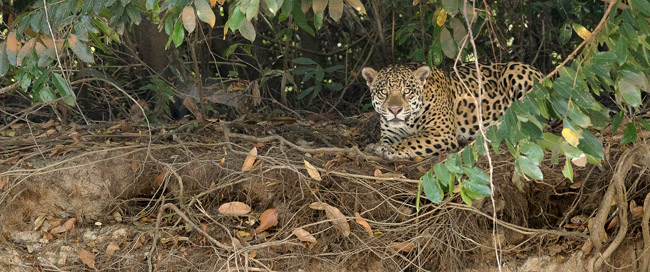
We were barely to the Cuiaba River juncture when we received a radio call about a Jaguar. We doubled back, to find a Jaguar stalking on the top of one of the high riverbanks, with a family of Capybara about thirty yards away. The cat was in a serious, slow stalk, but the wind must have wafted scent to the rodents as they constantly barked alarm calls, based I’m sure on scent since they could not see the cat. Eventually they must have gotten a real nose-full, as they dashed into the river. The Jaguar walked towards them, then disappeared into the forest.
Soon we had another call, for a Jaguar on the Three Brothers. As we approached the pile up of boats I kept looking at the shorelines, since there’s always the chance that another cat might be there that people miss in a hurry to get to a sighted cat. Apparently the Jaguar causing the pile up had disappeared, but I spotted it about 300 yards downriver as we passed. We stopped, and got a few shots before the Jaguar moved into the brush. We followed it downriver, seeing its silhouette now and then, but no other shots.
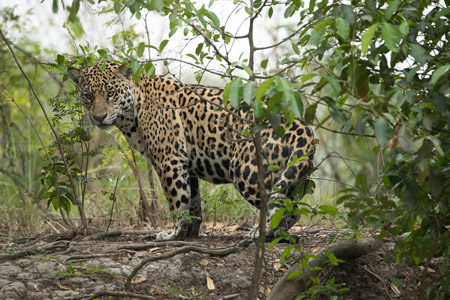 Another radio call – this time at the Black Lagoon. We headed there, to find a cat curled up along a clearing beside a side channel where we’ve often seen Jaguars. The cat was in the open and presented several pose through the morning, and at one point started hunting, moving down the stream bank and into the grasses, straight towards our boat. The cat kept coming, until she was just 25 or so feet away, close enough that I advised my
Another radio call – this time at the Black Lagoon. We headed there, to find a cat curled up along a clearing beside a side channel where we’ve often seen Jaguars. The cat was in the open and presented several pose through the morning, and at one point started hunting, moving down the stream bank and into the grasses, straight towards our boat. The cat kept coming, until she was just 25 or so feet away, close enough that I advised my 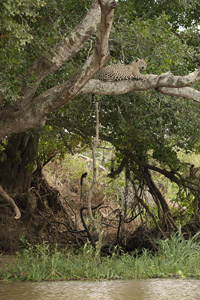 people – Sam, Scott, Sue, and David, that if the cat tried climbing into the boat, don’t panic and don’t move. Why she would do that I had no idea, so I was fairly sure she wouldn’t, but I still was relieved when she turned and hunted away from us.
people – Sam, Scott, Sue, and David, that if the cat tried climbing into the boat, don’t panic and don’t move. Why she would do that I had no idea, so I was fairly sure she wouldn’t, but I still was relieved when she turned and hunted away from us.
About that time we had another radio call that another Jaguar on the Black Lagoon – we’d searched for it earlier, was now in a tree. When we arrived there was a large boat jam, and I was sure we’d be out of position but our boatman, a miracle worker, slipped into a spot and we had, I’m convinced, the best view. The cat was twenty feet off the water, lying on a tree limb like a Serengeti Leopard, and periodically slept or looked about.
Then, a woman with a pro video camera got out of her boat on the opposite shoreline, and she and her guide walked to the shore opposite the cat. It was sleeping, we suspect, and didn’t see her, but her action caused another boat of tourists to do likewise, and sure enough, soon the 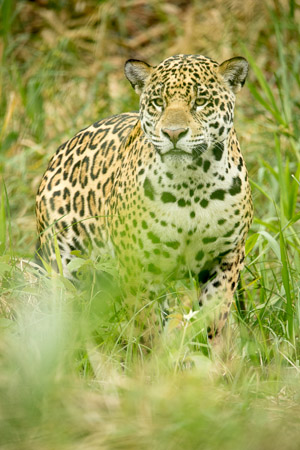 cat spotted them and slunk down the tree and out of sight.
cat spotted them and slunk down the tree and out of sight.
A few minutes later I had a chance to explain to the tourists how their action impacted the cat and screwed it up for everyone. I was surprisingly low key. Another pro photographer, a good friend, was also there with his group and as he passed them, he reinforced my message – a bit more forcefully this time. I felt like good cop/bad cop.
We headed back to our cat, and resumed the vigil. At 1PM Mary took one group back to the Flotel for lunch, while I stayed with my group and Randy, who joined us. Not much happened, and Mary returned with lunches for all of us, and beer!
PM. At 3 we decided to look for more cats, as our’s now went hunting, and then settled down out of sight. We headed up the Three Brothers, finding nothing, but as we headed back we had another call, and we reversed, spotting our 5th cat but there were no shots.
Mary’s group had a great encounter with Giant Otters, including a baby that tried stealing fish from its parents. It was a great show.
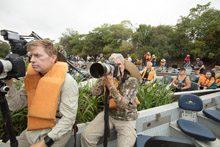
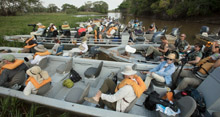
We had the prime position for much of the action, but the number of boats was huge! Interestingly, we met a couple of guys who were about to go to 'Jaguarland' and said they would observe 'radio silence' and not stop if there were other boats at a Jaguar. They expected to see 7-8 cats a day, and they were a bit disappointed when I explained the reality of the shooting.
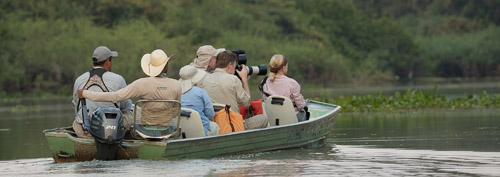
At Santa Theresa we have the river to ourselves, as we shoot mammals and birds.
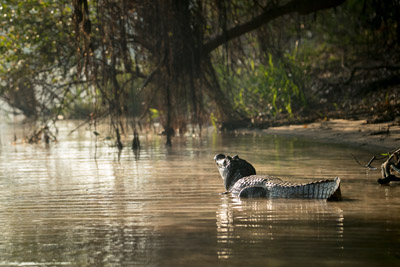 Day 5. Jaguarland
Day 5. Jaguarland
We had clear skies last night and this morning, as expected, it was cold, although not as frigid as we experienced earlier in the year. We headed toward the Black Lagoon, hoping to have Caimans doing the bubble dance. I saw nor heard any Caimans displaying. However, we had a very cooperative juvenile Caiman with a large armored Catfish that turned towards us – rather than facing the shoreline as they usually do – and after a several minute 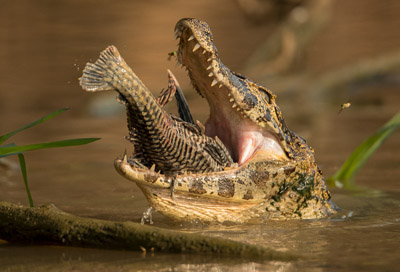 wait, began chomping down the surprisingly large fish.
wait, began chomping down the surprisingly large fish.
Later, we had another Caiman with another Catfish with a Coqui Heron nearby. At first, I thought the Heron might be plotting on stealing the catfish, but although it often came close, and was obviously tied in with the Caiman, I think it was ready to grab any fish attracted by the feeding. Eventually the Caiman swallowed the fish and the two separated.
Mary did very well on filling in portfolios for people, getting Great Black Hawk, Green Kingfisher, Long-nosed Bats (later, I did, 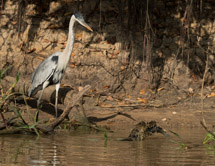 too), and several others. Ironically, I had motored up the Charles Creek too, but the area was rather barren when we passed.
too), and several others. Ironically, I had motored up the Charles Creek too, but the area was rather barren when we passed.
As we headed further upriver I spotted another Jaguar, lying in the deep shade of a river bank. Our boatman got on the radio and soon about 15 boats were there, indicating no other Jaguar had been seen that morning. Before the other boats arrived the cat got up and moved down to the shoreline for some nice images, and afterwards it disappeared.
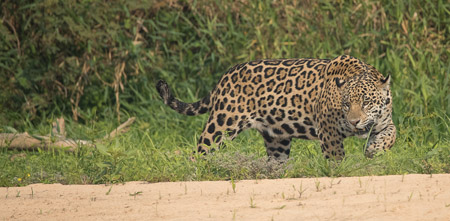 Later, we think the same Jaguar was reported. This time we paralleled the Jaguar for a long time, finally positioning ourselves at a sand bar where we hoped the cat would come to drink. It didn’t, but the cat did come into the open here, backlighted against the brilliant sand. I suggested people open up 1.7 stops off the sand – the cat was still dark, but nothing was clipped and I suspect the shots will be OK.
Later, we think the same Jaguar was reported. This time we paralleled the Jaguar for a long time, finally positioning ourselves at a sand bar where we hoped the cat would come to drink. It didn’t, but the cat did come into the open here, backlighted against the brilliant sand. I suggested people open up 1.7 stops off the sand – the cat was still dark, but nothing was clipped and I suspect the shots will be OK.
By 11 it seemed as if the Jaguar had settled down, and was hidden, and we headed back to the Flotel for lunch.
NOTE: The two Jaguars this morning were two different individuals.
PM. We left at 2:30 as the afternoon still had some coolness from the front. Mary stopped for Black Vultures at the sandy beach, hoping the birds would bathe, and while there had a great nearly one hour session with White-winged Swallows, with adults feeding fledglings on a branch. Frequently the parent would land on the baby’s back to feed. Bees and dragonflies were fed. Meanwhile, my boat headed up the Cuiaba River where I had the mother Jaguar and cub. We saw no cats.
When we returned to the Three Brothers, Mary’s boat was anchored at a Giant Otter den.
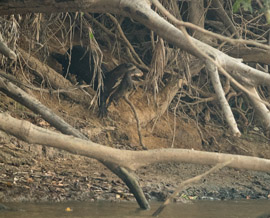
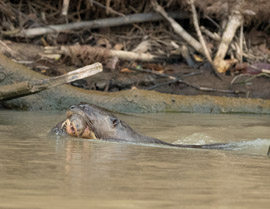
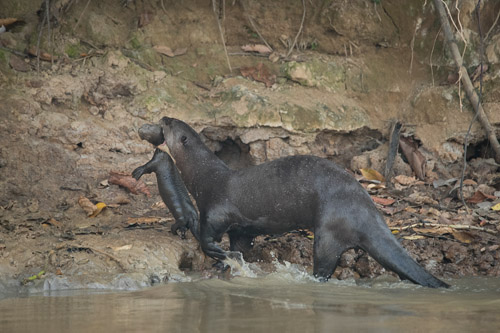
The adults and one baby were playing and wrestling. My boat arrived late, but moved up, too, hoping for some action. The otters swam off, then returned to the den, and then moved upstream where they ran into a new den. We thought the action was over when suddenly the Otters dashed out of the den, too unexpected for anyone to get a shot. The otters moved back to the original den, and then, again to our surprise, an otter headed back out and upriver. We didn’t notice it until it was too late – the Otter was carrying a 10 day old pup, still with its closed! 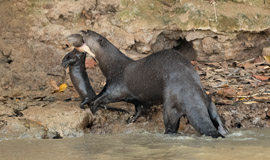 A few minutes later the Otter emerged, headed back down to the den, and grabbed another pup. In all, she returned with four pups, and after depositing the last one, she remained in the den.
A few minutes later the Otter emerged, headed back down to the den, and grabbed another pup. In all, she returned with four pups, and after depositing the last one, she remained in the den.
Another Jaguar radio call had us racing up river to the exact location where we had our second Jaguar this morning. We followed her downriver – amidst probably every boat on the river, and, at one point, the Jaguar came out onto a sand bank (down river from where I was waiting) where Mary’s boat had just moved, and they got the cat as it moved down to the water to drink. The cat continued to move downstream and my boat, and Mary’s, were able to get in front of, or parallel, for multiple shooting sequences. Eventually the Jaguar moved back into the forest and we headed for home.
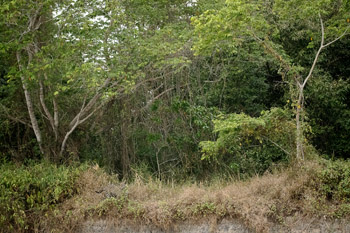
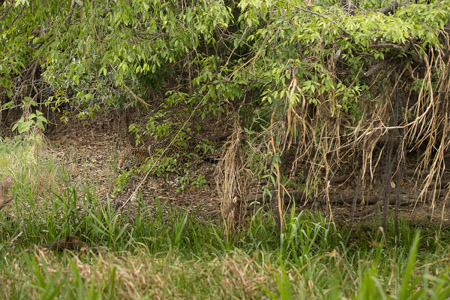
There are Jaguars here, can you see them?
Day 6. Jaguarland
This morning was one of those slow, luckless times that is simply a part of field work. My boat, in the Black Lagoon, had a Cattle Tyrant on a spine-tail bird’s nest, and nothing else until 11AM when we had a male Howler Monkey hanging by its tail as it picked fruit.
Mary did a bit better, having a troop of Howler Monkeys and some good views of both the females and the male, and a great Prehensile-tailed Porcupine. Other than that, however, it was an effort to stay awake.
We cruised everywhere – up the Black Lagoon, the Charles, far up the Cuiaba, but there was nothing worthwhile to photograph. Sure, we could have shot some Coqui Herons and some perched Terns, but even those subjects were not presenting anything unique. It really was slow.
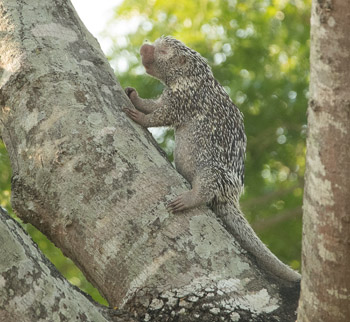 PM. We left at 3, with a reported sleeping Jaguar at the Black Lagoon. Twenty-some boats were already waiting for the cat, which was lying beneath a tree in deep shade. Another report of a Jaguar on the Cuiaba had us racing there – as much to escape the heat – but when we arrived the cat was gone.
PM. We left at 3, with a reported sleeping Jaguar at the Black Lagoon. Twenty-some boats were already waiting for the cat, which was lying beneath a tree in deep shade. Another report of a Jaguar on the Cuiaba had us racing there – as much to escape the heat – but when we arrived the cat was gone.
Mary returned to the Lagoon, where in the late light of day the Jaguar walked along the shoreline for some great shots.
My boat headed up the Three Brothers to check out the Prehensile-tailed Porcupine, which was now closer than it had been in the morning, and with our boatman cutting the engine we got some great shots. Virtually everyone else was at the Lagoon so we headed upriver, hoping to find a Jaguar for ourselves. We did not.
However, upriver from the San Pedro, we discovered a new Giant Otter den. Four or five babies were just coming out to explore, their eyes barely open. Periodically one or more adults would swim in to the den, a series of tree roots, and lead them 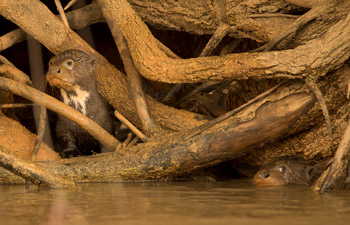 out, finally attempting to have them clamber a steep, slick clay bank where another den was located. One of the adults grabbed a baby and carried it up, while the others still pawed and scraped, finally giving up and returning to the original den under the roots. We left then, figuring that this was one of the pups first outings, and we’d give them time to explore their world without the distraction or worry of a boat nearby.
out, finally attempting to have them clamber a steep, slick clay bank where another den was located. One of the adults grabbed a baby and carried it up, while the others still pawed and scraped, finally giving up and returning to the original den under the roots. We left then, figuring that this was one of the pups first outings, and we’d give them time to explore their world without the distraction or worry of a boat nearby.
As we headed home the river was filled at times with swooping Fishing Bats, but we recognized the opportunity too late for ‘bat baseball’ with our flashes. Mary finished the day with a Capybara family on a sunset beach, roosting egrets, and a sunset.
Day 7. Jaguarland
We left at 5:45 with the air still cool from what is left of the cold front. We headed up the Cuiaba River, hoping to find Jaguars here where there’s a bit less boat traffic. We did not.
We had a real first, a pair of Mating Giant Otters! The shooting was difficult, just writhing bodies periodically surfacing, and occasionally two heads, but a lot of growling and yelps, and the entire time we were with them – 16 minutes, did not account for whatever occurred before we arrived.
Except for an angry Large-billed Tern that followed my boat for 100 yards, and then dive-bombed Mary’s boat as she passed, the bird activity was slow. We did have a floating diner however, a dead Caiman floating belly-up with a Black Vulture riding along, picking at the flesh. At one point the carcass drifted within an arm’s length of our boat, and the Vulture stayed.
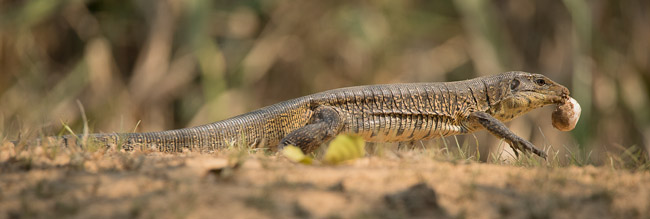
Heading down the side channel to the Three Brothers River we had a Golden Tegu that had raided an Iguana nest. When we arrived it was carrying the egg, but after finished one it returned to the nest hole, went inside, and emerged with a second egg. We were hoping for a third but the lizard, after finishing the egg, wandered off into the forest.
Mary’s boat went up the Pedersen channel where they had our family of Otters from last evening, now feeding on fish and attracting a Caiman that would grab the left-overs. A Coqui Heron stalked about, like the one we had in the Lagoon, perhaps looking to pick off fish attracted by the bits. Mary’s boat also had another Porcupine, which is truly exceptional since that makes only the third we’ve ever seen.
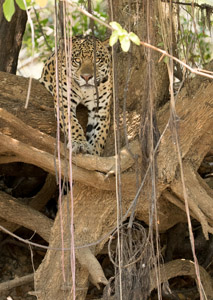 As we headed downriver we came upon a Jaguar jam, one we think we’d received a radio call over an hour earlier. My boatman suggested we continue. We had just entered the Black Lagoon when the Otter family that dens nearby swam passed, and I suggested we follow them to the den. I had my directions wrong – the den was further than I thought, and as I discovered this we did a U turn and headed back up the Lagoon,
As we headed downriver we came upon a Jaguar jam, one we think we’d received a radio call over an hour earlier. My boatman suggested we continue. We had just entered the Black Lagoon when the Otter family that dens nearby swam passed, and I suggested we follow them to the den. I had my directions wrong – the den was further than I thought, and as I discovered this we did a U turn and headed back up the Lagoon,
We were about a third of the way in when I spotted a Jaguar lying across a tree route. River vines blocked the area for a wide view so we moved in closer, and the cat got up and climbed down to the river bank directly below the tree – right in front of us! We were the only ones here, but after our boatman radioed Mary’s boat we were soon joined by about 15 other boats. Fortunately we were able to maintain the prime position that we deserved, having found the cat.
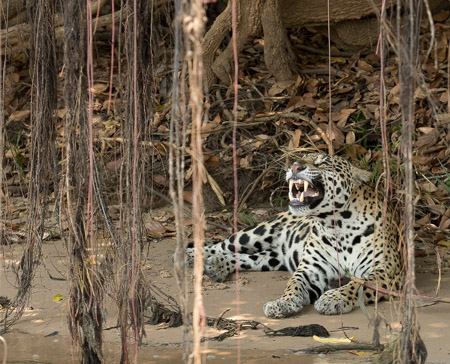 Eventually the Jaguar got up and moved about, first doing the flehmen scent-tasting pose, then moving downstream where, at one point, it chased an Agouti that fled into the water. The Jaguar followed, and returned three times, moving through the river grasses and eventually catching the rodent. David got a shot of the Jaguar as it chased the Agouti, and Jack got a shot as it carried the Agouti into the forest. Now 12:45, we headed back for lunch.
Eventually the Jaguar got up and moved about, first doing the flehmen scent-tasting pose, then moving downstream where, at one point, it chased an Agouti that fled into the water. The Jaguar followed, and returned three times, moving through the river grasses and eventually catching the rodent. David got a shot of the Jaguar as it chased the Agouti, and Jack got a shot as it carried the Agouti into the forest. Now 12:45, we headed back for lunch.
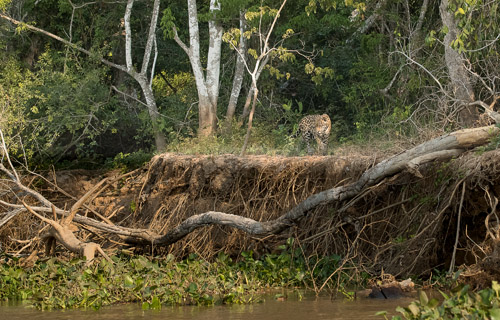 PM. We left at 3PM and raced towards the Chiaba River where a Jaguar had been reported. We arrived as the cat was still walking along the river’s edge, with five Giant Otters mid-stream, screaming their complaints. As we later discovered, the Jaguar was walking right passed their den.
PM. We left at 3PM and raced towards the Chiaba River where a Jaguar had been reported. We arrived as the cat was still walking along the river’s edge, with five Giant Otters mid-stream, screaming their complaints. As we later discovered, the Jaguar was walking right passed their den.
The Jaguar moved downstream, rounding a bend and moving downriver. We anticipated spots we were expected the Jaguar to appear, and hopefully climb out onto a log, but the latter did not occur, at that time. 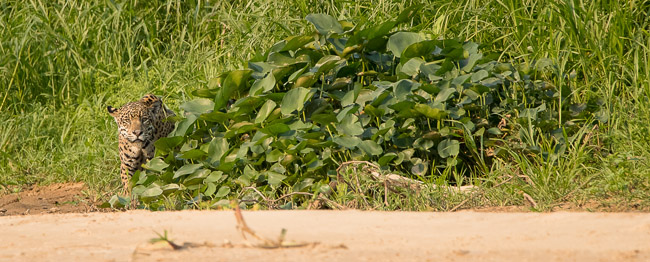
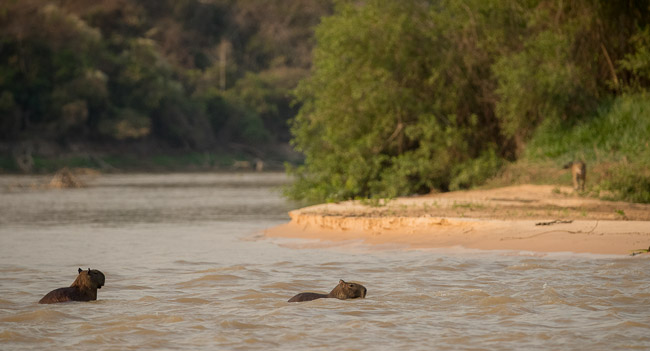
Eventually the Jaguar reached a stretch of sandy beach where everyone had clear views, and where a pair of Capybaras swam close to shore, in view of the cat. The Jaguar began a stalk, then settled behind a shoreline bush. When it arose again, the Capybaras spotted the cat and began giving alarm barks, and the Jaguar turned and retraced his steps.
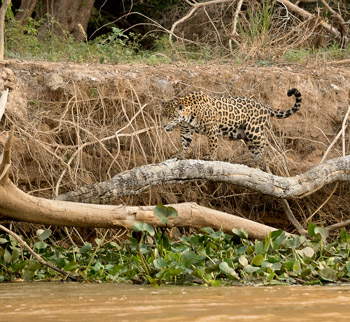 We followed, and again positioned ourselves to be in a good location for the Jaguar if it climbed out onto a log. This time, it did, and the shooting was great. The cat continued upstream, passing a few other likely trees, and entering the water where we waited, but the Jaguar reversed and did not swim right to us – the only boat there.
We followed, and again positioned ourselves to be in a good location for the Jaguar if it climbed out onto a log. This time, it did, and the shooting was great. The cat continued upstream, passing a few other likely trees, and entering the water where we waited, but the Jaguar reversed and did not swim right to us – the only boat there.
Eventually the Jaguar settled itself above the den where they growled and roared, and eventually, one-by-one, dashed out of their den. We never saw the Jaguar, but from the behavior of the otters we suspect it was in the brush just above the den.
As we headed home we had another female Jaguar, in very low light, but we took a few record shots for identification. Cat count – 3 today, 11 for the trip.
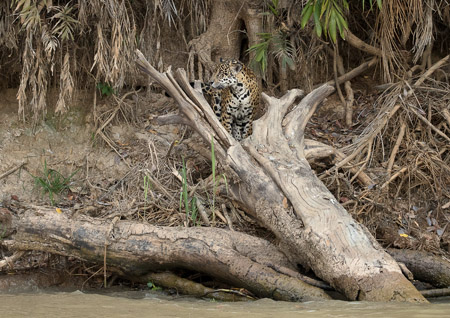
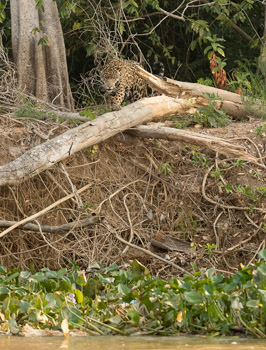
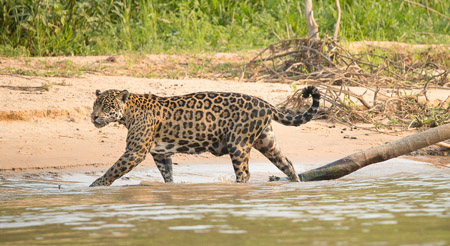
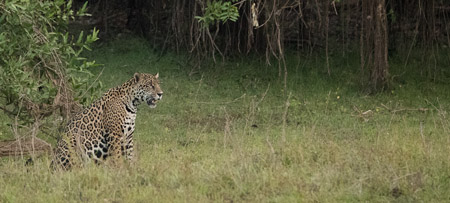
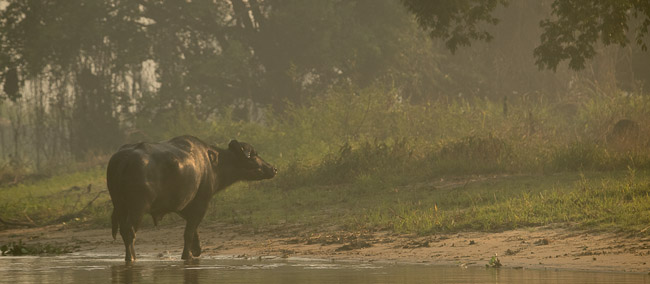
Day 8. Jaguarland to Santa Theresa
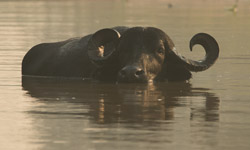 We left at 6 for our last morning on the river. We headed up the Black Lagoon where my boat had one of the best Pied Plovers, a vividly patterned shorebird, I’ve ever had. Several Asiatic Water Buffalo lounged in the lagoon, and we filmed them before heading back, preparing to move up river.
We left at 6 for our last morning on the river. We headed up the Black Lagoon where my boat had one of the best Pied Plovers, a vividly patterned shorebird, I’ve ever had. Several Asiatic Water Buffalo lounged in the lagoon, and we filmed them before heading back, preparing to move up river.
Mary’s boat stopped for a Boat-billed Heron and as she did so, her boatman spotted a Jaguar in the tree roots and deep shadows behind the bird. Eventually the Jaguar got up and moved upriver, giving us a couple of shots before it settled down, hidden from view. More boats arrived and rather than stay on this cat, we moved on to the Three Brothers, hoping for a better cat.
We hadn’t traveled far when we had a much better Jaguar, that walked along the river bank and onto a sandy beach where, to my surprise, it climbed onto a log. A few minutes earlier the female was actively doing flehmen, and I suspect that jumping onto the log was just part of further scent exploration. As she moved about beneath the log I told my group – who were quietly urging her on – that she wouldn’t do it. I was wrong.
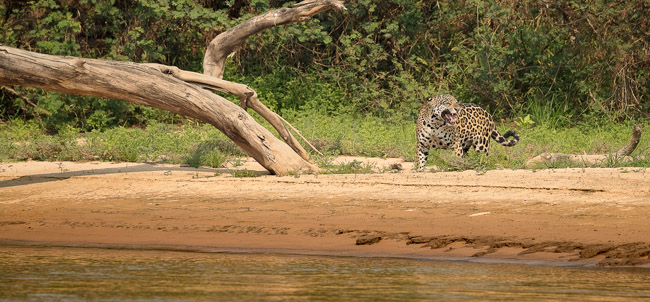
More boats from the Black Lagoon arrived and our cat disappeared, and we moved up river to further explore. I got to see the Prehensile-tailed Porcupine Mary’s group had last evening – far up in a tree and a great spotting on the boatmen’s part, but no shots.
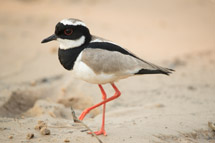 We had to back to the Flotel at 10:30 for a change-over. We arrived on time, and left around 11:15, after a lunch, reaching our bus at Porto Joffre at noon.
We had to back to the Flotel at 10:30 for a change-over. We arrived on time, and left around 11:15, after a lunch, reaching our bus at Porto Joffre at noon.
We arrived at Santa Theresa at 2:45, and at 3 Sam, Scott, David, Randy, and I headed into the forest to get our flashes ready for the evening ocelot shoot. The ladder I needed to set my backlights was gone, so the lighting was a bit ordinary.
Meanwhile, Mary opened up her email and found a disturbing message that upset us greatly. The product of a gross misunderstanding, it almost ruined our day.
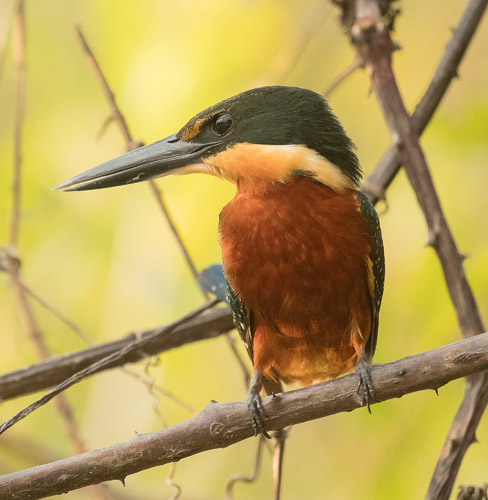

Our evening boat ride, however, was a lot of fun. We had perhaps the best Rufous and Green Kingfisher that permitted a very close approach. After we were finished shooting, no one moved, and we backed out just as quietly as we had approached, and the bird remained on its perch. Mary had a large Treefrog hop into her boat, a pleasant surprise, but the hoped-for Tapir did not appear.
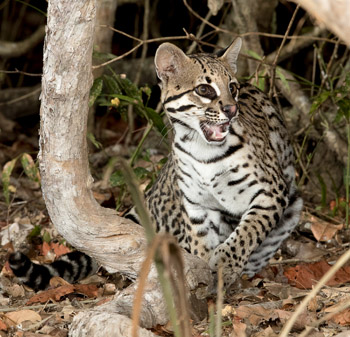
We ended the boat ride back at our lodge where we had scheduled a caparini Sun Downer, celebrating a great trip and Jack and Jan Wyn’s 45th wedding anniversary.
After a very quick dinner we headed to the Ocelot bait station where we set up our flashes before the crowd arrived. Tonight they did not have piranhas, and the bait appeared to be entire chicken feet, which stuck awkwardly out of the cat’s mouth and made shooting difficult. The cat returned to the bait station several times, but the shooting was finished by 8PM.
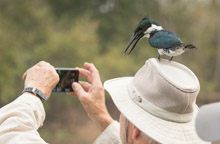
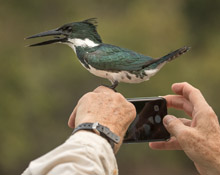
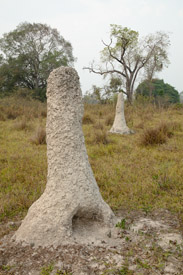 Day 9. Santa Theresa to Pueso Allegre
Day 9. Santa Theresa to Pueso Allegre
I wanted to photograph the large, cone-like Termite Mounds at one end of the property and so I left shortly after sunrise, walking down the dusty road and following fresh Jaguar Tracks. At 7:30 we did our final boat ride, getting good shots of Black-collared Hawks diving for the fish our boatman tossed, as well as Ringed and Amazon Kingfishers. One Amazon is particularly bold, and will land on the bow of the boat awaiting a handout. Several times it perched on the heads or cameras of people as it flew about, finally grabbing fish out of Mary and my hands.
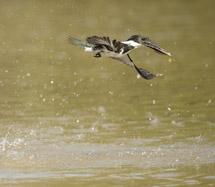
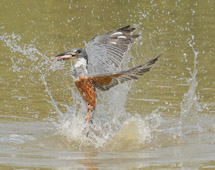
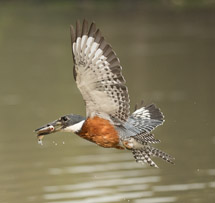
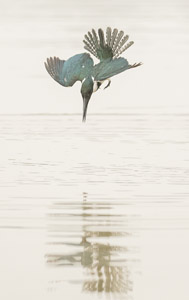 At 10 we were off to our last lodge, Pueso Allegre. Along the way we had a few good opportunities with Marsh Deer, including a large buck in velvet. Power, at ST and here, was out, so the first few hours were shot as we awaited the return of electricity and our afternoon shoot.
At 10 we were off to our last lodge, Pueso Allegre. Along the way we had a few good opportunities with Marsh Deer, including a large buck in velvet. Power, at ST and here, was out, so the first few hours were shot as we awaited the return of electricity and our afternoon shoot.
I stopped along the way to check out the waterhole where I had a Tapir earlier in the season. I was planning on spending the first part of the afternoon in the water, waiting, but the lodge owner feared that other guests might be visiting the water and be upset. So I paced through the afternoon, frustrated, as no one left to visit the waterhole! The AC came back on by 2:45, making what was becoming an extremely hot day tolerable.
PM. At 3:30 we did a truck game-drive, finding both species of Brocket Deer, the Red and the Gray, with only a subtle difference in color 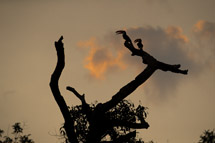 and a slightly larger size in the Red. We had a Crab-eating Fox that paralleled the track, giving us some brief but very good views. A few Coatis and a late evening view of a Giant Anteater completed the day.
and a slightly larger size in the Red. We had a Crab-eating Fox that paralleled the track, giving us some brief but very good views. A few Coatis and a late evening view of a Giant Anteater completed the day.
That night, at 12:30, Randy was still on the internet and was directed to a Giant Anteater that visits the lodge on some nights. A Tapir, and Crab-eating Fox, also appeared.
Day 10. Pueso Allegre
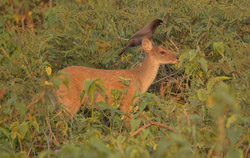 Our super enthusiastic guide wanted us to leave at 4:30AM for a game drive, but with the smoky smog the light would be low until well after sunrise. Instead, we headed out at 5:30, predawn, but with shoot-able light. The pre-breakfast drive offered more deer, including a first -- a pair of Purple Jays picking ticks off a Brocket Deer. Scott, Randy, and David followed Marcus on a guest for Marmosets (they saw two shy ones), and a great encounter with Black-capped Capuchin Monkeys.
Our super enthusiastic guide wanted us to leave at 4:30AM for a game drive, but with the smoky smog the light would be low until well after sunrise. Instead, we headed out at 5:30, predawn, but with shoot-able light. The pre-breakfast drive offered more deer, including a first -- a pair of Purple Jays picking ticks off a Brocket Deer. Scott, Randy, and David followed Marcus on a guest for Marmosets (they saw two shy ones), and a great encounter with Black-capped Capuchin Monkeys.
Meanwhile, I went out to the waterhole where I constructed, out of bamboo, a lean-to blind to protect me from the sun and to break up my outline as I sat on a plastic water jug up to my waist at the waterhole. I was hoping that a Tapir one come down to the open water and I’d shoot it at eye-level, but the Tapir never appeared.
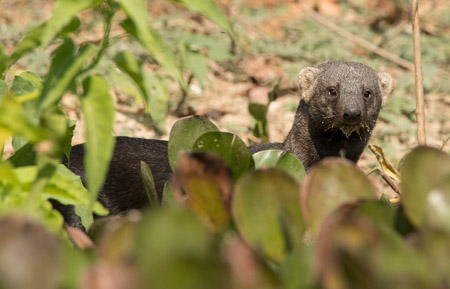 Instead, ten minutes after Mary and our driver left (Mary helped get me set up), a Tayra, the largest tropical weasel in South America, trotted into view. Unfortunately I was aimed about 90 degrees to the right, and the Tayra bobbed and weaved in full view as it tried to figure out what I was. Eventually it ran along to the opposite bank – where I was aimed – and I got some headshots, the best views I’ve ever had of the animal.
Instead, ten minutes after Mary and our driver left (Mary helped get me set up), a Tayra, the largest tropical weasel in South America, trotted into view. Unfortunately I was aimed about 90 degrees to the right, and the Tayra bobbed and weaved in full view as it tried to figure out what I was. Eventually it ran along to the opposite bank – where I was aimed – and I got some headshots, the best views I’ve ever had of the animal.
Honeybees buzzed the shallows and I was a bit concerned I’d be bothered, but in the shade of my blind I was left alone. I wore a leafy camou suit and hood, and I was rather inconspicuous, and birds and vultures often landed close. A Red Brocket Deer came down to drink, again providing great views.
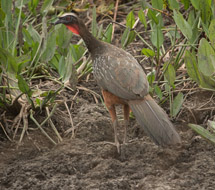
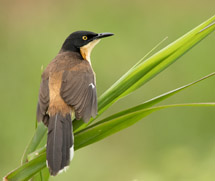
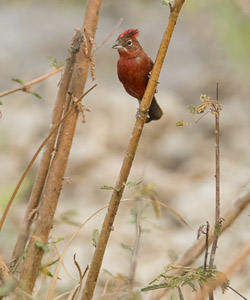
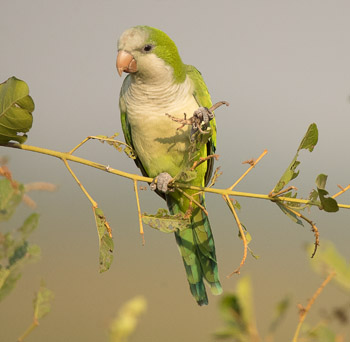 PM. In the afternoon Scott, Marcos, and I set up at an entirely new waterhole, one I’d never been to before. I was worried that conditions would be poor, as I’d have to make our blind in the shade of the forest, but as it turned out the conditions were perfect – sunlight hitting the pond, with the three of us in shade.
PM. In the afternoon Scott, Marcos, and I set up at an entirely new waterhole, one I’d never been to before. I was worried that conditions would be poor, as I’d have to make our blind in the shade of the forest, but as it turned out the conditions were perfect – sunlight hitting the pond, with the three of us in shade.
We were set up by 2, but nothing happened until 3 when the first Brocket Deer cautiously approached the water, and finally entered the hyacinth-covered pool for a drink. Unfortunately, soon after another vehicle arrived and the rest of the shoot was destroyed.
Their Brazilian guide positioned the three women so they faced into the sun, and were some distance from the pool. One was dressed in pink, and all three had bare arms, which they waved constantly, pointing at distant birds or swatting insects. If they had expected a mammal to appear with all that movement they were mislead, and no other mammal appeared. We were so well camouflaged that the four did not see us for ten minutes, and then the women moved closer to the water, still standing upright and swinging their very conspicuous arms. We were quite frustrated.
Mary and the rest of the group went to the waterhole and just as they arrived a Tayra ran from the water’s edge. Although the shots were a bit distant Mary and several others got some nice shots – probably the best full-body images yet. Nothing else appeared, and with some reluctance Mary and the group headed out to pick the three of us at the blind. As we tore down and carried our rig to the truck I avoided any eye-contact, hoping our displeasure was evident. Later, their Brazilian guide apologized to Mary for blowing our shoot – although she wasn’t there, and he said nothing to those that were. Interestingly, the guide was Marcos’s former boss, and there’s a lot of jealousy on the guide’s part.
We headed out, looking for more anteaters but without success, and finished the evening reviewing the trip highlights and favorite images, drinking caparinis and having a great last evening.
A Final Portfolio
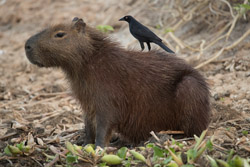
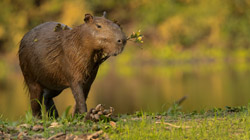
Capybaras - with a Giant Cowbird; with a plant stem
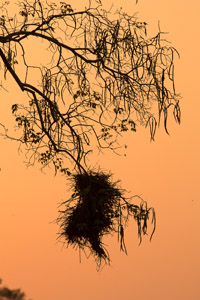
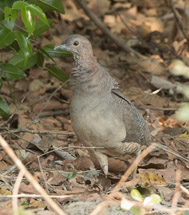
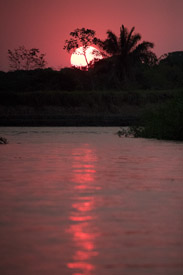
Spine-tail nest; Undulating Tinamou; Sunset
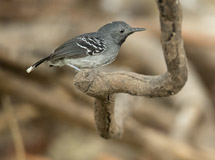
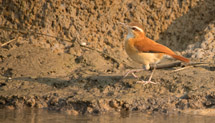
Band-tailed Antbird; Pale-legged Hornero
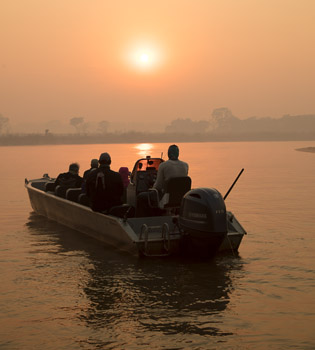
Sunrise
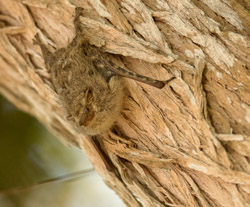
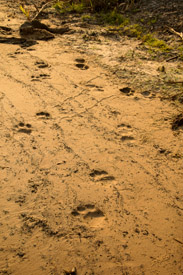
River Bat; Jaguar tracks
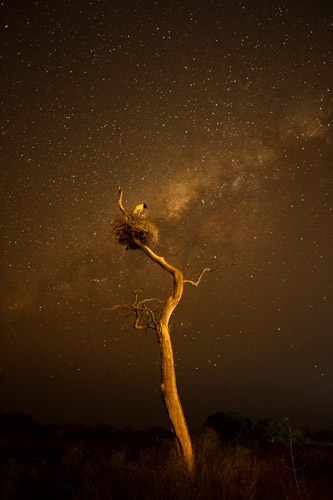
Jabiru Stork Nest and Milky Way
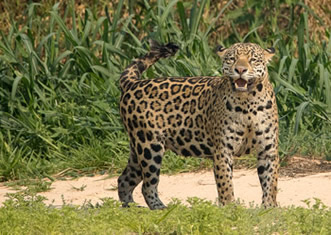
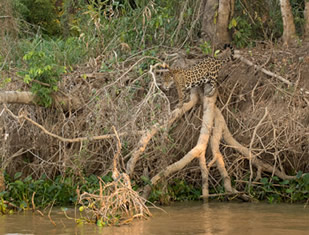
Jaguars
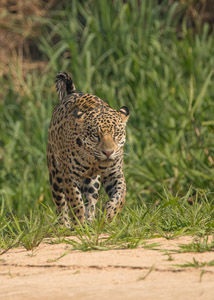
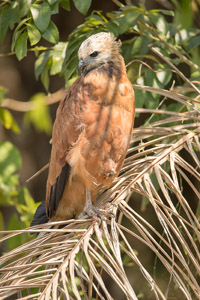
Jaguar; Black-collared Hawk at the Flotel
Why you should travel with us
Testimonials
Read an Interesting Interview with Joe
Read the latest Interview
Join us on Facebook at: Follow Hoot Hollow
Office Phone: (717) 543-6423
Or FAX us at: (717) 543-5342
Mary and Joe are proud to endorse the Photo Retailer that has
done the absolute most in supporting nature photography in all
its facets ---

Check out their Monthly Specials
and Alan Samiljan's Specials from Hunt's


Jaguars and the Wildlife of the Pantanal
September 2017
Trip Report
This was our third Photo Tour to the Pantanal for 2017, and Mary and I were probably more excited about doing this trip than all the others, because we knew how good the 2017 Year was stacking up to be. We were not disappointed.
 We had at least 16 Jaguars, two opportunities for Ocelots, where we were quite successful, and our best encounters, ever, for Brazilian Tapir and Giant Otters. We found two active dens, and at one we were treated to witness as the female swam with her 10 day old pups, still with their eyes closed, to a new den. At another den, we watched as pups just a few days older made what might have been their first swim and exploration outside the den.
We had at least 16 Jaguars, two opportunities for Ocelots, where we were quite successful, and our best encounters, ever, for Brazilian Tapir and Giant Otters. We found two active dens, and at one we were treated to witness as the female swam with her 10 day old pups, still with their eyes closed, to a new den. At another den, we watched as pups just a few days older made what might have been their first swim and exploration outside the den.
Until this year, tree-climbing with Jaguars was rarely observed, but on our first full-day in Jaguarland we had a great female Jaguar sprawled out along a limb about 14 feet above the lagoon. We had two other Jaguars that climbed up or out onto fallen logs, giving us classic shots.

Male Brocket Deer from my water-level blind
I even tried something new that I'm hoping to incorporate into next year's shoot, and that's being close to some waterholes, camouflaged by netting and camou clothing. I spent a morning in one of these make-shift blinds I built, and I loved the experience.
Finally, this trip was special as it was composed of old friends that have traveled with us many times before, and we not only had great shooting but we had an enormous amount of fun as well.
N ext year, we're planning on two trips to the Pantanal, and despite the claims of some of our competitors, no one offers more diversity or knows the Pantanal, its wildlife, and the natural history of the wildlife than do we. Join us next year for an experience of a lifetime!
ext year, we're planning on two trips to the Pantanal, and despite the claims of some of our competitors, no one offers more diversity or knows the Pantanal, its wildlife, and the natural history of the wildlife than do we. Join us next year for an experience of a lifetime!
Sao Paulo
Hurricane Irma threatened to devastate Florida, and the threat of airport closures throughout the South caused disruptions for nearly everyone. Mary, Sam, and I were scheduled to fly out of Atlanta on Monday, giving us one full day in Sao Paulo for insurance – in case of weather! Instead, we were able to reschedule our flight and we left on Sunday, giving us two days in Sao Paulo … where we relaxed. Although we did office work and writing, the schedule was not as hectic as our Sunday would have been at home.
Everyone arrived on time, with the exception of one where American Airlines continued to cancel flights. Fortunately, though, only one day was missed.
 Day 1 Cuiaba to Santa Theresa
Day 1 Cuiaba to Santa Theresa
After arriving in Cuiaba and having lunch as a typical, meaning an over-the-top meat fest, barbeque, we headed toward the Pantanal and our first destination, South Wild’s Santa Theresa ranch. As we always do, we prepped everyone that we’d be driving fairly direct, as most everything we’d see we’d get better later. If there was something extraordinary, we’d stop. And we did!
Halfway between Pueso Allegre and ST I spotted a Brazilian Tapir feeding on water plants at a large roadside canal. It was nearing 5PM, still with plenty of light, and as the bus came to a long, slow stop and backed  up, the Tapir remained. Nearly everyone got a few shots before it spooked and exited the pond, but after walking parallel to the shoreline for a few yards the Tapir reentered the pond, giving a great view, and shots, as it did so. The Tapir swam for several yards, then veered back to the opposite bank where it climbed out and headed through the brush back to the forest. This was a first, something we’ve never seen from the Transpantaneira Highway before, and a great omen.
up, the Tapir remained. Nearly everyone got a few shots before it spooked and exited the pond, but after walking parallel to the shoreline for a few yards the Tapir reentered the pond, giving a great view, and shots, as it did so. The Tapir swam for several yards, then veered back to the opposite bank where it climbed out and headed through the brush back to the forest. This was a first, something we’ve never seen from the Transpantaneira Highway before, and a great omen.
Day 2 – Santa Theresa
 Prior to breakfast several of us made visits to the Jabiru Stork viewing tower where the adults performed, returning repeatedly with bill’s full of sticks to replenish their huge nest. The chicks, chicken-size when we left them 3 weeks ago, are now nearly half the size of the adults. Hummingbirds – at least two, but perhaps as many as six species, visited a flowering tree beside the lodge, and Caracaras, Kiskadees, and Pigeons fed at the feeder.
Prior to breakfast several of us made visits to the Jabiru Stork viewing tower where the adults performed, returning repeatedly with bill’s full of sticks to replenish their huge nest. The chicks, chicken-size when we left them 3 weeks ago, are now nearly half the size of the adults. Hummingbirds – at least two, but perhaps as many as six species, visited a flowering tree beside the lodge, and Caracaras, Kiskadees, and Pigeons fed at the feeder.
After breakfast we did our usual boat ride, for Ringed Kingfishers and Black-collared Hawks. The Hawks were sparse – we had two come in for fish, but those two opportunities were very good ones, with birds swooping in from the side, making it easy to follow and focus. One Great Black Hawk watched us from a tree, but never went for a fish.
All of us did very well with Ringed Kingfishers. Sometimes two birds would fly in at the same time, surprising us by appearing out of nowhere. The light was good, and the boats positioned well. The tame Amazon Kingfisher landed on Sam’s head – he was wearing a hat, and later grabbed a fish out of my hand.

We traveled far upstream to where Giant Otters are quite tame, and we had two that swam around our boats. One looked quite old, with pink patches around his eyes. En route, we passed a lone Otter, which I thought was a Neotropical Otter, but that identification is just speculation.
 The morning highlight, though, was the Agami Heron, the most beautiful of the Western Hemisphere Herons, a bird with electric blue colors and a disproportionately long beak. We shot it in the open, a very rare occurance, at a location we’d never had them at before.
The morning highlight, though, was the Agami Heron, the most beautiful of the Western Hemisphere Herons, a bird with electric blue colors and a disproportionately long beak. We shot it in the open, a very rare occurance, at a location we’d never had them at before.
Returning at 10:45, we headed to the Ocelot blind for those with multiple flashes to have time to set up and position the flashes for the night’s shooting. That took over an hour and a half, and we returned late for lunch, hot and sweaty and tired.

PM. At 3PM we headed downriver, passing where, at 8AM this morning and just out of sight of us as we set off on our morning boat ride, a Jaguar had grabbed a Capybara and carried it into the forest. One of South Wild’s drivers saw it happen, and may have shot a cell phone image of an event that may have lasted seconds.
We had several highlights, including very close shots of Green Kingfisher, Capybaras nursing and with cowbirds and Cattle Tyrants riding the rodents, and a Great Black Hawk that waited for us to toss it a fish. There were too many Water Hyacinths about, so our boatman tossed a fish onto the open river bank and the hawk swooped down and consumed it there, in beautiful light and completely in the open. The Great Potoo, an incredibly cryptic nightjar relative, was visible and worth the shore hike to reach this bird in good light.


Great Potoo, showing the camouflage and the detail


Great Black Hawk; Limpkin

As we returned to the lodge we encountered a Tapir – this stretch of river has often had them. The Tapir, instead of exiting at its nearest shore, swam across the small river right in front of us before gaining the shoreline and galloping into the woods. I used the Tamron 150-600 on a monopod and the images were sharp!
After dinner he headed to the Ocelot blind, getting there a few minutes early to  turn on the flashes and confirm exposures. Doing so with everyone was a bit noisy, and Marcos worried that we may have frightened off the cat. Once we settled in, we waited for ten minutes, a nerve-wracking time as I worried, but soon Mary spotted an Ocelot coming in from the right. The same Ocelot returned several times, sometimes pausing to look intently into the forest. We wondered if there was another Ocelot, or if it sensed the Jaguar that had laid tracks along this trail yesterday. After 1.5 hours the food was done and we took down the flashes. I stayed with Marcos an extra ten minutes, in the dark, hoping the cat would return so that we could do some video without flashes firing. The cat returned, for two quick checks of the area, and then vanished for good.
turn on the flashes and confirm exposures. Doing so with everyone was a bit noisy, and Marcos worried that we may have frightened off the cat. Once we settled in, we waited for ten minutes, a nerve-wracking time as I worried, but soon Mary spotted an Ocelot coming in from the right. The same Ocelot returned several times, sometimes pausing to look intently into the forest. We wondered if there was another Ocelot, or if it sensed the Jaguar that had laid tracks along this trail yesterday. After 1.5 hours the food was done and we took down the flashes. I stayed with Marcos an extra ten minutes, in the dark, hoping the cat would return so that we could do some video without flashes firing. The cat returned, for two quick checks of the area, and then vanished for good.
When I returned, I found Mary and Scott by the river, working on some star shots of the Milky Way. I joined them, and we headed to the Stork nest for a better foreground, and shot some great images where we lightly painted the tree, balancing that with the glowing Milky Way. Beautiful!
Day 3. Santa Theresa to Jaguarland
No one shot this morning as we packed to head to the Flotel, a fortuitous decision since the landscape was shrouded in a smog – fog and smoke, diffusing the light in an-unmotivating way for early light. At 8 we headed out, crossing one bridge that had Mary very nervous as our bus’s tires sank into the rotten wood. After passing by, Marcos, the Driver, and I gathered some planks to shore up what was beginning to look like a very unsafe bridge.
En route we had a 6-7 foot long Yellow Anaconda that stretched across the road, which eventually doubled back, doing a serpentine, looping motion as it raced off. It’s trail showed the more typical locomotion of a constrictor – a caterpillar-like movement where belly scales inch forward, grip, and pull, leaving a track that is essentially a straight line. It’s exit was a series of loops.
 PM. At 3 we headed out, and my boat explored the Black Lagoon while Mary headed up the Charles Creek, where they had some good bird shooting. My boat cruised, heading further upriver than I think I’ve ever gone, but we saw nothing. On our return, I faced backwards, hoping to spot a hidden cat that everyone facing forward might miss. I didn’t, but we received a radio call that a Jaguar was on the Cuiaba River. We raced there, but the cat was gone. While we waited, we had another call, and we raced downriver where Mary’s boat arrived first, and had a brief glimpse. I saw the cat, seconds worth, before it disappeared into the grasses. We waited, as the light increasingly faded, and headed back
PM. At 3 we headed out, and my boat explored the Black Lagoon while Mary headed up the Charles Creek, where they had some good bird shooting. My boat cruised, heading further upriver than I think I’ve ever gone, but we saw nothing. On our return, I faced backwards, hoping to spot a hidden cat that everyone facing forward might miss. I didn’t, but we received a radio call that a Jaguar was on the Cuiaba River. We raced there, but the cat was gone. While we waited, we had another call, and we raced downriver where Mary’s boat arrived first, and had a brief glimpse. I saw the cat, seconds worth, before it disappeared into the grasses. We waited, as the light increasingly faded, and headed back
Mary had left five minutes earlier and on the Piquiri River she spotted a new Jaguar, a nursing female – teats were visible in her shot – but the cat only stayed in the open for a few minutes before disappearing. My boat, following behind, missed it.
As we neared the Flotel at 6 the atmosphere above the Flotel was thick with hanging with smoke.


Day 4. Jaguarland
Five Jaguars today! Surprisingly, an Arctic Front blew in during the night and we started our boat ride under windy, quite cool, and overcast conditions. I wondered if it would rain, and having a cold front this late in the season was completely unexpected.

We were barely to the Cuiaba River juncture when we received a radio call about a Jaguar. We doubled back, to find a Jaguar stalking on the top of one of the high riverbanks, with a family of Capybara about thirty yards away. The cat was in a serious, slow stalk, but the wind must have wafted scent to the rodents as they constantly barked alarm calls, based I’m sure on scent since they could not see the cat. Eventually they must have gotten a real nose-full, as they dashed into the river. The Jaguar walked towards them, then disappeared into the forest.
Soon we had another call, for a Jaguar on the Three Brothers. As we approached the pile up of boats I kept looking at the shorelines, since there’s always the chance that another cat might be there that people miss in a hurry to get to a sighted cat. Apparently the Jaguar causing the pile up had disappeared, but I spotted it about 300 yards downriver as we passed. We stopped, and got a few shots before the Jaguar moved into the brush. We followed it downriver, seeing its silhouette now and then, but no other shots.
 Another radio call – this time at the Black Lagoon. We headed there, to find a cat curled up along a clearing beside a side channel where we’ve often seen Jaguars. The cat was in the open and presented several pose through the morning, and at one point started hunting, moving down the stream bank and into the grasses, straight towards our boat. The cat kept coming, until she was just 25 or so feet away, close enough that I advised my
Another radio call – this time at the Black Lagoon. We headed there, to find a cat curled up along a clearing beside a side channel where we’ve often seen Jaguars. The cat was in the open and presented several pose through the morning, and at one point started hunting, moving down the stream bank and into the grasses, straight towards our boat. The cat kept coming, until she was just 25 or so feet away, close enough that I advised my  people – Sam, Scott, Sue, and David, that if the cat tried climbing into the boat, don’t panic and don’t move. Why she would do that I had no idea, so I was fairly sure she wouldn’t, but I still was relieved when she turned and hunted away from us.
people – Sam, Scott, Sue, and David, that if the cat tried climbing into the boat, don’t panic and don’t move. Why she would do that I had no idea, so I was fairly sure she wouldn’t, but I still was relieved when she turned and hunted away from us.
About that time we had another radio call that another Jaguar on the Black Lagoon – we’d searched for it earlier, was now in a tree. When we arrived there was a large boat jam, and I was sure we’d be out of position but our boatman, a miracle worker, slipped into a spot and we had, I’m convinced, the best view. The cat was twenty feet off the water, lying on a tree limb like a Serengeti Leopard, and periodically slept or looked about.
Then, a woman with a pro video camera got out of her boat on the opposite shoreline, and she and her guide walked to the shore opposite the cat. It was sleeping, we suspect, and didn’t see her, but her action caused another boat of tourists to do likewise, and sure enough, soon the  cat spotted them and slunk down the tree and out of sight.
cat spotted them and slunk down the tree and out of sight.
A few minutes later I had a chance to explain to the tourists how their action impacted the cat and screwed it up for everyone. I was surprisingly low key. Another pro photographer, a good friend, was also there with his group and as he passed them, he reinforced my message – a bit more forcefully this time. I felt like good cop/bad cop.
We headed back to our cat, and resumed the vigil. At 1PM Mary took one group back to the Flotel for lunch, while I stayed with my group and Randy, who joined us. Not much happened, and Mary returned with lunches for all of us, and beer!
PM. At 3 we decided to look for more cats, as our’s now went hunting, and then settled down out of sight. We headed up the Three Brothers, finding nothing, but as we headed back we had another call, and we reversed, spotting our 5th cat but there were no shots.
Mary’s group had a great encounter with Giant Otters, including a baby that tried stealing fish from its parents. It was a great show.


We had the prime position for much of the action, but the number of boats was huge! Interestingly, we met a couple of guys who were about to go to 'Jaguarland' and said they would observe 'radio silence' and not stop if there were other boats at a Jaguar. They expected to see 7-8 cats a day, and they were a bit disappointed when I explained the reality of the shooting.

At Santa Theresa we have the river to ourselves, as we shoot mammals and birds.
 Day 5. Jaguarland
Day 5. Jaguarland
We had clear skies last night and this morning, as expected, it was cold, although not as frigid as we experienced earlier in the year. We headed toward the Black Lagoon, hoping to have Caimans doing the bubble dance. I saw nor heard any Caimans displaying. However, we had a very cooperative juvenile Caiman with a large armored Catfish that turned towards us – rather than facing the shoreline as they usually do – and after a several minute  wait, began chomping down the surprisingly large fish.
wait, began chomping down the surprisingly large fish.
Later, we had another Caiman with another Catfish with a Coqui Heron nearby. At first, I thought the Heron might be plotting on stealing the catfish, but although it often came close, and was obviously tied in with the Caiman, I think it was ready to grab any fish attracted by the feeding. Eventually the Caiman swallowed the fish and the two separated.
Mary did very well on filling in portfolios for people, getting Great Black Hawk, Green Kingfisher, Long-nosed Bats (later, I did,  too), and several others. Ironically, I had motored up the Charles Creek too, but the area was rather barren when we passed.
too), and several others. Ironically, I had motored up the Charles Creek too, but the area was rather barren when we passed.
As we headed further upriver I spotted another Jaguar, lying in the deep shade of a river bank. Our boatman got on the radio and soon about 15 boats were there, indicating no other Jaguar had been seen that morning. Before the other boats arrived the cat got up and moved down to the shoreline for some nice images, and afterwards it disappeared.
 Later, we think the same Jaguar was reported. This time we paralleled the Jaguar for a long time, finally positioning ourselves at a sand bar where we hoped the cat would come to drink. It didn’t, but the cat did come into the open here, backlighted against the brilliant sand. I suggested people open up 1.7 stops off the sand – the cat was still dark, but nothing was clipped and I suspect the shots will be OK.
Later, we think the same Jaguar was reported. This time we paralleled the Jaguar for a long time, finally positioning ourselves at a sand bar where we hoped the cat would come to drink. It didn’t, but the cat did come into the open here, backlighted against the brilliant sand. I suggested people open up 1.7 stops off the sand – the cat was still dark, but nothing was clipped and I suspect the shots will be OK.
By 11 it seemed as if the Jaguar had settled down, and was hidden, and we headed back to the Flotel for lunch.
NOTE: The two Jaguars this morning were two different individuals.
PM. We left at 2:30 as the afternoon still had some coolness from the front. Mary stopped for Black Vultures at the sandy beach, hoping the birds would bathe, and while there had a great nearly one hour session with White-winged Swallows, with adults feeding fledglings on a branch. Frequently the parent would land on the baby’s back to feed. Bees and dragonflies were fed. Meanwhile, my boat headed up the Cuiaba River where I had the mother Jaguar and cub. We saw no cats.
When we returned to the Three Brothers, Mary’s boat was anchored at a Giant Otter den.



The adults and one baby were playing and wrestling. My boat arrived late, but moved up, too, hoping for some action. The otters swam off, then returned to the den, and then moved upstream where they ran into a new den. We thought the action was over when suddenly the Otters dashed out of the den, too unexpected for anyone to get a shot. The otters moved back to the original den, and then, again to our surprise, an otter headed back out and upriver. We didn’t notice it until it was too late – the Otter was carrying a 10 day old pup, still with its closed!  A few minutes later the Otter emerged, headed back down to the den, and grabbed another pup. In all, she returned with four pups, and after depositing the last one, she remained in the den.
A few minutes later the Otter emerged, headed back down to the den, and grabbed another pup. In all, she returned with four pups, and after depositing the last one, she remained in the den.
Another Jaguar radio call had us racing up river to the exact location where we had our second Jaguar this morning. We followed her downriver – amidst probably every boat on the river, and, at one point, the Jaguar came out onto a sand bank (down river from where I was waiting) where Mary’s boat had just moved, and they got the cat as it moved down to the water to drink. The cat continued to move downstream and my boat, and Mary’s, were able to get in front of, or parallel, for multiple shooting sequences. Eventually the Jaguar moved back into the forest and we headed for home.


There are Jaguars here, can you see them?
Day 6. Jaguarland
This morning was one of those slow, luckless times that is simply a part of field work. My boat, in the Black Lagoon, had a Cattle Tyrant on a spine-tail bird’s nest, and nothing else until 11AM when we had a male Howler Monkey hanging by its tail as it picked fruit.
Mary did a bit better, having a troop of Howler Monkeys and some good views of both the females and the male, and a great Prehensile-tailed Porcupine. Other than that, however, it was an effort to stay awake.
We cruised everywhere – up the Black Lagoon, the Charles, far up the Cuiaba, but there was nothing worthwhile to photograph. Sure, we could have shot some Coqui Herons and some perched Terns, but even those subjects were not presenting anything unique. It really was slow.
 PM. We left at 3, with a reported sleeping Jaguar at the Black Lagoon. Twenty-some boats were already waiting for the cat, which was lying beneath a tree in deep shade. Another report of a Jaguar on the Cuiaba had us racing there – as much to escape the heat – but when we arrived the cat was gone.
PM. We left at 3, with a reported sleeping Jaguar at the Black Lagoon. Twenty-some boats were already waiting for the cat, which was lying beneath a tree in deep shade. Another report of a Jaguar on the Cuiaba had us racing there – as much to escape the heat – but when we arrived the cat was gone.
Mary returned to the Lagoon, where in the late light of day the Jaguar walked along the shoreline for some great shots.
My boat headed up the Three Brothers to check out the Prehensile-tailed Porcupine, which was now closer than it had been in the morning, and with our boatman cutting the engine we got some great shots. Virtually everyone else was at the Lagoon so we headed upriver, hoping to find a Jaguar for ourselves. We did not.
However, upriver from the San Pedro, we discovered a new Giant Otter den. Four or five babies were just coming out to explore, their eyes barely open. Periodically one or more adults would swim in to the den, a series of tree roots, and lead them  out, finally attempting to have them clamber a steep, slick clay bank where another den was located. One of the adults grabbed a baby and carried it up, while the others still pawed and scraped, finally giving up and returning to the original den under the roots. We left then, figuring that this was one of the pups first outings, and we’d give them time to explore their world without the distraction or worry of a boat nearby.
out, finally attempting to have them clamber a steep, slick clay bank where another den was located. One of the adults grabbed a baby and carried it up, while the others still pawed and scraped, finally giving up and returning to the original den under the roots. We left then, figuring that this was one of the pups first outings, and we’d give them time to explore their world without the distraction or worry of a boat nearby.
As we headed home the river was filled at times with swooping Fishing Bats, but we recognized the opportunity too late for ‘bat baseball’ with our flashes. Mary finished the day with a Capybara family on a sunset beach, roosting egrets, and a sunset.
Day 7. Jaguarland
We left at 5:45 with the air still cool from what is left of the cold front. We headed up the Cuiaba River, hoping to find Jaguars here where there’s a bit less boat traffic. We did not.
We had a real first, a pair of Mating Giant Otters! The shooting was difficult, just writhing bodies periodically surfacing, and occasionally two heads, but a lot of growling and yelps, and the entire time we were with them – 16 minutes, did not account for whatever occurred before we arrived.
Except for an angry Large-billed Tern that followed my boat for 100 yards, and then dive-bombed Mary’s boat as she passed, the bird activity was slow. We did have a floating diner however, a dead Caiman floating belly-up with a Black Vulture riding along, picking at the flesh. At one point the carcass drifted within an arm’s length of our boat, and the Vulture stayed.

Heading down the side channel to the Three Brothers River we had a Golden Tegu that had raided an Iguana nest. When we arrived it was carrying the egg, but after finished one it returned to the nest hole, went inside, and emerged with a second egg. We were hoping for a third but the lizard, after finishing the egg, wandered off into the forest.
Mary’s boat went up the Pedersen channel where they had our family of Otters from last evening, now feeding on fish and attracting a Caiman that would grab the left-overs. A Coqui Heron stalked about, like the one we had in the Lagoon, perhaps looking to pick off fish attracted by the bits. Mary’s boat also had another Porcupine, which is truly exceptional since that makes only the third we’ve ever seen.
 As we headed downriver we came upon a Jaguar jam, one we think we’d received a radio call over an hour earlier. My boatman suggested we continue. We had just entered the Black Lagoon when the Otter family that dens nearby swam passed, and I suggested we follow them to the den. I had my directions wrong – the den was further than I thought, and as I discovered this we did a U turn and headed back up the Lagoon,
As we headed downriver we came upon a Jaguar jam, one we think we’d received a radio call over an hour earlier. My boatman suggested we continue. We had just entered the Black Lagoon when the Otter family that dens nearby swam passed, and I suggested we follow them to the den. I had my directions wrong – the den was further than I thought, and as I discovered this we did a U turn and headed back up the Lagoon,
We were about a third of the way in when I spotted a Jaguar lying across a tree route. River vines blocked the area for a wide view so we moved in closer, and the cat got up and climbed down to the river bank directly below the tree – right in front of us! We were the only ones here, but after our boatman radioed Mary’s boat we were soon joined by about 15 other boats. Fortunately we were able to maintain the prime position that we deserved, having found the cat.
 Eventually the Jaguar got up and moved about, first doing the flehmen scent-tasting pose, then moving downstream where, at one point, it chased an Agouti that fled into the water. The Jaguar followed, and returned three times, moving through the river grasses and eventually catching the rodent. David got a shot of the Jaguar as it chased the Agouti, and Jack got a shot as it carried the Agouti into the forest. Now 12:45, we headed back for lunch.
Eventually the Jaguar got up and moved about, first doing the flehmen scent-tasting pose, then moving downstream where, at one point, it chased an Agouti that fled into the water. The Jaguar followed, and returned three times, moving through the river grasses and eventually catching the rodent. David got a shot of the Jaguar as it chased the Agouti, and Jack got a shot as it carried the Agouti into the forest. Now 12:45, we headed back for lunch.
 PM. We left at 3PM and raced towards the Chiaba River where a Jaguar had been reported. We arrived as the cat was still walking along the river’s edge, with five Giant Otters mid-stream, screaming their complaints. As we later discovered, the Jaguar was walking right passed their den.
PM. We left at 3PM and raced towards the Chiaba River where a Jaguar had been reported. We arrived as the cat was still walking along the river’s edge, with five Giant Otters mid-stream, screaming their complaints. As we later discovered, the Jaguar was walking right passed their den.
The Jaguar moved downstream, rounding a bend and moving downriver. We anticipated spots we were expected the Jaguar to appear, and hopefully climb out onto a log, but the latter did not occur, at that time. 

Eventually the Jaguar reached a stretch of sandy beach where everyone had clear views, and where a pair of Capybaras swam close to shore, in view of the cat. The Jaguar began a stalk, then settled behind a shoreline bush. When it arose again, the Capybaras spotted the cat and began giving alarm barks, and the Jaguar turned and retraced his steps.
 We followed, and again positioned ourselves to be in a good location for the Jaguar if it climbed out onto a log. This time, it did, and the shooting was great. The cat continued upstream, passing a few other likely trees, and entering the water where we waited, but the Jaguar reversed and did not swim right to us – the only boat there.
We followed, and again positioned ourselves to be in a good location for the Jaguar if it climbed out onto a log. This time, it did, and the shooting was great. The cat continued upstream, passing a few other likely trees, and entering the water where we waited, but the Jaguar reversed and did not swim right to us – the only boat there.
Eventually the Jaguar settled itself above the den where they growled and roared, and eventually, one-by-one, dashed out of their den. We never saw the Jaguar, but from the behavior of the otters we suspect it was in the brush just above the den.
As we headed home we had another female Jaguar, in very low light, but we took a few record shots for identification. Cat count – 3 today, 11 for the trip.





Day 8. Jaguarland to Santa Theresa
 We left at 6 for our last morning on the river. We headed up the Black Lagoon where my boat had one of the best Pied Plovers, a vividly patterned shorebird, I’ve ever had. Several Asiatic Water Buffalo lounged in the lagoon, and we filmed them before heading back, preparing to move up river.
We left at 6 for our last morning on the river. We headed up the Black Lagoon where my boat had one of the best Pied Plovers, a vividly patterned shorebird, I’ve ever had. Several Asiatic Water Buffalo lounged in the lagoon, and we filmed them before heading back, preparing to move up river.
Mary’s boat stopped for a Boat-billed Heron and as she did so, her boatman spotted a Jaguar in the tree roots and deep shadows behind the bird. Eventually the Jaguar got up and moved upriver, giving us a couple of shots before it settled down, hidden from view. More boats arrived and rather than stay on this cat, we moved on to the Three Brothers, hoping for a better cat.
We hadn’t traveled far when we had a much better Jaguar, that walked along the river bank and onto a sandy beach where, to my surprise, it climbed onto a log. A few minutes earlier the female was actively doing flehmen, and I suspect that jumping onto the log was just part of further scent exploration. As she moved about beneath the log I told my group – who were quietly urging her on – that she wouldn’t do it. I was wrong.

More boats from the Black Lagoon arrived and our cat disappeared, and we moved up river to further explore. I got to see the Prehensile-tailed Porcupine Mary’s group had last evening – far up in a tree and a great spotting on the boatmen’s part, but no shots.
 We had to back to the Flotel at 10:30 for a change-over. We arrived on time, and left around 11:15, after a lunch, reaching our bus at Porto Joffre at noon.
We had to back to the Flotel at 10:30 for a change-over. We arrived on time, and left around 11:15, after a lunch, reaching our bus at Porto Joffre at noon.
We arrived at Santa Theresa at 2:45, and at 3 Sam, Scott, David, Randy, and I headed into the forest to get our flashes ready for the evening ocelot shoot. The ladder I needed to set my backlights was gone, so the lighting was a bit ordinary.
Meanwhile, Mary opened up her email and found a disturbing message that upset us greatly. The product of a gross misunderstanding, it almost ruined our day.


Our evening boat ride, however, was a lot of fun. We had perhaps the best Rufous and Green Kingfisher that permitted a very close approach. After we were finished shooting, no one moved, and we backed out just as quietly as we had approached, and the bird remained on its perch. Mary had a large Treefrog hop into her boat, a pleasant surprise, but the hoped-for Tapir did not appear.

We ended the boat ride back at our lodge where we had scheduled a caparini Sun Downer, celebrating a great trip and Jack and Jan Wyn’s 45th wedding anniversary.
After a very quick dinner we headed to the Ocelot bait station where we set up our flashes before the crowd arrived. Tonight they did not have piranhas, and the bait appeared to be entire chicken feet, which stuck awkwardly out of the cat’s mouth and made shooting difficult. The cat returned to the bait station several times, but the shooting was finished by 8PM.


 Day 9. Santa Theresa to Pueso Allegre
Day 9. Santa Theresa to Pueso Allegre
I wanted to photograph the large, cone-like Termite Mounds at one end of the property and so I left shortly after sunrise, walking down the dusty road and following fresh Jaguar Tracks. At 7:30 we did our final boat ride, getting good shots of Black-collared Hawks diving for the fish our boatman tossed, as well as Ringed and Amazon Kingfishers. One Amazon is particularly bold, and will land on the bow of the boat awaiting a handout. Several times it perched on the heads or cameras of people as it flew about, finally grabbing fish out of Mary and my hands.



 At 10 we were off to our last lodge, Pueso Allegre. Along the way we had a few good opportunities with Marsh Deer, including a large buck in velvet. Power, at ST and here, was out, so the first few hours were shot as we awaited the return of electricity and our afternoon shoot.
At 10 we were off to our last lodge, Pueso Allegre. Along the way we had a few good opportunities with Marsh Deer, including a large buck in velvet. Power, at ST and here, was out, so the first few hours were shot as we awaited the return of electricity and our afternoon shoot.
I stopped along the way to check out the waterhole where I had a Tapir earlier in the season. I was planning on spending the first part of the afternoon in the water, waiting, but the lodge owner feared that other guests might be visiting the water and be upset. So I paced through the afternoon, frustrated, as no one left to visit the waterhole! The AC came back on by 2:45, making what was becoming an extremely hot day tolerable.
PM. At 3:30 we did a truck game-drive, finding both species of Brocket Deer, the Red and the Gray, with only a subtle difference in color  and a slightly larger size in the Red. We had a Crab-eating Fox that paralleled the track, giving us some brief but very good views. A few Coatis and a late evening view of a Giant Anteater completed the day.
and a slightly larger size in the Red. We had a Crab-eating Fox that paralleled the track, giving us some brief but very good views. A few Coatis and a late evening view of a Giant Anteater completed the day.
That night, at 12:30, Randy was still on the internet and was directed to a Giant Anteater that visits the lodge on some nights. A Tapir, and Crab-eating Fox, also appeared.
Day 10. Pueso Allegre
 Our super enthusiastic guide wanted us to leave at 4:30AM for a game drive, but with the smoky smog the light would be low until well after sunrise. Instead, we headed out at 5:30, predawn, but with shoot-able light. The pre-breakfast drive offered more deer, including a first -- a pair of Purple Jays picking ticks off a Brocket Deer. Scott, Randy, and David followed Marcus on a guest for Marmosets (they saw two shy ones), and a great encounter with Black-capped Capuchin Monkeys.
Our super enthusiastic guide wanted us to leave at 4:30AM for a game drive, but with the smoky smog the light would be low until well after sunrise. Instead, we headed out at 5:30, predawn, but with shoot-able light. The pre-breakfast drive offered more deer, including a first -- a pair of Purple Jays picking ticks off a Brocket Deer. Scott, Randy, and David followed Marcus on a guest for Marmosets (they saw two shy ones), and a great encounter with Black-capped Capuchin Monkeys.
Meanwhile, I went out to the waterhole where I constructed, out of bamboo, a lean-to blind to protect me from the sun and to break up my outline as I sat on a plastic water jug up to my waist at the waterhole. I was hoping that a Tapir one come down to the open water and I’d shoot it at eye-level, but the Tapir never appeared.
 Instead, ten minutes after Mary and our driver left (Mary helped get me set up), a Tayra, the largest tropical weasel in South America, trotted into view. Unfortunately I was aimed about 90 degrees to the right, and the Tayra bobbed and weaved in full view as it tried to figure out what I was. Eventually it ran along to the opposite bank – where I was aimed – and I got some headshots, the best views I’ve ever had of the animal.
Instead, ten minutes after Mary and our driver left (Mary helped get me set up), a Tayra, the largest tropical weasel in South America, trotted into view. Unfortunately I was aimed about 90 degrees to the right, and the Tayra bobbed and weaved in full view as it tried to figure out what I was. Eventually it ran along to the opposite bank – where I was aimed – and I got some headshots, the best views I’ve ever had of the animal.
Honeybees buzzed the shallows and I was a bit concerned I’d be bothered, but in the shade of my blind I was left alone. I wore a leafy camou suit and hood, and I was rather inconspicuous, and birds and vultures often landed close. A Red Brocket Deer came down to drink, again providing great views.



 PM. In the afternoon Scott, Marcos, and I set up at an entirely new waterhole, one I’d never been to before. I was worried that conditions would be poor, as I’d have to make our blind in the shade of the forest, but as it turned out the conditions were perfect – sunlight hitting the pond, with the three of us in shade.
PM. In the afternoon Scott, Marcos, and I set up at an entirely new waterhole, one I’d never been to before. I was worried that conditions would be poor, as I’d have to make our blind in the shade of the forest, but as it turned out the conditions were perfect – sunlight hitting the pond, with the three of us in shade.
We were set up by 2, but nothing happened until 3 when the first Brocket Deer cautiously approached the water, and finally entered the hyacinth-covered pool for a drink. Unfortunately, soon after another vehicle arrived and the rest of the shoot was destroyed.
Their Brazilian guide positioned the three women so they faced into the sun, and were some distance from the pool. One was dressed in pink, and all three had bare arms, which they waved constantly, pointing at distant birds or swatting insects. If they had expected a mammal to appear with all that movement they were mislead, and no other mammal appeared. We were so well camouflaged that the four did not see us for ten minutes, and then the women moved closer to the water, still standing upright and swinging their very conspicuous arms. We were quite frustrated.
Mary and the rest of the group went to the waterhole and just as they arrived a Tayra ran from the water’s edge. Although the shots were a bit distant Mary and several others got some nice shots – probably the best full-body images yet. Nothing else appeared, and with some reluctance Mary and the group headed out to pick the three of us at the blind. As we tore down and carried our rig to the truck I avoided any eye-contact, hoping our displeasure was evident. Later, their Brazilian guide apologized to Mary for blowing our shoot – although she wasn’t there, and he said nothing to those that were. Interestingly, the guide was Marcos’s former boss, and there’s a lot of jealousy on the guide’s part.
We headed out, looking for more anteaters but without success, and finished the evening reviewing the trip highlights and favorite images, drinking caparinis and having a great last evening.
A Final Portfolio


Capybaras - with a Giant Cowbird; with a plant stem



Spine-tail nest; Undulating Tinamou; Sunset


Band-tailed Antbird; Pale-legged Hornero

Sunrise


River Bat; Jaguar tracks

Jabiru Stork Nest and Milky Way


Jaguars


Jaguar; Black-collared Hawk at the Flotel
Why you should travel with us
Testimonials
Read an Interesting Interview with Joe
Read the latest Interview
Join us on Facebook at: Follow Hoot Hollow
Office Phone: (717) 543-6423
Or FAX us at: (717) 543-5342
Mary and Joe are proud to endorse the Photo Retailer that has
done the absolute most in supporting nature photography in all
its facets ---

Check out their Monthly Specials
and Alan Samiljan's Specials from Hunt's


Jaguars and the Wildlife of the Pantanal
September 2017
Trip Report
This was our third Photo Tour to the Pantanal for 2017, and Mary and I were probably more excited about doing this trip than all the others, because we knew how good the 2017 Year was stacking up to be. We were not disappointed.
 We had at least 16 Jaguars, two opportunities for Ocelots, where we were quite successful, and our best encounters, ever, for Brazilian Tapir and Giant Otters. We found two active dens, and at one we were treated to witness as the female swam with her 10 day old pups, still with their eyes closed, to a new den. At another den, we watched as pups just a few days older made what might have been their first swim and exploration outside the den.
We had at least 16 Jaguars, two opportunities for Ocelots, where we were quite successful, and our best encounters, ever, for Brazilian Tapir and Giant Otters. We found two active dens, and at one we were treated to witness as the female swam with her 10 day old pups, still with their eyes closed, to a new den. At another den, we watched as pups just a few days older made what might have been their first swim and exploration outside the den.
Until this year, tree-climbing with Jaguars was rarely observed, but on our first full-day in Jaguarland we had a great female Jaguar sprawled out along a limb about 14 feet above the lagoon. We had two other Jaguars that climbed up or out onto fallen logs, giving us classic shots.

Male Brocket Deer from my water-level blind
I even tried something new that I'm hoping to incorporate into next year's shoot, and that's being close to some waterholes, camouflaged by netting and camou clothing. I spent a morning in one of these make-shift blinds I built, and I loved the experience.
Finally, this trip was special as it was composed of old friends that have traveled with us many times before, and we not only had great shooting but we had an enormous amount of fun as well.
N ext year, we're planning on two trips to the Pantanal, and despite the claims of some of our competitors, no one offers more diversity or knows the Pantanal, its wildlife, and the natural history of the wildlife than do we. Join us next year for an experience of a lifetime!
ext year, we're planning on two trips to the Pantanal, and despite the claims of some of our competitors, no one offers more diversity or knows the Pantanal, its wildlife, and the natural history of the wildlife than do we. Join us next year for an experience of a lifetime!
Sao Paulo
Hurricane Irma threatened to devastate Florida, and the threat of airport closures throughout the South caused disruptions for nearly everyone. Mary, Sam, and I were scheduled to fly out of Atlanta on Monday, giving us one full day in Sao Paulo for insurance – in case of weather! Instead, we were able to reschedule our flight and we left on Sunday, giving us two days in Sao Paulo … where we relaxed. Although we did office work and writing, the schedule was not as hectic as our Sunday would have been at home.
Everyone arrived on time, with the exception of one where American Airlines continued to cancel flights. Fortunately, though, only one day was missed.
 Day 1 Cuiaba to Santa Theresa
Day 1 Cuiaba to Santa Theresa
After arriving in Cuiaba and having lunch as a typical, meaning an over-the-top meat fest, barbeque, we headed toward the Pantanal and our first destination, South Wild’s Santa Theresa ranch. As we always do, we prepped everyone that we’d be driving fairly direct, as most everything we’d see we’d get better later. If there was something extraordinary, we’d stop. And we did!
Halfway between Pueso Allegre and ST I spotted a Brazilian Tapir feeding on water plants at a large roadside canal. It was nearing 5PM, still with plenty of light, and as the bus came to a long, slow stop and backed  up, the Tapir remained. Nearly everyone got a few shots before it spooked and exited the pond, but after walking parallel to the shoreline for a few yards the Tapir reentered the pond, giving a great view, and shots, as it did so. The Tapir swam for several yards, then veered back to the opposite bank where it climbed out and headed through the brush back to the forest. This was a first, something we’ve never seen from the Transpantaneira Highway before, and a great omen.
up, the Tapir remained. Nearly everyone got a few shots before it spooked and exited the pond, but after walking parallel to the shoreline for a few yards the Tapir reentered the pond, giving a great view, and shots, as it did so. The Tapir swam for several yards, then veered back to the opposite bank where it climbed out and headed through the brush back to the forest. This was a first, something we’ve never seen from the Transpantaneira Highway before, and a great omen.
Day 2 – Santa Theresa
 Prior to breakfast several of us made visits to the Jabiru Stork viewing tower where the adults performed, returning repeatedly with bill’s full of sticks to replenish their huge nest. The chicks, chicken-size when we left them 3 weeks ago, are now nearly half the size of the adults. Hummingbirds – at least two, but perhaps as many as six species, visited a flowering tree beside the lodge, and Caracaras, Kiskadees, and Pigeons fed at the feeder.
Prior to breakfast several of us made visits to the Jabiru Stork viewing tower where the adults performed, returning repeatedly with bill’s full of sticks to replenish their huge nest. The chicks, chicken-size when we left them 3 weeks ago, are now nearly half the size of the adults. Hummingbirds – at least two, but perhaps as many as six species, visited a flowering tree beside the lodge, and Caracaras, Kiskadees, and Pigeons fed at the feeder.
After breakfast we did our usual boat ride, for Ringed Kingfishers and Black-collared Hawks. The Hawks were sparse – we had two come in for fish, but those two opportunities were very good ones, with birds swooping in from the side, making it easy to follow and focus. One Great Black Hawk watched us from a tree, but never went for a fish.
All of us did very well with Ringed Kingfishers. Sometimes two birds would fly in at the same time, surprising us by appearing out of nowhere. The light was good, and the boats positioned well. The tame Amazon Kingfisher landed on Sam’s head – he was wearing a hat, and later grabbed a fish out of my hand.

We traveled far upstream to where Giant Otters are quite tame, and we had two that swam around our boats. One looked quite old, with pink patches around his eyes. En route, we passed a lone Otter, which I thought was a Neotropical Otter, but that identification is just speculation.
 The morning highlight, though, was the Agami Heron, the most beautiful of the Western Hemisphere Herons, a bird with electric blue colors and a disproportionately long beak. We shot it in the open, a very rare occurance, at a location we’d never had them at before.
The morning highlight, though, was the Agami Heron, the most beautiful of the Western Hemisphere Herons, a bird with electric blue colors and a disproportionately long beak. We shot it in the open, a very rare occurance, at a location we’d never had them at before.
Returning at 10:45, we headed to the Ocelot blind for those with multiple flashes to have time to set up and position the flashes for the night’s shooting. That took over an hour and a half, and we returned late for lunch, hot and sweaty and tired.

PM. At 3PM we headed downriver, passing where, at 8AM this morning and just out of sight of us as we set off on our morning boat ride, a Jaguar had grabbed a Capybara and carried it into the forest. One of South Wild’s drivers saw it happen, and may have shot a cell phone image of an event that may have lasted seconds.
We had several highlights, including very close shots of Green Kingfisher, Capybaras nursing and with cowbirds and Cattle Tyrants riding the rodents, and a Great Black Hawk that waited for us to toss it a fish. There were too many Water Hyacinths about, so our boatman tossed a fish onto the open river bank and the hawk swooped down and consumed it there, in beautiful light and completely in the open. The Great Potoo, an incredibly cryptic nightjar relative, was visible and worth the shore hike to reach this bird in good light.


Great Potoo, showing the camouflage and the detail


Great Black Hawk; Limpkin

As we returned to the lodge we encountered a Tapir – this stretch of river has often had them. The Tapir, instead of exiting at its nearest shore, swam across the small river right in front of us before gaining the shoreline and galloping into the woods. I used the Tamron 150-600 on a monopod and the images were sharp!
After dinner he headed to the Ocelot blind, getting there a few minutes early to  turn on the flashes and confirm exposures. Doing so with everyone was a bit noisy, and Marcos worried that we may have frightened off the cat. Once we settled in, we waited for ten minutes, a nerve-wracking time as I worried, but soon Mary spotted an Ocelot coming in from the right. The same Ocelot returned several times, sometimes pausing to look intently into the forest. We wondered if there was another Ocelot, or if it sensed the Jaguar that had laid tracks along this trail yesterday. After 1.5 hours the food was done and we took down the flashes. I stayed with Marcos an extra ten minutes, in the dark, hoping the cat would return so that we could do some video without flashes firing. The cat returned, for two quick checks of the area, and then vanished for good.
turn on the flashes and confirm exposures. Doing so with everyone was a bit noisy, and Marcos worried that we may have frightened off the cat. Once we settled in, we waited for ten minutes, a nerve-wracking time as I worried, but soon Mary spotted an Ocelot coming in from the right. The same Ocelot returned several times, sometimes pausing to look intently into the forest. We wondered if there was another Ocelot, or if it sensed the Jaguar that had laid tracks along this trail yesterday. After 1.5 hours the food was done and we took down the flashes. I stayed with Marcos an extra ten minutes, in the dark, hoping the cat would return so that we could do some video without flashes firing. The cat returned, for two quick checks of the area, and then vanished for good.
When I returned, I found Mary and Scott by the river, working on some star shots of the Milky Way. I joined them, and we headed to the Stork nest for a better foreground, and shot some great images where we lightly painted the tree, balancing that with the glowing Milky Way. Beautiful!
Day 3. Santa Theresa to Jaguarland
No one shot this morning as we packed to head to the Flotel, a fortuitous decision since the landscape was shrouded in a smog – fog and smoke, diffusing the light in an-unmotivating way for early light. At 8 we headed out, crossing one bridge that had Mary very nervous as our bus’s tires sank into the rotten wood. After passing by, Marcos, the Driver, and I gathered some planks to shore up what was beginning to look like a very unsafe bridge.
En route we had a 6-7 foot long Yellow Anaconda that stretched across the road, which eventually doubled back, doing a serpentine, looping motion as it raced off. It’s trail showed the more typical locomotion of a constrictor – a caterpillar-like movement where belly scales inch forward, grip, and pull, leaving a track that is essentially a straight line. It’s exit was a series of loops.
 PM. At 3 we headed out, and my boat explored the Black Lagoon while Mary headed up the Charles Creek, where they had some good bird shooting. My boat cruised, heading further upriver than I think I’ve ever gone, but we saw nothing. On our return, I faced backwards, hoping to spot a hidden cat that everyone facing forward might miss. I didn’t, but we received a radio call that a Jaguar was on the Cuiaba River. We raced there, but the cat was gone. While we waited, we had another call, and we raced downriver where Mary’s boat arrived first, and had a brief glimpse. I saw the cat, seconds worth, before it disappeared into the grasses. We waited, as the light increasingly faded, and headed back
PM. At 3 we headed out, and my boat explored the Black Lagoon while Mary headed up the Charles Creek, where they had some good bird shooting. My boat cruised, heading further upriver than I think I’ve ever gone, but we saw nothing. On our return, I faced backwards, hoping to spot a hidden cat that everyone facing forward might miss. I didn’t, but we received a radio call that a Jaguar was on the Cuiaba River. We raced there, but the cat was gone. While we waited, we had another call, and we raced downriver where Mary’s boat arrived first, and had a brief glimpse. I saw the cat, seconds worth, before it disappeared into the grasses. We waited, as the light increasingly faded, and headed back
Mary had left five minutes earlier and on the Piquiri River she spotted a new Jaguar, a nursing female – teats were visible in her shot – but the cat only stayed in the open for a few minutes before disappearing. My boat, following behind, missed it.
As we neared the Flotel at 6 the atmosphere above the Flotel was thick with hanging with smoke.


Day 4. Jaguarland
Five Jaguars today! Surprisingly, an Arctic Front blew in during the night and we started our boat ride under windy, quite cool, and overcast conditions. I wondered if it would rain, and having a cold front this late in the season was completely unexpected.

We were barely to the Cuiaba River juncture when we received a radio call about a Jaguar. We doubled back, to find a Jaguar stalking on the top of one of the high riverbanks, with a family of Capybara about thirty yards away. The cat was in a serious, slow stalk, but the wind must have wafted scent to the rodents as they constantly barked alarm calls, based I’m sure on scent since they could not see the cat. Eventually they must have gotten a real nose-full, as they dashed into the river. The Jaguar walked towards them, then disappeared into the forest.
Soon we had another call, for a Jaguar on the Three Brothers. As we approached the pile up of boats I kept looking at the shorelines, since there’s always the chance that another cat might be there that people miss in a hurry to get to a sighted cat. Apparently the Jaguar causing the pile up had disappeared, but I spotted it about 300 yards downriver as we passed. We stopped, and got a few shots before the Jaguar moved into the brush. We followed it downriver, seeing its silhouette now and then, but no other shots.
 Another radio call – this time at the Black Lagoon. We headed there, to find a cat curled up along a clearing beside a side channel where we’ve often seen Jaguars. The cat was in the open and presented several pose through the morning, and at one point started hunting, moving down the stream bank and into the grasses, straight towards our boat. The cat kept coming, until she was just 25 or so feet away, close enough that I advised my
Another radio call – this time at the Black Lagoon. We headed there, to find a cat curled up along a clearing beside a side channel where we’ve often seen Jaguars. The cat was in the open and presented several pose through the morning, and at one point started hunting, moving down the stream bank and into the grasses, straight towards our boat. The cat kept coming, until she was just 25 or so feet away, close enough that I advised my  people – Sam, Scott, Sue, and David, that if the cat tried climbing into the boat, don’t panic and don’t move. Why she would do that I had no idea, so I was fairly sure she wouldn’t, but I still was relieved when she turned and hunted away from us.
people – Sam, Scott, Sue, and David, that if the cat tried climbing into the boat, don’t panic and don’t move. Why she would do that I had no idea, so I was fairly sure she wouldn’t, but I still was relieved when she turned and hunted away from us.
About that time we had another radio call that another Jaguar on the Black Lagoon – we’d searched for it earlier, was now in a tree. When we arrived there was a large boat jam, and I was sure we’d be out of position but our boatman, a miracle worker, slipped into a spot and we had, I’m convinced, the best view. The cat was twenty feet off the water, lying on a tree limb like a Serengeti Leopard, and periodically slept or looked about.
Then, a woman with a pro video camera got out of her boat on the opposite shoreline, and she and her guide walked to the shore opposite the cat. It was sleeping, we suspect, and didn’t see her, but her action caused another boat of tourists to do likewise, and sure enough, soon the  cat spotted them and slunk down the tree and out of sight.
cat spotted them and slunk down the tree and out of sight.
A few minutes later I had a chance to explain to the tourists how their action impacted the cat and screwed it up for everyone. I was surprisingly low key. Another pro photographer, a good friend, was also there with his group and as he passed them, he reinforced my message – a bit more forcefully this time. I felt like good cop/bad cop.
We headed back to our cat, and resumed the vigil. At 1PM Mary took one group back to the Flotel for lunch, while I stayed with my group and Randy, who joined us. Not much happened, and Mary returned with lunches for all of us, and beer!
PM. At 3 we decided to look for more cats, as our’s now went hunting, and then settled down out of sight. We headed up the Three Brothers, finding nothing, but as we headed back we had another call, and we reversed, spotting our 5th cat but there were no shots.
Mary’s group had a great encounter with Giant Otters, including a baby that tried stealing fish from its parents. It was a great show.


We had the prime position for much of the action, but the number of boats was huge! Interestingly, we met a couple of guys who were about to go to 'Jaguarland' and said they would observe 'radio silence' and not stop if there were other boats at a Jaguar. They expected to see 7-8 cats a day, and they were a bit disappointed when I explained the reality of the shooting.

At Santa Theresa we have the river to ourselves, as we shoot mammals and birds.
 Day 5. Jaguarland
Day 5. Jaguarland
We had clear skies last night and this morning, as expected, it was cold, although not as frigid as we experienced earlier in the year. We headed toward the Black Lagoon, hoping to have Caimans doing the bubble dance. I saw nor heard any Caimans displaying. However, we had a very cooperative juvenile Caiman with a large armored Catfish that turned towards us – rather than facing the shoreline as they usually do – and after a several minute  wait, began chomping down the surprisingly large fish.
wait, began chomping down the surprisingly large fish.
Later, we had another Caiman with another Catfish with a Coqui Heron nearby. At first, I thought the Heron might be plotting on stealing the catfish, but although it often came close, and was obviously tied in with the Caiman, I think it was ready to grab any fish attracted by the feeding. Eventually the Caiman swallowed the fish and the two separated.
Mary did very well on filling in portfolios for people, getting Great Black Hawk, Green Kingfisher, Long-nosed Bats (later, I did,  too), and several others. Ironically, I had motored up the Charles Creek too, but the area was rather barren when we passed.
too), and several others. Ironically, I had motored up the Charles Creek too, but the area was rather barren when we passed.
As we headed further upriver I spotted another Jaguar, lying in the deep shade of a river bank. Our boatman got on the radio and soon about 15 boats were there, indicating no other Jaguar had been seen that morning. Before the other boats arrived the cat got up and moved down to the shoreline for some nice images, and afterwards it disappeared.
 Later, we think the same Jaguar was reported. This time we paralleled the Jaguar for a long time, finally positioning ourselves at a sand bar where we hoped the cat would come to drink. It didn’t, but the cat did come into the open here, backlighted against the brilliant sand. I suggested people open up 1.7 stops off the sand – the cat was still dark, but nothing was clipped and I suspect the shots will be OK.
Later, we think the same Jaguar was reported. This time we paralleled the Jaguar for a long time, finally positioning ourselves at a sand bar where we hoped the cat would come to drink. It didn’t, but the cat did come into the open here, backlighted against the brilliant sand. I suggested people open up 1.7 stops off the sand – the cat was still dark, but nothing was clipped and I suspect the shots will be OK.
By 11 it seemed as if the Jaguar had settled down, and was hidden, and we headed back to the Flotel for lunch.
NOTE: The two Jaguars this morning were two different individuals.
PM. We left at 2:30 as the afternoon still had some coolness from the front. Mary stopped for Black Vultures at the sandy beach, hoping the birds would bathe, and while there had a great nearly one hour session with White-winged Swallows, with adults feeding fledglings on a branch. Frequently the parent would land on the baby’s back to feed. Bees and dragonflies were fed. Meanwhile, my boat headed up the Cuiaba River where I had the mother Jaguar and cub. We saw no cats.
When we returned to the Three Brothers, Mary’s boat was anchored at a Giant Otter den.



The adults and one baby were playing and wrestling. My boat arrived late, but moved up, too, hoping for some action. The otters swam off, then returned to the den, and then moved upstream where they ran into a new den. We thought the action was over when suddenly the Otters dashed out of the den, too unexpected for anyone to get a shot. The otters moved back to the original den, and then, again to our surprise, an otter headed back out and upriver. We didn’t notice it until it was too late – the Otter was carrying a 10 day old pup, still with its closed!  A few minutes later the Otter emerged, headed back down to the den, and grabbed another pup. In all, she returned with four pups, and after depositing the last one, she remained in the den.
A few minutes later the Otter emerged, headed back down to the den, and grabbed another pup. In all, she returned with four pups, and after depositing the last one, she remained in the den.
Another Jaguar radio call had us racing up river to the exact location where we had our second Jaguar this morning. We followed her downriver – amidst probably every boat on the river, and, at one point, the Jaguar came out onto a sand bank (down river from where I was waiting) where Mary’s boat had just moved, and they got the cat as it moved down to the water to drink. The cat continued to move downstream and my boat, and Mary’s, were able to get in front of, or parallel, for multiple shooting sequences. Eventually the Jaguar moved back into the forest and we headed for home.


There are Jaguars here, can you see them?
Day 6. Jaguarland
This morning was one of those slow, luckless times that is simply a part of field work. My boat, in the Black Lagoon, had a Cattle Tyrant on a spine-tail bird’s nest, and nothing else until 11AM when we had a male Howler Monkey hanging by its tail as it picked fruit.
Mary did a bit better, having a troop of Howler Monkeys and some good views of both the females and the male, and a great Prehensile-tailed Porcupine. Other than that, however, it was an effort to stay awake.
We cruised everywhere – up the Black Lagoon, the Charles, far up the Cuiaba, but there was nothing worthwhile to photograph. Sure, we could have shot some Coqui Herons and some perched Terns, but even those subjects were not presenting anything unique. It really was slow.
 PM. We left at 3, with a reported sleeping Jaguar at the Black Lagoon. Twenty-some boats were already waiting for the cat, which was lying beneath a tree in deep shade. Another report of a Jaguar on the Cuiaba had us racing there – as much to escape the heat – but when we arrived the cat was gone.
PM. We left at 3, with a reported sleeping Jaguar at the Black Lagoon. Twenty-some boats were already waiting for the cat, which was lying beneath a tree in deep shade. Another report of a Jaguar on the Cuiaba had us racing there – as much to escape the heat – but when we arrived the cat was gone.
Mary returned to the Lagoon, where in the late light of day the Jaguar walked along the shoreline for some great shots.
My boat headed up the Three Brothers to check out the Prehensile-tailed Porcupine, which was now closer than it had been in the morning, and with our boatman cutting the engine we got some great shots. Virtually everyone else was at the Lagoon so we headed upriver, hoping to find a Jaguar for ourselves. We did not.
However, upriver from the San Pedro, we discovered a new Giant Otter den. Four or five babies were just coming out to explore, their eyes barely open. Periodically one or more adults would swim in to the den, a series of tree roots, and lead them  out, finally attempting to have them clamber a steep, slick clay bank where another den was located. One of the adults grabbed a baby and carried it up, while the others still pawed and scraped, finally giving up and returning to the original den under the roots. We left then, figuring that this was one of the pups first outings, and we’d give them time to explore their world without the distraction or worry of a boat nearby.
out, finally attempting to have them clamber a steep, slick clay bank where another den was located. One of the adults grabbed a baby and carried it up, while the others still pawed and scraped, finally giving up and returning to the original den under the roots. We left then, figuring that this was one of the pups first outings, and we’d give them time to explore their world without the distraction or worry of a boat nearby.
As we headed home the river was filled at times with swooping Fishing Bats, but we recognized the opportunity too late for ‘bat baseball’ with our flashes. Mary finished the day with a Capybara family on a sunset beach, roosting egrets, and a sunset.
Day 7. Jaguarland
We left at 5:45 with the air still cool from what is left of the cold front. We headed up the Cuiaba River, hoping to find Jaguars here where there’s a bit less boat traffic. We did not.
We had a real first, a pair of Mating Giant Otters! The shooting was difficult, just writhing bodies periodically surfacing, and occasionally two heads, but a lot of growling and yelps, and the entire time we were with them – 16 minutes, did not account for whatever occurred before we arrived.
Except for an angry Large-billed Tern that followed my boat for 100 yards, and then dive-bombed Mary’s boat as she passed, the bird activity was slow. We did have a floating diner however, a dead Caiman floating belly-up with a Black Vulture riding along, picking at the flesh. At one point the carcass drifted within an arm’s length of our boat, and the Vulture stayed.

Heading down the side channel to the Three Brothers River we had a Golden Tegu that had raided an Iguana nest. When we arrived it was carrying the egg, but after finished one it returned to the nest hole, went inside, and emerged with a second egg. We were hoping for a third but the lizard, after finishing the egg, wandered off into the forest.
Mary’s boat went up the Pedersen channel where they had our family of Otters from last evening, now feeding on fish and attracting a Caiman that would grab the left-overs. A Coqui Heron stalked about, like the one we had in the Lagoon, perhaps looking to pick off fish attracted by the bits. Mary’s boat also had another Porcupine, which is truly exceptional since that makes only the third we’ve ever seen.
 As we headed downriver we came upon a Jaguar jam, one we think we’d received a radio call over an hour earlier. My boatman suggested we continue. We had just entered the Black Lagoon when the Otter family that dens nearby swam passed, and I suggested we follow them to the den. I had my directions wrong – the den was further than I thought, and as I discovered this we did a U turn and headed back up the Lagoon,
As we headed downriver we came upon a Jaguar jam, one we think we’d received a radio call over an hour earlier. My boatman suggested we continue. We had just entered the Black Lagoon when the Otter family that dens nearby swam passed, and I suggested we follow them to the den. I had my directions wrong – the den was further than I thought, and as I discovered this we did a U turn and headed back up the Lagoon,
We were about a third of the way in when I spotted a Jaguar lying across a tree route. River vines blocked the area for a wide view so we moved in closer, and the cat got up and climbed down to the river bank directly below the tree – right in front of us! We were the only ones here, but after our boatman radioed Mary’s boat we were soon joined by about 15 other boats. Fortunately we were able to maintain the prime position that we deserved, having found the cat.
 Eventually the Jaguar got up and moved about, first doing the flehmen scent-tasting pose, then moving downstream where, at one point, it chased an Agouti that fled into the water. The Jaguar followed, and returned three times, moving through the river grasses and eventually catching the rodent. David got a shot of the Jaguar as it chased the Agouti, and Jack got a shot as it carried the Agouti into the forest. Now 12:45, we headed back for lunch.
Eventually the Jaguar got up and moved about, first doing the flehmen scent-tasting pose, then moving downstream where, at one point, it chased an Agouti that fled into the water. The Jaguar followed, and returned three times, moving through the river grasses and eventually catching the rodent. David got a shot of the Jaguar as it chased the Agouti, and Jack got a shot as it carried the Agouti into the forest. Now 12:45, we headed back for lunch.
 PM. We left at 3PM and raced towards the Chiaba River where a Jaguar had been reported. We arrived as the cat was still walking along the river’s edge, with five Giant Otters mid-stream, screaming their complaints. As we later discovered, the Jaguar was walking right passed their den.
PM. We left at 3PM and raced towards the Chiaba River where a Jaguar had been reported. We arrived as the cat was still walking along the river’s edge, with five Giant Otters mid-stream, screaming their complaints. As we later discovered, the Jaguar was walking right passed their den.
The Jaguar moved downstream, rounding a bend and moving downriver. We anticipated spots we were expected the Jaguar to appear, and hopefully climb out onto a log, but the latter did not occur, at that time. 

Eventually the Jaguar reached a stretch of sandy beach where everyone had clear views, and where a pair of Capybaras swam close to shore, in view of the cat. The Jaguar began a stalk, then settled behind a shoreline bush. When it arose again, the Capybaras spotted the cat and began giving alarm barks, and the Jaguar turned and retraced his steps.
 We followed, and again positioned ourselves to be in a good location for the Jaguar if it climbed out onto a log. This time, it did, and the shooting was great. The cat continued upstream, passing a few other likely trees, and entering the water where we waited, but the Jaguar reversed and did not swim right to us – the only boat there.
We followed, and again positioned ourselves to be in a good location for the Jaguar if it climbed out onto a log. This time, it did, and the shooting was great. The cat continued upstream, passing a few other likely trees, and entering the water where we waited, but the Jaguar reversed and did not swim right to us – the only boat there.
Eventually the Jaguar settled itself above the den where they growled and roared, and eventually, one-by-one, dashed out of their den. We never saw the Jaguar, but from the behavior of the otters we suspect it was in the brush just above the den.
As we headed home we had another female Jaguar, in very low light, but we took a few record shots for identification. Cat count – 3 today, 11 for the trip.





Day 8. Jaguarland to Santa Theresa
 We left at 6 for our last morning on the river. We headed up the Black Lagoon where my boat had one of the best Pied Plovers, a vividly patterned shorebird, I’ve ever had. Several Asiatic Water Buffalo lounged in the lagoon, and we filmed them before heading back, preparing to move up river.
We left at 6 for our last morning on the river. We headed up the Black Lagoon where my boat had one of the best Pied Plovers, a vividly patterned shorebird, I’ve ever had. Several Asiatic Water Buffalo lounged in the lagoon, and we filmed them before heading back, preparing to move up river.
Mary’s boat stopped for a Boat-billed Heron and as she did so, her boatman spotted a Jaguar in the tree roots and deep shadows behind the bird. Eventually the Jaguar got up and moved upriver, giving us a couple of shots before it settled down, hidden from view. More boats arrived and rather than stay on this cat, we moved on to the Three Brothers, hoping for a better cat.
We hadn’t traveled far when we had a much better Jaguar, that walked along the river bank and onto a sandy beach where, to my surprise, it climbed onto a log. A few minutes earlier the female was actively doing flehmen, and I suspect that jumping onto the log was just part of further scent exploration. As she moved about beneath the log I told my group – who were quietly urging her on – that she wouldn’t do it. I was wrong.

More boats from the Black Lagoon arrived and our cat disappeared, and we moved up river to further explore. I got to see the Prehensile-tailed Porcupine Mary’s group had last evening – far up in a tree and a great spotting on the boatmen’s part, but no shots.
 We had to back to the Flotel at 10:30 for a change-over. We arrived on time, and left around 11:15, after a lunch, reaching our bus at Porto Joffre at noon.
We had to back to the Flotel at 10:30 for a change-over. We arrived on time, and left around 11:15, after a lunch, reaching our bus at Porto Joffre at noon.
We arrived at Santa Theresa at 2:45, and at 3 Sam, Scott, David, Randy, and I headed into the forest to get our flashes ready for the evening ocelot shoot. The ladder I needed to set my backlights was gone, so the lighting was a bit ordinary.
Meanwhile, Mary opened up her email and found a disturbing message that upset us greatly. The product of a gross misunderstanding, it almost ruined our day.


Our evening boat ride, however, was a lot of fun. We had perhaps the best Rufous and Green Kingfisher that permitted a very close approach. After we were finished shooting, no one moved, and we backed out just as quietly as we had approached, and the bird remained on its perch. Mary had a large Treefrog hop into her boat, a pleasant surprise, but the hoped-for Tapir did not appear.

We ended the boat ride back at our lodge where we had scheduled a caparini Sun Downer, celebrating a great trip and Jack and Jan Wyn’s 45th wedding anniversary.
After a very quick dinner we headed to the Ocelot bait station where we set up our flashes before the crowd arrived. Tonight they did not have piranhas, and the bait appeared to be entire chicken feet, which stuck awkwardly out of the cat’s mouth and made shooting difficult. The cat returned to the bait station several times, but the shooting was finished by 8PM.


 Day 9. Santa Theresa to Pueso Allegre
Day 9. Santa Theresa to Pueso Allegre
I wanted to photograph the large, cone-like Termite Mounds at one end of the property and so I left shortly after sunrise, walking down the dusty road and following fresh Jaguar Tracks. At 7:30 we did our final boat ride, getting good shots of Black-collared Hawks diving for the fish our boatman tossed, as well as Ringed and Amazon Kingfishers. One Amazon is particularly bold, and will land on the bow of the boat awaiting a handout. Several times it perched on the heads or cameras of people as it flew about, finally grabbing fish out of Mary and my hands.



 At 10 we were off to our last lodge, Pueso Allegre. Along the way we had a few good opportunities with Marsh Deer, including a large buck in velvet. Power, at ST and here, was out, so the first few hours were shot as we awaited the return of electricity and our afternoon shoot.
At 10 we were off to our last lodge, Pueso Allegre. Along the way we had a few good opportunities with Marsh Deer, including a large buck in velvet. Power, at ST and here, was out, so the first few hours were shot as we awaited the return of electricity and our afternoon shoot.
I stopped along the way to check out the waterhole where I had a Tapir earlier in the season. I was planning on spending the first part of the afternoon in the water, waiting, but the lodge owner feared that other guests might be visiting the water and be upset. So I paced through the afternoon, frustrated, as no one left to visit the waterhole! The AC came back on by 2:45, making what was becoming an extremely hot day tolerable.
PM. At 3:30 we did a truck game-drive, finding both species of Brocket Deer, the Red and the Gray, with only a subtle difference in color  and a slightly larger size in the Red. We had a Crab-eating Fox that paralleled the track, giving us some brief but very good views. A few Coatis and a late evening view of a Giant Anteater completed the day.
and a slightly larger size in the Red. We had a Crab-eating Fox that paralleled the track, giving us some brief but very good views. A few Coatis and a late evening view of a Giant Anteater completed the day.
That night, at 12:30, Randy was still on the internet and was directed to a Giant Anteater that visits the lodge on some nights. A Tapir, and Crab-eating Fox, also appeared.
Day 10. Pueso Allegre
 Our super enthusiastic guide wanted us to leave at 4:30AM for a game drive, but with the smoky smog the light would be low until well after sunrise. Instead, we headed out at 5:30, predawn, but with shoot-able light. The pre-breakfast drive offered more deer, including a first -- a pair of Purple Jays picking ticks off a Brocket Deer. Scott, Randy, and David followed Marcus on a guest for Marmosets (they saw two shy ones), and a great encounter with Black-capped Capuchin Monkeys.
Our super enthusiastic guide wanted us to leave at 4:30AM for a game drive, but with the smoky smog the light would be low until well after sunrise. Instead, we headed out at 5:30, predawn, but with shoot-able light. The pre-breakfast drive offered more deer, including a first -- a pair of Purple Jays picking ticks off a Brocket Deer. Scott, Randy, and David followed Marcus on a guest for Marmosets (they saw two shy ones), and a great encounter with Black-capped Capuchin Monkeys.
Meanwhile, I went out to the waterhole where I constructed, out of bamboo, a lean-to blind to protect me from the sun and to break up my outline as I sat on a plastic water jug up to my waist at the waterhole. I was hoping that a Tapir one come down to the open water and I’d shoot it at eye-level, but the Tapir never appeared.
 Instead, ten minutes after Mary and our driver left (Mary helped get me set up), a Tayra, the largest tropical weasel in South America, trotted into view. Unfortunately I was aimed about 90 degrees to the right, and the Tayra bobbed and weaved in full view as it tried to figure out what I was. Eventually it ran along to the opposite bank – where I was aimed – and I got some headshots, the best views I’ve ever had of the animal.
Instead, ten minutes after Mary and our driver left (Mary helped get me set up), a Tayra, the largest tropical weasel in South America, trotted into view. Unfortunately I was aimed about 90 degrees to the right, and the Tayra bobbed and weaved in full view as it tried to figure out what I was. Eventually it ran along to the opposite bank – where I was aimed – and I got some headshots, the best views I’ve ever had of the animal.
Honeybees buzzed the shallows and I was a bit concerned I’d be bothered, but in the shade of my blind I was left alone. I wore a leafy camou suit and hood, and I was rather inconspicuous, and birds and vultures often landed close. A Red Brocket Deer came down to drink, again providing great views.



 PM. In the afternoon Scott, Marcos, and I set up at an entirely new waterhole, one I’d never been to before. I was worried that conditions would be poor, as I’d have to make our blind in the shade of the forest, but as it turned out the conditions were perfect – sunlight hitting the pond, with the three of us in shade.
PM. In the afternoon Scott, Marcos, and I set up at an entirely new waterhole, one I’d never been to before. I was worried that conditions would be poor, as I’d have to make our blind in the shade of the forest, but as it turned out the conditions were perfect – sunlight hitting the pond, with the three of us in shade.
We were set up by 2, but nothing happened until 3 when the first Brocket Deer cautiously approached the water, and finally entered the hyacinth-covered pool for a drink. Unfortunately, soon after another vehicle arrived and the rest of the shoot was destroyed.
Their Brazilian guide positioned the three women so they faced into the sun, and were some distance from the pool. One was dressed in pink, and all three had bare arms, which they waved constantly, pointing at distant birds or swatting insects. If they had expected a mammal to appear with all that movement they were mislead, and no other mammal appeared. We were so well camouflaged that the four did not see us for ten minutes, and then the women moved closer to the water, still standing upright and swinging their very conspicuous arms. We were quite frustrated.
Mary and the rest of the group went to the waterhole and just as they arrived a Tayra ran from the water’s edge. Although the shots were a bit distant Mary and several others got some nice shots – probably the best full-body images yet. Nothing else appeared, and with some reluctance Mary and the group headed out to pick the three of us at the blind. As we tore down and carried our rig to the truck I avoided any eye-contact, hoping our displeasure was evident. Later, their Brazilian guide apologized to Mary for blowing our shoot – although she wasn’t there, and he said nothing to those that were. Interestingly, the guide was Marcos’s former boss, and there’s a lot of jealousy on the guide’s part.
We headed out, looking for more anteaters but without success, and finished the evening reviewing the trip highlights and favorite images, drinking caparinis and having a great last evening.
A Final Portfolio


Capybaras - with a Giant Cowbird; with a plant stem



Spine-tail nest; Undulating Tinamou; Sunset


Band-tailed Antbird; Pale-legged Hornero

Sunrise


River Bat; Jaguar tracks

Jabiru Stork Nest and Milky Way


Jaguars


Jaguar; Black-collared Hawk at the Flotel
Why you should travel with us
Testimonials
Read an Interesting Interview with Joe
Read the latest Interview
Join us on Facebook at: Follow Hoot Hollow
Office Phone: (717) 543-6423
Or FAX us at: (717) 543-5342
Mary and Joe are proud to endorse the Photo Retailer that has
done the absolute most in supporting nature photography in all
its facets ---

Check out their Monthly Specials
and Alan Samiljan's Specials from Hunt's


Jaguars and the Wildlife of the Pantanal
September 2017
Trip Report
This was our third Photo Tour to the Pantanal for 2017, and Mary and I were probably more excited about doing this trip than all the others, because we knew how good the 2017 Year was stacking up to be. We were not disappointed.
 We had at least 16 Jaguars, two opportunities for Ocelots, where we were quite successful, and our best encounters, ever, for Brazilian Tapir and Giant Otters. We found two active dens, and at one we were treated to witness as the female swam with her 10 day old pups, still with their eyes closed, to a new den. At another den, we watched as pups just a few days older made what might have been their first swim and exploration outside the den.
We had at least 16 Jaguars, two opportunities for Ocelots, where we were quite successful, and our best encounters, ever, for Brazilian Tapir and Giant Otters. We found two active dens, and at one we were treated to witness as the female swam with her 10 day old pups, still with their eyes closed, to a new den. At another den, we watched as pups just a few days older made what might have been their first swim and exploration outside the den.
Until this year, tree-climbing with Jaguars was rarely observed, but on our first full-day in Jaguarland we had a great female Jaguar sprawled out along a limb about 14 feet above the lagoon. We had two other Jaguars that climbed up or out onto fallen logs, giving us classic shots.

Male Brocket Deer from my water-level blind
I even tried something new that I'm hoping to incorporate into next year's shoot, and that's being close to some waterholes, camouflaged by netting and camou clothing. I spent a morning in one of these make-shift blinds I built, and I loved the experience.
Finally, this trip was special as it was composed of old friends that have traveled with us many times before, and we not only had great shooting but we had an enormous amount of fun as well.
N ext year, we're planning on two trips to the Pantanal, and despite the claims of some of our competitors, no one offers more diversity or knows the Pantanal, its wildlife, and the natural history of the wildlife than do we. Join us next year for an experience of a lifetime!
ext year, we're planning on two trips to the Pantanal, and despite the claims of some of our competitors, no one offers more diversity or knows the Pantanal, its wildlife, and the natural history of the wildlife than do we. Join us next year for an experience of a lifetime!
Sao Paulo
Hurricane Irma threatened to devastate Florida, and the threat of airport closures throughout the South caused disruptions for nearly everyone. Mary, Sam, and I were scheduled to fly out of Atlanta on Monday, giving us one full day in Sao Paulo for insurance – in case of weather! Instead, we were able to reschedule our flight and we left on Sunday, giving us two days in Sao Paulo … where we relaxed. Although we did office work and writing, the schedule was not as hectic as our Sunday would have been at home.
Everyone arrived on time, with the exception of one where American Airlines continued to cancel flights. Fortunately, though, only one day was missed.
 Day 1 Cuiaba to Santa Theresa
Day 1 Cuiaba to Santa Theresa
After arriving in Cuiaba and having lunch as a typical, meaning an over-the-top meat fest, barbeque, we headed toward the Pantanal and our first destination, South Wild’s Santa Theresa ranch. As we always do, we prepped everyone that we’d be driving fairly direct, as most everything we’d see we’d get better later. If there was something extraordinary, we’d stop. And we did!
Halfway between Pueso Allegre and ST I spotted a Brazilian Tapir feeding on water plants at a large roadside canal. It was nearing 5PM, still with plenty of light, and as the bus came to a long, slow stop and backed  up, the Tapir remained. Nearly everyone got a few shots before it spooked and exited the pond, but after walking parallel to the shoreline for a few yards the Tapir reentered the pond, giving a great view, and shots, as it did so. The Tapir swam for several yards, then veered back to the opposite bank where it climbed out and headed through the brush back to the forest. This was a first, something we’ve never seen from the Transpantaneira Highway before, and a great omen.
up, the Tapir remained. Nearly everyone got a few shots before it spooked and exited the pond, but after walking parallel to the shoreline for a few yards the Tapir reentered the pond, giving a great view, and shots, as it did so. The Tapir swam for several yards, then veered back to the opposite bank where it climbed out and headed through the brush back to the forest. This was a first, something we’ve never seen from the Transpantaneira Highway before, and a great omen.
Day 2 – Santa Theresa
 Prior to breakfast several of us made visits to the Jabiru Stork viewing tower where the adults performed, returning repeatedly with bill’s full of sticks to replenish their huge nest. The chicks, chicken-size when we left them 3 weeks ago, are now nearly half the size of the adults. Hummingbirds – at least two, but perhaps as many as six species, visited a flowering tree beside the lodge, and Caracaras, Kiskadees, and Pigeons fed at the feeder.
Prior to breakfast several of us made visits to the Jabiru Stork viewing tower where the adults performed, returning repeatedly with bill’s full of sticks to replenish their huge nest. The chicks, chicken-size when we left them 3 weeks ago, are now nearly half the size of the adults. Hummingbirds – at least two, but perhaps as many as six species, visited a flowering tree beside the lodge, and Caracaras, Kiskadees, and Pigeons fed at the feeder.
After breakfast we did our usual boat ride, for Ringed Kingfishers and Black-collared Hawks. The Hawks were sparse – we had two come in for fish, but those two opportunities were very good ones, with birds swooping in from the side, making it easy to follow and focus. One Great Black Hawk watched us from a tree, but never went for a fish.
All of us did very well with Ringed Kingfishers. Sometimes two birds would fly in at the same time, surprising us by appearing out of nowhere. The light was good, and the boats positioned well. The tame Amazon Kingfisher landed on Sam’s head – he was wearing a hat, and later grabbed a fish out of my hand.

We traveled far upstream to where Giant Otters are quite tame, and we had two that swam around our boats. One looked quite old, with pink patches around his eyes. En route, we passed a lone Otter, which I thought was a Neotropical Otter, but that identification is just speculation.
 The morning highlight, though, was the Agami Heron, the most beautiful of the Western Hemisphere Herons, a bird with electric blue colors and a disproportionately long beak. We shot it in the open, a very rare occurance, at a location we’d never had them at before.
The morning highlight, though, was the Agami Heron, the most beautiful of the Western Hemisphere Herons, a bird with electric blue colors and a disproportionately long beak. We shot it in the open, a very rare occurance, at a location we’d never had them at before.
Returning at 10:45, we headed to the Ocelot blind for those with multiple flashes to have time to set up and position the flashes for the night’s shooting. That took over an hour and a half, and we returned late for lunch, hot and sweaty and tired.

PM. At 3PM we headed downriver, passing where, at 8AM this morning and just out of sight of us as we set off on our morning boat ride, a Jaguar had grabbed a Capybara and carried it into the forest. One of South Wild’s drivers saw it happen, and may have shot a cell phone image of an event that may have lasted seconds.
We had several highlights, including very close shots of Green Kingfisher, Capybaras nursing and with cowbirds and Cattle Tyrants riding the rodents, and a Great Black Hawk that waited for us to toss it a fish. There were too many Water Hyacinths about, so our boatman tossed a fish onto the open river bank and the hawk swooped down and consumed it there, in beautiful light and completely in the open. The Great Potoo, an incredibly cryptic nightjar relative, was visible and worth the shore hike to reach this bird in good light.


Great Potoo, showing the camouflage and the detail


Great Black Hawk; Limpkin

As we returned to the lodge we encountered a Tapir – this stretch of river has often had them. The Tapir, instead of exiting at its nearest shore, swam across the small river right in front of us before gaining the shoreline and galloping into the woods. I used the Tamron 150-600 on a monopod and the images were sharp!
After dinner he headed to the Ocelot blind, getting there a few minutes early to  turn on the flashes and confirm exposures. Doing so with everyone was a bit noisy, and Marcos worried that we may have frightened off the cat. Once we settled in, we waited for ten minutes, a nerve-wracking time as I worried, but soon Mary spotted an Ocelot coming in from the right. The same Ocelot returned several times, sometimes pausing to look intently into the forest. We wondered if there was another Ocelot, or if it sensed the Jaguar that had laid tracks along this trail yesterday. After 1.5 hours the food was done and we took down the flashes. I stayed with Marcos an extra ten minutes, in the dark, hoping the cat would return so that we could do some video without flashes firing. The cat returned, for two quick checks of the area, and then vanished for good.
turn on the flashes and confirm exposures. Doing so with everyone was a bit noisy, and Marcos worried that we may have frightened off the cat. Once we settled in, we waited for ten minutes, a nerve-wracking time as I worried, but soon Mary spotted an Ocelot coming in from the right. The same Ocelot returned several times, sometimes pausing to look intently into the forest. We wondered if there was another Ocelot, or if it sensed the Jaguar that had laid tracks along this trail yesterday. After 1.5 hours the food was done and we took down the flashes. I stayed with Marcos an extra ten minutes, in the dark, hoping the cat would return so that we could do some video without flashes firing. The cat returned, for two quick checks of the area, and then vanished for good.
When I returned, I found Mary and Scott by the river, working on some star shots of the Milky Way. I joined them, and we headed to the Stork nest for a better foreground, and shot some great images where we lightly painted the tree, balancing that with the glowing Milky Way. Beautiful!
Day 3. Santa Theresa to Jaguarland
No one shot this morning as we packed to head to the Flotel, a fortuitous decision since the landscape was shrouded in a smog – fog and smoke, diffusing the light in an-unmotivating way for early light. At 8 we headed out, crossing one bridge that had Mary very nervous as our bus’s tires sank into the rotten wood. After passing by, Marcos, the Driver, and I gathered some planks to shore up what was beginning to look like a very unsafe bridge.
En route we had a 6-7 foot long Yellow Anaconda that stretched across the road, which eventually doubled back, doing a serpentine, looping motion as it raced off. It’s trail showed the more typical locomotion of a constrictor – a caterpillar-like movement where belly scales inch forward, grip, and pull, leaving a track that is essentially a straight line. It’s exit was a series of loops.
 PM. At 3 we headed out, and my boat explored the Black Lagoon while Mary headed up the Charles Creek, where they had some good bird shooting. My boat cruised, heading further upriver than I think I’ve ever gone, but we saw nothing. On our return, I faced backwards, hoping to spot a hidden cat that everyone facing forward might miss. I didn’t, but we received a radio call that a Jaguar was on the Cuiaba River. We raced there, but the cat was gone. While we waited, we had another call, and we raced downriver where Mary’s boat arrived first, and had a brief glimpse. I saw the cat, seconds worth, before it disappeared into the grasses. We waited, as the light increasingly faded, and headed back
PM. At 3 we headed out, and my boat explored the Black Lagoon while Mary headed up the Charles Creek, where they had some good bird shooting. My boat cruised, heading further upriver than I think I’ve ever gone, but we saw nothing. On our return, I faced backwards, hoping to spot a hidden cat that everyone facing forward might miss. I didn’t, but we received a radio call that a Jaguar was on the Cuiaba River. We raced there, but the cat was gone. While we waited, we had another call, and we raced downriver where Mary’s boat arrived first, and had a brief glimpse. I saw the cat, seconds worth, before it disappeared into the grasses. We waited, as the light increasingly faded, and headed back
Mary had left five minutes earlier and on the Piquiri River she spotted a new Jaguar, a nursing female – teats were visible in her shot – but the cat only stayed in the open for a few minutes before disappearing. My boat, following behind, missed it.
As we neared the Flotel at 6 the atmosphere above the Flotel was thick with hanging with smoke.


Day 4. Jaguarland
Five Jaguars today! Surprisingly, an Arctic Front blew in during the night and we started our boat ride under windy, quite cool, and overcast conditions. I wondered if it would rain, and having a cold front this late in the season was completely unexpected.

We were barely to the Cuiaba River juncture when we received a radio call about a Jaguar. We doubled back, to find a Jaguar stalking on the top of one of the high riverbanks, with a family of Capybara about thirty yards away. The cat was in a serious, slow stalk, but the wind must have wafted scent to the rodents as they constantly barked alarm calls, based I’m sure on scent since they could not see the cat. Eventually they must have gotten a real nose-full, as they dashed into the river. The Jaguar walked towards them, then disappeared into the forest.
Soon we had another call, for a Jaguar on the Three Brothers. As we approached the pile up of boats I kept looking at the shorelines, since there’s always the chance that another cat might be there that people miss in a hurry to get to a sighted cat. Apparently the Jaguar causing the pile up had disappeared, but I spotted it about 300 yards downriver as we passed. We stopped, and got a few shots before the Jaguar moved into the brush. We followed it downriver, seeing its silhouette now and then, but no other shots.
 Another radio call – this time at the Black Lagoon. We headed there, to find a cat curled up along a clearing beside a side channel where we’ve often seen Jaguars. The cat was in the open and presented several pose through the morning, and at one point started hunting, moving down the stream bank and into the grasses, straight towards our boat. The cat kept coming, until she was just 25 or so feet away, close enough that I advised my
Another radio call – this time at the Black Lagoon. We headed there, to find a cat curled up along a clearing beside a side channel where we’ve often seen Jaguars. The cat was in the open and presented several pose through the morning, and at one point started hunting, moving down the stream bank and into the grasses, straight towards our boat. The cat kept coming, until she was just 25 or so feet away, close enough that I advised my  people – Sam, Scott, Sue, and David, that if the cat tried climbing into the boat, don’t panic and don’t move. Why she would do that I had no idea, so I was fairly sure she wouldn’t, but I still was relieved when she turned and hunted away from us.
people – Sam, Scott, Sue, and David, that if the cat tried climbing into the boat, don’t panic and don’t move. Why she would do that I had no idea, so I was fairly sure she wouldn’t, but I still was relieved when she turned and hunted away from us.
About that time we had another radio call that another Jaguar on the Black Lagoon – we’d searched for it earlier, was now in a tree. When we arrived there was a large boat jam, and I was sure we’d be out of position but our boatman, a miracle worker, slipped into a spot and we had, I’m convinced, the best view. The cat was twenty feet off the water, lying on a tree limb like a Serengeti Leopard, and periodically slept or looked about.
Then, a woman with a pro video camera got out of her boat on the opposite shoreline, and she and her guide walked to the shore opposite the cat. It was sleeping, we suspect, and didn’t see her, but her action caused another boat of tourists to do likewise, and sure enough, soon the  cat spotted them and slunk down the tree and out of sight.
cat spotted them and slunk down the tree and out of sight.
A few minutes later I had a chance to explain to the tourists how their action impacted the cat and screwed it up for everyone. I was surprisingly low key. Another pro photographer, a good friend, was also there with his group and as he passed them, he reinforced my message – a bit more forcefully this time. I felt like good cop/bad cop.
We headed back to our cat, and resumed the vigil. At 1PM Mary took one group back to the Flotel for lunch, while I stayed with my group and Randy, who joined us. Not much happened, and Mary returned with lunches for all of us, and beer!
PM. At 3 we decided to look for more cats, as our’s now went hunting, and then settled down out of sight. We headed up the Three Brothers, finding nothing, but as we headed back we had another call, and we reversed, spotting our 5th cat but there were no shots.
Mary’s group had a great encounter with Giant Otters, including a baby that tried stealing fish from its parents. It was a great show.


We had the prime position for much of the action, but the number of boats was huge! Interestingly, we met a couple of guys who were about to go to 'Jaguarland' and said they would observe 'radio silence' and not stop if there were other boats at a Jaguar. They expected to see 7-8 cats a day, and they were a bit disappointed when I explained the reality of the shooting.

At Santa Theresa we have the river to ourselves, as we shoot mammals and birds.
 Day 5. Jaguarland
Day 5. Jaguarland
We had clear skies last night and this morning, as expected, it was cold, although not as frigid as we experienced earlier in the year. We headed toward the Black Lagoon, hoping to have Caimans doing the bubble dance. I saw nor heard any Caimans displaying. However, we had a very cooperative juvenile Caiman with a large armored Catfish that turned towards us – rather than facing the shoreline as they usually do – and after a several minute  wait, began chomping down the surprisingly large fish.
wait, began chomping down the surprisingly large fish.
Later, we had another Caiman with another Catfish with a Coqui Heron nearby. At first, I thought the Heron might be plotting on stealing the catfish, but although it often came close, and was obviously tied in with the Caiman, I think it was ready to grab any fish attracted by the feeding. Eventually the Caiman swallowed the fish and the two separated.
Mary did very well on filling in portfolios for people, getting Great Black Hawk, Green Kingfisher, Long-nosed Bats (later, I did,  too), and several others. Ironically, I had motored up the Charles Creek too, but the area was rather barren when we passed.
too), and several others. Ironically, I had motored up the Charles Creek too, but the area was rather barren when we passed.
As we headed further upriver I spotted another Jaguar, lying in the deep shade of a river bank. Our boatman got on the radio and soon about 15 boats were there, indicating no other Jaguar had been seen that morning. Before the other boats arrived the cat got up and moved down to the shoreline for some nice images, and afterwards it disappeared.
 Later, we think the same Jaguar was reported. This time we paralleled the Jaguar for a long time, finally positioning ourselves at a sand bar where we hoped the cat would come to drink. It didn’t, but the cat did come into the open here, backlighted against the brilliant sand. I suggested people open up 1.7 stops off the sand – the cat was still dark, but nothing was clipped and I suspect the shots will be OK.
Later, we think the same Jaguar was reported. This time we paralleled the Jaguar for a long time, finally positioning ourselves at a sand bar where we hoped the cat would come to drink. It didn’t, but the cat did come into the open here, backlighted against the brilliant sand. I suggested people open up 1.7 stops off the sand – the cat was still dark, but nothing was clipped and I suspect the shots will be OK.
By 11 it seemed as if the Jaguar had settled down, and was hidden, and we headed back to the Flotel for lunch.
NOTE: The two Jaguars this morning were two different individuals.
PM. We left at 2:30 as the afternoon still had some coolness from the front. Mary stopped for Black Vultures at the sandy beach, hoping the birds would bathe, and while there had a great nearly one hour session with White-winged Swallows, with adults feeding fledglings on a branch. Frequently the parent would land on the baby’s back to feed. Bees and dragonflies were fed. Meanwhile, my boat headed up the Cuiaba River where I had the mother Jaguar and cub. We saw no cats.
When we returned to the Three Brothers, Mary’s boat was anchored at a Giant Otter den.



The adults and one baby were playing and wrestling. My boat arrived late, but moved up, too, hoping for some action. The otters swam off, then returned to the den, and then moved upstream where they ran into a new den. We thought the action was over when suddenly the Otters dashed out of the den, too unexpected for anyone to get a shot. The otters moved back to the original den, and then, again to our surprise, an otter headed back out and upriver. We didn’t notice it until it was too late – the Otter was carrying a 10 day old pup, still with its closed!  A few minutes later the Otter emerged, headed back down to the den, and grabbed another pup. In all, she returned with four pups, and after depositing the last one, she remained in the den.
A few minutes later the Otter emerged, headed back down to the den, and grabbed another pup. In all, she returned with four pups, and after depositing the last one, she remained in the den.
Another Jaguar radio call had us racing up river to the exact location where we had our second Jaguar this morning. We followed her downriver – amidst probably every boat on the river, and, at one point, the Jaguar came out onto a sand bank (down river from where I was waiting) where Mary’s boat had just moved, and they got the cat as it moved down to the water to drink. The cat continued to move downstream and my boat, and Mary’s, were able to get in front of, or parallel, for multiple shooting sequences. Eventually the Jaguar moved back into the forest and we headed for home.


There are Jaguars here, can you see them?
Day 6. Jaguarland
This morning was one of those slow, luckless times that is simply a part of field work. My boat, in the Black Lagoon, had a Cattle Tyrant on a spine-tail bird’s nest, and nothing else until 11AM when we had a male Howler Monkey hanging by its tail as it picked fruit.
Mary did a bit better, having a troop of Howler Monkeys and some good views of both the females and the male, and a great Prehensile-tailed Porcupine. Other than that, however, it was an effort to stay awake.
We cruised everywhere – up the Black Lagoon, the Charles, far up the Cuiaba, but there was nothing worthwhile to photograph. Sure, we could have shot some Coqui Herons and some perched Terns, but even those subjects were not presenting anything unique. It really was slow.
 PM. We left at 3, with a reported sleeping Jaguar at the Black Lagoon. Twenty-some boats were already waiting for the cat, which was lying beneath a tree in deep shade. Another report of a Jaguar on the Cuiaba had us racing there – as much to escape the heat – but when we arrived the cat was gone.
PM. We left at 3, with a reported sleeping Jaguar at the Black Lagoon. Twenty-some boats were already waiting for the cat, which was lying beneath a tree in deep shade. Another report of a Jaguar on the Cuiaba had us racing there – as much to escape the heat – but when we arrived the cat was gone.
Mary returned to the Lagoon, where in the late light of day the Jaguar walked along the shoreline for some great shots.
My boat headed up the Three Brothers to check out the Prehensile-tailed Porcupine, which was now closer than it had been in the morning, and with our boatman cutting the engine we got some great shots. Virtually everyone else was at the Lagoon so we headed upriver, hoping to find a Jaguar for ourselves. We did not.
However, upriver from the San Pedro, we discovered a new Giant Otter den. Four or five babies were just coming out to explore, their eyes barely open. Periodically one or more adults would swim in to the den, a series of tree roots, and lead them  out, finally attempting to have them clamber a steep, slick clay bank where another den was located. One of the adults grabbed a baby and carried it up, while the others still pawed and scraped, finally giving up and returning to the original den under the roots. We left then, figuring that this was one of the pups first outings, and we’d give them time to explore their world without the distraction or worry of a boat nearby.
out, finally attempting to have them clamber a steep, slick clay bank where another den was located. One of the adults grabbed a baby and carried it up, while the others still pawed and scraped, finally giving up and returning to the original den under the roots. We left then, figuring that this was one of the pups first outings, and we’d give them time to explore their world without the distraction or worry of a boat nearby.
As we headed home the river was filled at times with swooping Fishing Bats, but we recognized the opportunity too late for ‘bat baseball’ with our flashes. Mary finished the day with a Capybara family on a sunset beach, roosting egrets, and a sunset.
Day 7. Jaguarland
We left at 5:45 with the air still cool from what is left of the cold front. We headed up the Cuiaba River, hoping to find Jaguars here where there’s a bit less boat traffic. We did not.
We had a real first, a pair of Mating Giant Otters! The shooting was difficult, just writhing bodies periodically surfacing, and occasionally two heads, but a lot of growling and yelps, and the entire time we were with them – 16 minutes, did not account for whatever occurred before we arrived.
Except for an angry Large-billed Tern that followed my boat for 100 yards, and then dive-bombed Mary’s boat as she passed, the bird activity was slow. We did have a floating diner however, a dead Caiman floating belly-up with a Black Vulture riding along, picking at the flesh. At one point the carcass drifted within an arm’s length of our boat, and the Vulture stayed.

Heading down the side channel to the Three Brothers River we had a Golden Tegu that had raided an Iguana nest. When we arrived it was carrying the egg, but after finished one it returned to the nest hole, went inside, and emerged with a second egg. We were hoping for a third but the lizard, after finishing the egg, wandered off into the forest.
Mary’s boat went up the Pedersen channel where they had our family of Otters from last evening, now feeding on fish and attracting a Caiman that would grab the left-overs. A Coqui Heron stalked about, like the one we had in the Lagoon, perhaps looking to pick off fish attracted by the bits. Mary’s boat also had another Porcupine, which is truly exceptional since that makes only the third we’ve ever seen.
 As we headed downriver we came upon a Jaguar jam, one we think we’d received a radio call over an hour earlier. My boatman suggested we continue. We had just entered the Black Lagoon when the Otter family that dens nearby swam passed, and I suggested we follow them to the den. I had my directions wrong – the den was further than I thought, and as I discovered this we did a U turn and headed back up the Lagoon,
As we headed downriver we came upon a Jaguar jam, one we think we’d received a radio call over an hour earlier. My boatman suggested we continue. We had just entered the Black Lagoon when the Otter family that dens nearby swam passed, and I suggested we follow them to the den. I had my directions wrong – the den was further than I thought, and as I discovered this we did a U turn and headed back up the Lagoon,
We were about a third of the way in when I spotted a Jaguar lying across a tree route. River vines blocked the area for a wide view so we moved in closer, and the cat got up and climbed down to the river bank directly below the tree – right in front of us! We were the only ones here, but after our boatman radioed Mary’s boat we were soon joined by about 15 other boats. Fortunately we were able to maintain the prime position that we deserved, having found the cat.
 Eventually the Jaguar got up and moved about, first doing the flehmen scent-tasting pose, then moving downstream where, at one point, it chased an Agouti that fled into the water. The Jaguar followed, and returned three times, moving through the river grasses and eventually catching the rodent. David got a shot of the Jaguar as it chased the Agouti, and Jack got a shot as it carried the Agouti into the forest. Now 12:45, we headed back for lunch.
Eventually the Jaguar got up and moved about, first doing the flehmen scent-tasting pose, then moving downstream where, at one point, it chased an Agouti that fled into the water. The Jaguar followed, and returned three times, moving through the river grasses and eventually catching the rodent. David got a shot of the Jaguar as it chased the Agouti, and Jack got a shot as it carried the Agouti into the forest. Now 12:45, we headed back for lunch.
 PM. We left at 3PM and raced towards the Chiaba River where a Jaguar had been reported. We arrived as the cat was still walking along the river’s edge, with five Giant Otters mid-stream, screaming their complaints. As we later discovered, the Jaguar was walking right passed their den.
PM. We left at 3PM and raced towards the Chiaba River where a Jaguar had been reported. We arrived as the cat was still walking along the river’s edge, with five Giant Otters mid-stream, screaming their complaints. As we later discovered, the Jaguar was walking right passed their den.
The Jaguar moved downstream, rounding a bend and moving downriver. We anticipated spots we were expected the Jaguar to appear, and hopefully climb out onto a log, but the latter did not occur, at that time. 

Eventually the Jaguar reached a stretch of sandy beach where everyone had clear views, and where a pair of Capybaras swam close to shore, in view of the cat. The Jaguar began a stalk, then settled behind a shoreline bush. When it arose again, the Capybaras spotted the cat and began giving alarm barks, and the Jaguar turned and retraced his steps.
 We followed, and again positioned ourselves to be in a good location for the Jaguar if it climbed out onto a log. This time, it did, and the shooting was great. The cat continued upstream, passing a few other likely trees, and entering the water where we waited, but the Jaguar reversed and did not swim right to us – the only boat there.
We followed, and again positioned ourselves to be in a good location for the Jaguar if it climbed out onto a log. This time, it did, and the shooting was great. The cat continued upstream, passing a few other likely trees, and entering the water where we waited, but the Jaguar reversed and did not swim right to us – the only boat there.
Eventually the Jaguar settled itself above the den where they growled and roared, and eventually, one-by-one, dashed out of their den. We never saw the Jaguar, but from the behavior of the otters we suspect it was in the brush just above the den.
As we headed home we had another female Jaguar, in very low light, but we took a few record shots for identification. Cat count – 3 today, 11 for the trip.





Day 8. Jaguarland to Santa Theresa
 We left at 6 for our last morning on the river. We headed up the Black Lagoon where my boat had one of the best Pied Plovers, a vividly patterned shorebird, I’ve ever had. Several Asiatic Water Buffalo lounged in the lagoon, and we filmed them before heading back, preparing to move up river.
We left at 6 for our last morning on the river. We headed up the Black Lagoon where my boat had one of the best Pied Plovers, a vividly patterned shorebird, I’ve ever had. Several Asiatic Water Buffalo lounged in the lagoon, and we filmed them before heading back, preparing to move up river.
Mary’s boat stopped for a Boat-billed Heron and as she did so, her boatman spotted a Jaguar in the tree roots and deep shadows behind the bird. Eventually the Jaguar got up and moved upriver, giving us a couple of shots before it settled down, hidden from view. More boats arrived and rather than stay on this cat, we moved on to the Three Brothers, hoping for a better cat.
We hadn’t traveled far when we had a much better Jaguar, that walked along the river bank and onto a sandy beach where, to my surprise, it climbed onto a log. A few minutes earlier the female was actively doing flehmen, and I suspect that jumping onto the log was just part of further scent exploration. As she moved about beneath the log I told my group – who were quietly urging her on – that she wouldn’t do it. I was wrong.

More boats from the Black Lagoon arrived and our cat disappeared, and we moved up river to further explore. I got to see the Prehensile-tailed Porcupine Mary’s group had last evening – far up in a tree and a great spotting on the boatmen’s part, but no shots.
 We had to back to the Flotel at 10:30 for a change-over. We arrived on time, and left around 11:15, after a lunch, reaching our bus at Porto Joffre at noon.
We had to back to the Flotel at 10:30 for a change-over. We arrived on time, and left around 11:15, after a lunch, reaching our bus at Porto Joffre at noon.
We arrived at Santa Theresa at 2:45, and at 3 Sam, Scott, David, Randy, and I headed into the forest to get our flashes ready for the evening ocelot shoot. The ladder I needed to set my backlights was gone, so the lighting was a bit ordinary.
Meanwhile, Mary opened up her email and found a disturbing message that upset us greatly. The product of a gross misunderstanding, it almost ruined our day.


Our evening boat ride, however, was a lot of fun. We had perhaps the best Rufous and Green Kingfisher that permitted a very close approach. After we were finished shooting, no one moved, and we backed out just as quietly as we had approached, and the bird remained on its perch. Mary had a large Treefrog hop into her boat, a pleasant surprise, but the hoped-for Tapir did not appear.

We ended the boat ride back at our lodge where we had scheduled a caparini Sun Downer, celebrating a great trip and Jack and Jan Wyn’s 45th wedding anniversary.
After a very quick dinner we headed to the Ocelot bait station where we set up our flashes before the crowd arrived. Tonight they did not have piranhas, and the bait appeared to be entire chicken feet, which stuck awkwardly out of the cat’s mouth and made shooting difficult. The cat returned to the bait station several times, but the shooting was finished by 8PM.


 Day 9. Santa Theresa to Pueso Allegre
Day 9. Santa Theresa to Pueso Allegre
I wanted to photograph the large, cone-like Termite Mounds at one end of the property and so I left shortly after sunrise, walking down the dusty road and following fresh Jaguar Tracks. At 7:30 we did our final boat ride, getting good shots of Black-collared Hawks diving for the fish our boatman tossed, as well as Ringed and Amazon Kingfishers. One Amazon is particularly bold, and will land on the bow of the boat awaiting a handout. Several times it perched on the heads or cameras of people as it flew about, finally grabbing fish out of Mary and my hands.



 At 10 we were off to our last lodge, Pueso Allegre. Along the way we had a few good opportunities with Marsh Deer, including a large buck in velvet. Power, at ST and here, was out, so the first few hours were shot as we awaited the return of electricity and our afternoon shoot.
At 10 we were off to our last lodge, Pueso Allegre. Along the way we had a few good opportunities with Marsh Deer, including a large buck in velvet. Power, at ST and here, was out, so the first few hours were shot as we awaited the return of electricity and our afternoon shoot.
I stopped along the way to check out the waterhole where I had a Tapir earlier in the season. I was planning on spending the first part of the afternoon in the water, waiting, but the lodge owner feared that other guests might be visiting the water and be upset. So I paced through the afternoon, frustrated, as no one left to visit the waterhole! The AC came back on by 2:45, making what was becoming an extremely hot day tolerable.
PM. At 3:30 we did a truck game-drive, finding both species of Brocket Deer, the Red and the Gray, with only a subtle difference in color  and a slightly larger size in the Red. We had a Crab-eating Fox that paralleled the track, giving us some brief but very good views. A few Coatis and a late evening view of a Giant Anteater completed the day.
and a slightly larger size in the Red. We had a Crab-eating Fox that paralleled the track, giving us some brief but very good views. A few Coatis and a late evening view of a Giant Anteater completed the day.
That night, at 12:30, Randy was still on the internet and was directed to a Giant Anteater that visits the lodge on some nights. A Tapir, and Crab-eating Fox, also appeared.
Day 10. Pueso Allegre
 Our super enthusiastic guide wanted us to leave at 4:30AM for a game drive, but with the smoky smog the light would be low until well after sunrise. Instead, we headed out at 5:30, predawn, but with shoot-able light. The pre-breakfast drive offered more deer, including a first -- a pair of Purple Jays picking ticks off a Brocket Deer. Scott, Randy, and David followed Marcus on a guest for Marmosets (they saw two shy ones), and a great encounter with Black-capped Capuchin Monkeys.
Our super enthusiastic guide wanted us to leave at 4:30AM for a game drive, but with the smoky smog the light would be low until well after sunrise. Instead, we headed out at 5:30, predawn, but with shoot-able light. The pre-breakfast drive offered more deer, including a first -- a pair of Purple Jays picking ticks off a Brocket Deer. Scott, Randy, and David followed Marcus on a guest for Marmosets (they saw two shy ones), and a great encounter with Black-capped Capuchin Monkeys.
Meanwhile, I went out to the waterhole where I constructed, out of bamboo, a lean-to blind to protect me from the sun and to break up my outline as I sat on a plastic water jug up to my waist at the waterhole. I was hoping that a Tapir one come down to the open water and I’d shoot it at eye-level, but the Tapir never appeared.
 Instead, ten minutes after Mary and our driver left (Mary helped get me set up), a Tayra, the largest tropical weasel in South America, trotted into view. Unfortunately I was aimed about 90 degrees to the right, and the Tayra bobbed and weaved in full view as it tried to figure out what I was. Eventually it ran along to the opposite bank – where I was aimed – and I got some headshots, the best views I’ve ever had of the animal.
Instead, ten minutes after Mary and our driver left (Mary helped get me set up), a Tayra, the largest tropical weasel in South America, trotted into view. Unfortunately I was aimed about 90 degrees to the right, and the Tayra bobbed and weaved in full view as it tried to figure out what I was. Eventually it ran along to the opposite bank – where I was aimed – and I got some headshots, the best views I’ve ever had of the animal.
Honeybees buzzed the shallows and I was a bit concerned I’d be bothered, but in the shade of my blind I was left alone. I wore a leafy camou suit and hood, and I was rather inconspicuous, and birds and vultures often landed close. A Red Brocket Deer came down to drink, again providing great views.



 PM. In the afternoon Scott, Marcos, and I set up at an entirely new waterhole, one I’d never been to before. I was worried that conditions would be poor, as I’d have to make our blind in the shade of the forest, but as it turned out the conditions were perfect – sunlight hitting the pond, with the three of us in shade.
PM. In the afternoon Scott, Marcos, and I set up at an entirely new waterhole, one I’d never been to before. I was worried that conditions would be poor, as I’d have to make our blind in the shade of the forest, but as it turned out the conditions were perfect – sunlight hitting the pond, with the three of us in shade.
We were set up by 2, but nothing happened until 3 when the first Brocket Deer cautiously approached the water, and finally entered the hyacinth-covered pool for a drink. Unfortunately, soon after another vehicle arrived and the rest of the shoot was destroyed.
Their Brazilian guide positioned the three women so they faced into the sun, and were some distance from the pool. One was dressed in pink, and all three had bare arms, which they waved constantly, pointing at distant birds or swatting insects. If they had expected a mammal to appear with all that movement they were mislead, and no other mammal appeared. We were so well camouflaged that the four did not see us for ten minutes, and then the women moved closer to the water, still standing upright and swinging their very conspicuous arms. We were quite frustrated.
Mary and the rest of the group went to the waterhole and just as they arrived a Tayra ran from the water’s edge. Although the shots were a bit distant Mary and several others got some nice shots – probably the best full-body images yet. Nothing else appeared, and with some reluctance Mary and the group headed out to pick the three of us at the blind. As we tore down and carried our rig to the truck I avoided any eye-contact, hoping our displeasure was evident. Later, their Brazilian guide apologized to Mary for blowing our shoot – although she wasn’t there, and he said nothing to those that were. Interestingly, the guide was Marcos’s former boss, and there’s a lot of jealousy on the guide’s part.
We headed out, looking for more anteaters but without success, and finished the evening reviewing the trip highlights and favorite images, drinking caparinis and having a great last evening.
A Final Portfolio


Capybaras - with a Giant Cowbird; with a plant stem



Spine-tail nest; Undulating Tinamou; Sunset


Band-tailed Antbird; Pale-legged Hornero

Sunrise


River Bat; Jaguar tracks

Jabiru Stork Nest and Milky Way


Jaguars


Jaguar; Black-collared Hawk at the Flotel
Why you should travel with us
Testimonials
Read an Interesting Interview with Joe
Read the latest Interview
Join us on Facebook at: Follow Hoot Hollow
Office Phone: (717) 543-6423
Or FAX us at: (717) 543-5342
Mary and Joe are proud to endorse the Photo Retailer that has
done the absolute most in supporting nature photography in all
its facets ---

Check out their Monthly Specials
and Alan Samiljan's Specials from Hunt's
Jaguars and the Wildlife of the Pantanal
September 2017
Trip Report
This was our third Photo Tour to the Pantanal for 2017, and Mary and I were probably more excited about doing this trip than all the others, because we knew how good the 2017 Year was stacking up to be. We were not disappointed.
 We had at least 16 Jaguars, two opportunities for Ocelots, where we were quite successful, and our best encounters, ever, for Brazilian Tapir and Giant Otters. We found two active dens, and at one we were treated to witness as the female swam with her 10 day old pups, still with their eyes closed, to a new den. At another den, we watched as pups just a few days older made what might have been their first swim and exploration outside the den.
We had at least 16 Jaguars, two opportunities for Ocelots, where we were quite successful, and our best encounters, ever, for Brazilian Tapir and Giant Otters. We found two active dens, and at one we were treated to witness as the female swam with her 10 day old pups, still with their eyes closed, to a new den. At another den, we watched as pups just a few days older made what might have been their first swim and exploration outside the den.
Until this year, tree-climbing with Jaguars was rarely observed, but on our first full-day in Jaguarland we had a great female Jaguar sprawled out along a limb about 14 feet above the lagoon. We had two other Jaguars that climbed up or out onto fallen logs, giving us classic shots.

Male Brocket Deer from my water-level blind
I even tried something new that I'm hoping to incorporate into next year's shoot, and that's being close to some waterholes, camouflaged by netting and camou clothing. I spent a morning in one of these make-shift blinds I built, and I loved the experience.
Finally, this trip was special as it was composed of old friends that have traveled with us many times before, and we not only had great shooting but we had an enormous amount of fun as well.
N ext year, we're planning on two trips to the Pantanal, and despite the claims of some of our competitors, no one offers more diversity or knows the Pantanal, its wildlife, and the natural history of the wildlife than do we. Join us next year for an experience of a lifetime!
ext year, we're planning on two trips to the Pantanal, and despite the claims of some of our competitors, no one offers more diversity or knows the Pantanal, its wildlife, and the natural history of the wildlife than do we. Join us next year for an experience of a lifetime!
Sao Paulo
Hurricane Irma threatened to devastate Florida, and the threat of airport closures throughout the South caused disruptions for nearly everyone. Mary, Sam, and I were scheduled to fly out of Atlanta on Monday, giving us one full day in Sao Paulo for insurance – in case of weather! Instead, we were able to reschedule our flight and we left on Sunday, giving us two days in Sao Paulo … where we relaxed. Although we did office work and writing, the schedule was not as hectic as our Sunday would have been at home.
Everyone arrived on time, with the exception of one where American Airlines continued to cancel flights. Fortunately, though, only one day was missed.
 Day 1 Cuiaba to Santa Theresa
Day 1 Cuiaba to Santa Theresa
After arriving in Cuiaba and having lunch as a typical, meaning an over-the-top meat fest, barbeque, we headed toward the Pantanal and our first destination, South Wild’s Santa Theresa ranch. As we always do, we prepped everyone that we’d be driving fairly direct, as most everything we’d see we’d get better later. If there was something extraordinary, we’d stop. And we did!
Halfway between Pueso Allegre and ST I spotted a Brazilian Tapir feeding on water plants at a large roadside canal. It was nearing 5PM, still with plenty of light, and as the bus came to a long, slow stop and backed  up, the Tapir remained. Nearly everyone got a few shots before it spooked and exited the pond, but after walking parallel to the shoreline for a few yards the Tapir reentered the pond, giving a great view, and shots, as it did so. The Tapir swam for several yards, then veered back to the opposite bank where it climbed out and headed through the brush back to the forest. This was a first, something we’ve never seen from the Transpantaneira Highway before, and a great omen.
up, the Tapir remained. Nearly everyone got a few shots before it spooked and exited the pond, but after walking parallel to the shoreline for a few yards the Tapir reentered the pond, giving a great view, and shots, as it did so. The Tapir swam for several yards, then veered back to the opposite bank where it climbed out and headed through the brush back to the forest. This was a first, something we’ve never seen from the Transpantaneira Highway before, and a great omen.
Day 2 – Santa Theresa
 Prior to breakfast several of us made visits to the Jabiru Stork viewing tower where the adults performed, returning repeatedly with bill’s full of sticks to replenish their huge nest. The chicks, chicken-size when we left them 3 weeks ago, are now nearly half the size of the adults. Hummingbirds – at least two, but perhaps as many as six species, visited a flowering tree beside the lodge, and Caracaras, Kiskadees, and Pigeons fed at the feeder.
Prior to breakfast several of us made visits to the Jabiru Stork viewing tower where the adults performed, returning repeatedly with bill’s full of sticks to replenish their huge nest. The chicks, chicken-size when we left them 3 weeks ago, are now nearly half the size of the adults. Hummingbirds – at least two, but perhaps as many as six species, visited a flowering tree beside the lodge, and Caracaras, Kiskadees, and Pigeons fed at the feeder.
After breakfast we did our usual boat ride, for Ringed Kingfishers and Black-collared Hawks. The Hawks were sparse – we had two come in for fish, but those two opportunities were very good ones, with birds swooping in from the side, making it easy to follow and focus. One Great Black Hawk watched us from a tree, but never went for a fish.
All of us did very well with Ringed Kingfishers. Sometimes two birds would fly in at the same time, surprising us by appearing out of nowhere. The light was good, and the boats positioned well. The tame Amazon Kingfisher landed on Sam’s head – he was wearing a hat, and later grabbed a fish out of my hand.

We traveled far upstream to where Giant Otters are quite tame, and we had two that swam around our boats. One looked quite old, with pink patches around his eyes. En route, we passed a lone Otter, which I thought was a Neotropical Otter, but that identification is just speculation.
 The morning highlight, though, was the Agami Heron, the most beautiful of the Western Hemisphere Herons, a bird with electric blue colors and a disproportionately long beak. We shot it in the open, a very rare occurance, at a location we’d never had them at before.
The morning highlight, though, was the Agami Heron, the most beautiful of the Western Hemisphere Herons, a bird with electric blue colors and a disproportionately long beak. We shot it in the open, a very rare occurance, at a location we’d never had them at before.
Returning at 10:45, we headed to the Ocelot blind for those with multiple flashes to have time to set up and position the flashes for the night’s shooting. That took over an hour and a half, and we returned late for lunch, hot and sweaty and tired.

PM. At 3PM we headed downriver, passing where, at 8AM this morning and just out of sight of us as we set off on our morning boat ride, a Jaguar had grabbed a Capybara and carried it into the forest. One of South Wild’s drivers saw it happen, and may have shot a cell phone image of an event that may have lasted seconds.
We had several highlights, including very close shots of Green Kingfisher, Capybaras nursing and with cowbirds and Cattle Tyrants riding the rodents, and a Great Black Hawk that waited for us to toss it a fish. There were too many Water Hyacinths about, so our boatman tossed a fish onto the open river bank and the hawk swooped down and consumed it there, in beautiful light and completely in the open. The Great Potoo, an incredibly cryptic nightjar relative, was visible and worth the shore hike to reach this bird in good light.


Great Potoo, showing the camouflage and the detail


Great Black Hawk; Limpkin

As we returned to the lodge we encountered a Tapir – this stretch of river has often had them. The Tapir, instead of exiting at its nearest shore, swam across the small river right in front of us before gaining the shoreline and galloping into the woods. I used the Tamron 150-600 on a monopod and the images were sharp!
After dinner he headed to the Ocelot blind, getting there a few minutes early to  turn on the flashes and confirm exposures. Doing so with everyone was a bit noisy, and Marcos worried that we may have frightened off the cat. Once we settled in, we waited for ten minutes, a nerve-wracking time as I worried, but soon Mary spotted an Ocelot coming in from the right. The same Ocelot returned several times, sometimes pausing to look intently into the forest. We wondered if there was another Ocelot, or if it sensed the Jaguar that had laid tracks along this trail yesterday. After 1.5 hours the food was done and we took down the flashes. I stayed with Marcos an extra ten minutes, in the dark, hoping the cat would return so that we could do some video without flashes firing. The cat returned, for two quick checks of the area, and then vanished for good.
turn on the flashes and confirm exposures. Doing so with everyone was a bit noisy, and Marcos worried that we may have frightened off the cat. Once we settled in, we waited for ten minutes, a nerve-wracking time as I worried, but soon Mary spotted an Ocelot coming in from the right. The same Ocelot returned several times, sometimes pausing to look intently into the forest. We wondered if there was another Ocelot, or if it sensed the Jaguar that had laid tracks along this trail yesterday. After 1.5 hours the food was done and we took down the flashes. I stayed with Marcos an extra ten minutes, in the dark, hoping the cat would return so that we could do some video without flashes firing. The cat returned, for two quick checks of the area, and then vanished for good.
When I returned, I found Mary and Scott by the river, working on some star shots of the Milky Way. I joined them, and we headed to the Stork nest for a better foreground, and shot some great images where we lightly painted the tree, balancing that with the glowing Milky Way. Beautiful!
Day 3. Santa Theresa to Jaguarland
No one shot this morning as we packed to head to the Flotel, a fortuitous decision since the landscape was shrouded in a smog – fog and smoke, diffusing the light in an-unmotivating way for early light. At 8 we headed out, crossing one bridge that had Mary very nervous as our bus’s tires sank into the rotten wood. After passing by, Marcos, the Driver, and I gathered some planks to shore up what was beginning to look like a very unsafe bridge.
En route we had a 6-7 foot long Yellow Anaconda that stretched across the road, which eventually doubled back, doing a serpentine, looping motion as it raced off. It’s trail showed the more typical locomotion of a constrictor – a caterpillar-like movement where belly scales inch forward, grip, and pull, leaving a track that is essentially a straight line. It’s exit was a series of loops.
 PM. At 3 we headed out, and my boat explored the Black Lagoon while Mary headed up the Charles Creek, where they had some good bird shooting. My boat cruised, heading further upriver than I think I’ve ever gone, but we saw nothing. On our return, I faced backwards, hoping to spot a hidden cat that everyone facing forward might miss. I didn’t, but we received a radio call that a Jaguar was on the Cuiaba River. We raced there, but the cat was gone. While we waited, we had another call, and we raced downriver where Mary’s boat arrived first, and had a brief glimpse. I saw the cat, seconds worth, before it disappeared into the grasses. We waited, as the light increasingly faded, and headed back
PM. At 3 we headed out, and my boat explored the Black Lagoon while Mary headed up the Charles Creek, where they had some good bird shooting. My boat cruised, heading further upriver than I think I’ve ever gone, but we saw nothing. On our return, I faced backwards, hoping to spot a hidden cat that everyone facing forward might miss. I didn’t, but we received a radio call that a Jaguar was on the Cuiaba River. We raced there, but the cat was gone. While we waited, we had another call, and we raced downriver where Mary’s boat arrived first, and had a brief glimpse. I saw the cat, seconds worth, before it disappeared into the grasses. We waited, as the light increasingly faded, and headed back
Mary had left five minutes earlier and on the Piquiri River she spotted a new Jaguar, a nursing female – teats were visible in her shot – but the cat only stayed in the open for a few minutes before disappearing. My boat, following behind, missed it.
As we neared the Flotel at 6 the atmosphere above the Flotel was thick with hanging with smoke.


Day 4. Jaguarland
Five Jaguars today! Surprisingly, an Arctic Front blew in during the night and we started our boat ride under windy, quite cool, and overcast conditions. I wondered if it would rain, and having a cold front this late in the season was completely unexpected.

We were barely to the Cuiaba River juncture when we received a radio call about a Jaguar. We doubled back, to find a Jaguar stalking on the top of one of the high riverbanks, with a family of Capybara about thirty yards away. The cat was in a serious, slow stalk, but the wind must have wafted scent to the rodents as they constantly barked alarm calls, based I’m sure on scent since they could not see the cat. Eventually they must have gotten a real nose-full, as they dashed into the river. The Jaguar walked towards them, then disappeared into the forest.
Soon we had another call, for a Jaguar on the Three Brothers. As we approached the pile up of boats I kept looking at the shorelines, since there’s always the chance that another cat might be there that people miss in a hurry to get to a sighted cat. Apparently the Jaguar causing the pile up had disappeared, but I spotted it about 300 yards downriver as we passed. We stopped, and got a few shots before the Jaguar moved into the brush. We followed it downriver, seeing its silhouette now and then, but no other shots.
 Another radio call – this time at the Black Lagoon. We headed there, to find a cat curled up along a clearing beside a side channel where we’ve often seen Jaguars. The cat was in the open and presented several pose through the morning, and at one point started hunting, moving down the stream bank and into the grasses, straight towards our boat. The cat kept coming, until she was just 25 or so feet away, close enough that I advised my
Another radio call – this time at the Black Lagoon. We headed there, to find a cat curled up along a clearing beside a side channel where we’ve often seen Jaguars. The cat was in the open and presented several pose through the morning, and at one point started hunting, moving down the stream bank and into the grasses, straight towards our boat. The cat kept coming, until she was just 25 or so feet away, close enough that I advised my  people – Sam, Scott, Sue, and David, that if the cat tried climbing into the boat, don’t panic and don’t move. Why she would do that I had no idea, so I was fairly sure she wouldn’t, but I still was relieved when she turned and hunted away from us.
people – Sam, Scott, Sue, and David, that if the cat tried climbing into the boat, don’t panic and don’t move. Why she would do that I had no idea, so I was fairly sure she wouldn’t, but I still was relieved when she turned and hunted away from us.
About that time we had another radio call that another Jaguar on the Black Lagoon – we’d searched for it earlier, was now in a tree. When we arrived there was a large boat jam, and I was sure we’d be out of position but our boatman, a miracle worker, slipped into a spot and we had, I’m convinced, the best view. The cat was twenty feet off the water, lying on a tree limb like a Serengeti Leopard, and periodically slept or looked about.
Then, a woman with a pro video camera got out of her boat on the opposite shoreline, and she and her guide walked to the shore opposite the cat. It was sleeping, we suspect, and didn’t see her, but her action caused another boat of tourists to do likewise, and sure enough, soon the  cat spotted them and slunk down the tree and out of sight.
cat spotted them and slunk down the tree and out of sight.
A few minutes later I had a chance to explain to the tourists how their action impacted the cat and screwed it up for everyone. I was surprisingly low key. Another pro photographer, a good friend, was also there with his group and as he passed them, he reinforced my message – a bit more forcefully this time. I felt like good cop/bad cop.
We headed back to our cat, and resumed the vigil. At 1PM Mary took one group back to the Flotel for lunch, while I stayed with my group and Randy, who joined us. Not much happened, and Mary returned with lunches for all of us, and beer!
PM. At 3 we decided to look for more cats, as our’s now went hunting, and then settled down out of sight. We headed up the Three Brothers, finding nothing, but as we headed back we had another call, and we reversed, spotting our 5th cat but there were no shots.
Mary’s group had a great encounter with Giant Otters, including a baby that tried stealing fish from its parents. It was a great show.


We had the prime position for much of the action, but the number of boats was huge! Interestingly, we met a couple of guys who were about to go to 'Jaguarland' and said they would observe 'radio silence' and not stop if there were other boats at a Jaguar. They expected to see 7-8 cats a day, and they were a bit disappointed when I explained the reality of the shooting.

At Santa Theresa we have the river to ourselves, as we shoot mammals and birds.
 Day 5. Jaguarland
Day 5. Jaguarland
We had clear skies last night and this morning, as expected, it was cold, although not as frigid as we experienced earlier in the year. We headed toward the Black Lagoon, hoping to have Caimans doing the bubble dance. I saw nor heard any Caimans displaying. However, we had a very cooperative juvenile Caiman with a large armored Catfish that turned towards us – rather than facing the shoreline as they usually do – and after a several minute  wait, began chomping down the surprisingly large fish.
wait, began chomping down the surprisingly large fish.
Later, we had another Caiman with another Catfish with a Coqui Heron nearby. At first, I thought the Heron might be plotting on stealing the catfish, but although it often came close, and was obviously tied in with the Caiman, I think it was ready to grab any fish attracted by the feeding. Eventually the Caiman swallowed the fish and the two separated.
Mary did very well on filling in portfolios for people, getting Great Black Hawk, Green Kingfisher, Long-nosed Bats (later, I did,  too), and several others. Ironically, I had motored up the Charles Creek too, but the area was rather barren when we passed.
too), and several others. Ironically, I had motored up the Charles Creek too, but the area was rather barren when we passed.
As we headed further upriver I spotted another Jaguar, lying in the deep shade of a river bank. Our boatman got on the radio and soon about 15 boats were there, indicating no other Jaguar had been seen that morning. Before the other boats arrived the cat got up and moved down to the shoreline for some nice images, and afterwards it disappeared.
 Later, we think the same Jaguar was reported. This time we paralleled the Jaguar for a long time, finally positioning ourselves at a sand bar where we hoped the cat would come to drink. It didn’t, but the cat did come into the open here, backlighted against the brilliant sand. I suggested people open up 1.7 stops off the sand – the cat was still dark, but nothing was clipped and I suspect the shots will be OK.
Later, we think the same Jaguar was reported. This time we paralleled the Jaguar for a long time, finally positioning ourselves at a sand bar where we hoped the cat would come to drink. It didn’t, but the cat did come into the open here, backlighted against the brilliant sand. I suggested people open up 1.7 stops off the sand – the cat was still dark, but nothing was clipped and I suspect the shots will be OK.
By 11 it seemed as if the Jaguar had settled down, and was hidden, and we headed back to the Flotel for lunch.
NOTE: The two Jaguars this morning were two different individuals.
PM. We left at 2:30 as the afternoon still had some coolness from the front. Mary stopped for Black Vultures at the sandy beach, hoping the birds would bathe, and while there had a great nearly one hour session with White-winged Swallows, with adults feeding fledglings on a branch. Frequently the parent would land on the baby’s back to feed. Bees and dragonflies were fed. Meanwhile, my boat headed up the Cuiaba River where I had the mother Jaguar and cub. We saw no cats.
When we returned to the Three Brothers, Mary’s boat was anchored at a Giant Otter den.



The adults and one baby were playing and wrestling. My boat arrived late, but moved up, too, hoping for some action. The otters swam off, then returned to the den, and then moved upstream where they ran into a new den. We thought the action was over when suddenly the Otters dashed out of the den, too unexpected for anyone to get a shot. The otters moved back to the original den, and then, again to our surprise, an otter headed back out and upriver. We didn’t notice it until it was too late – the Otter was carrying a 10 day old pup, still with its closed!  A few minutes later the Otter emerged, headed back down to the den, and grabbed another pup. In all, she returned with four pups, and after depositing the last one, she remained in the den.
A few minutes later the Otter emerged, headed back down to the den, and grabbed another pup. In all, she returned with four pups, and after depositing the last one, she remained in the den.
Another Jaguar radio call had us racing up river to the exact location where we had our second Jaguar this morning. We followed her downriver – amidst probably every boat on the river, and, at one point, the Jaguar came out onto a sand bank (down river from where I was waiting) where Mary’s boat had just moved, and they got the cat as it moved down to the water to drink. The cat continued to move downstream and my boat, and Mary’s, were able to get in front of, or parallel, for multiple shooting sequences. Eventually the Jaguar moved back into the forest and we headed for home.


There are Jaguars here, can you see them?
Day 6. Jaguarland
This morning was one of those slow, luckless times that is simply a part of field work. My boat, in the Black Lagoon, had a Cattle Tyrant on a spine-tail bird’s nest, and nothing else until 11AM when we had a male Howler Monkey hanging by its tail as it picked fruit.
Mary did a bit better, having a troop of Howler Monkeys and some good views of both the females and the male, and a great Prehensile-tailed Porcupine. Other than that, however, it was an effort to stay awake.
We cruised everywhere – up the Black Lagoon, the Charles, far up the Cuiaba, but there was nothing worthwhile to photograph. Sure, we could have shot some Coqui Herons and some perched Terns, but even those subjects were not presenting anything unique. It really was slow.
 PM. We left at 3, with a reported sleeping Jaguar at the Black Lagoon. Twenty-some boats were already waiting for the cat, which was lying beneath a tree in deep shade. Another report of a Jaguar on the Cuiaba had us racing there – as much to escape the heat – but when we arrived the cat was gone.
PM. We left at 3, with a reported sleeping Jaguar at the Black Lagoon. Twenty-some boats were already waiting for the cat, which was lying beneath a tree in deep shade. Another report of a Jaguar on the Cuiaba had us racing there – as much to escape the heat – but when we arrived the cat was gone.
Mary returned to the Lagoon, where in the late light of day the Jaguar walked along the shoreline for some great shots.
My boat headed up the Three Brothers to check out the Prehensile-tailed Porcupine, which was now closer than it had been in the morning, and with our boatman cutting the engine we got some great shots. Virtually everyone else was at the Lagoon so we headed upriver, hoping to find a Jaguar for ourselves. We did not.
However, upriver from the San Pedro, we discovered a new Giant Otter den. Four or five babies were just coming out to explore, their eyes barely open. Periodically one or more adults would swim in to the den, a series of tree roots, and lead them  out, finally attempting to have them clamber a steep, slick clay bank where another den was located. One of the adults grabbed a baby and carried it up, while the others still pawed and scraped, finally giving up and returning to the original den under the roots. We left then, figuring that this was one of the pups first outings, and we’d give them time to explore their world without the distraction or worry of a boat nearby.
out, finally attempting to have them clamber a steep, slick clay bank where another den was located. One of the adults grabbed a baby and carried it up, while the others still pawed and scraped, finally giving up and returning to the original den under the roots. We left then, figuring that this was one of the pups first outings, and we’d give them time to explore their world without the distraction or worry of a boat nearby.
As we headed home the river was filled at times with swooping Fishing Bats, but we recognized the opportunity too late for ‘bat baseball’ with our flashes. Mary finished the day with a Capybara family on a sunset beach, roosting egrets, and a sunset.
Day 7. Jaguarland
We left at 5:45 with the air still cool from what is left of the cold front. We headed up the Cuiaba River, hoping to find Jaguars here where there’s a bit less boat traffic. We did not.
We had a real first, a pair of Mating Giant Otters! The shooting was difficult, just writhing bodies periodically surfacing, and occasionally two heads, but a lot of growling and yelps, and the entire time we were with them – 16 minutes, did not account for whatever occurred before we arrived.
Except for an angry Large-billed Tern that followed my boat for 100 yards, and then dive-bombed Mary’s boat as she passed, the bird activity was slow. We did have a floating diner however, a dead Caiman floating belly-up with a Black Vulture riding along, picking at the flesh. At one point the carcass drifted within an arm’s length of our boat, and the Vulture stayed.

Heading down the side channel to the Three Brothers River we had a Golden Tegu that had raided an Iguana nest. When we arrived it was carrying the egg, but after finished one it returned to the nest hole, went inside, and emerged with a second egg. We were hoping for a third but the lizard, after finishing the egg, wandered off into the forest.
Mary’s boat went up the Pedersen channel where they had our family of Otters from last evening, now feeding on fish and attracting a Caiman that would grab the left-overs. A Coqui Heron stalked about, like the one we had in the Lagoon, perhaps looking to pick off fish attracted by the bits. Mary’s boat also had another Porcupine, which is truly exceptional since that makes only the third we’ve ever seen.
 As we headed downriver we came upon a Jaguar jam, one we think we’d received a radio call over an hour earlier. My boatman suggested we continue. We had just entered the Black Lagoon when the Otter family that dens nearby swam passed, and I suggested we follow them to the den. I had my directions wrong – the den was further than I thought, and as I discovered this we did a U turn and headed back up the Lagoon,
As we headed downriver we came upon a Jaguar jam, one we think we’d received a radio call over an hour earlier. My boatman suggested we continue. We had just entered the Black Lagoon when the Otter family that dens nearby swam passed, and I suggested we follow them to the den. I had my directions wrong – the den was further than I thought, and as I discovered this we did a U turn and headed back up the Lagoon,
We were about a third of the way in when I spotted a Jaguar lying across a tree route. River vines blocked the area for a wide view so we moved in closer, and the cat got up and climbed down to the river bank directly below the tree – right in front of us! We were the only ones here, but after our boatman radioed Mary’s boat we were soon joined by about 15 other boats. Fortunately we were able to maintain the prime position that we deserved, having found the cat.
 Eventually the Jaguar got up and moved about, first doing the flehmen scent-tasting pose, then moving downstream where, at one point, it chased an Agouti that fled into the water. The Jaguar followed, and returned three times, moving through the river grasses and eventually catching the rodent. David got a shot of the Jaguar as it chased the Agouti, and Jack got a shot as it carried the Agouti into the forest. Now 12:45, we headed back for lunch.
Eventually the Jaguar got up and moved about, first doing the flehmen scent-tasting pose, then moving downstream where, at one point, it chased an Agouti that fled into the water. The Jaguar followed, and returned three times, moving through the river grasses and eventually catching the rodent. David got a shot of the Jaguar as it chased the Agouti, and Jack got a shot as it carried the Agouti into the forest. Now 12:45, we headed back for lunch.
 PM. We left at 3PM and raced towards the Chiaba River where a Jaguar had been reported. We arrived as the cat was still walking along the river’s edge, with five Giant Otters mid-stream, screaming their complaints. As we later discovered, the Jaguar was walking right passed their den.
PM. We left at 3PM and raced towards the Chiaba River where a Jaguar had been reported. We arrived as the cat was still walking along the river’s edge, with five Giant Otters mid-stream, screaming their complaints. As we later discovered, the Jaguar was walking right passed their den.
The Jaguar moved downstream, rounding a bend and moving downriver. We anticipated spots we were expected the Jaguar to appear, and hopefully climb out onto a log, but the latter did not occur, at that time. 

Eventually the Jaguar reached a stretch of sandy beach where everyone had clear views, and where a pair of Capybaras swam close to shore, in view of the cat. The Jaguar began a stalk, then settled behind a shoreline bush. When it arose again, the Capybaras spotted the cat and began giving alarm barks, and the Jaguar turned and retraced his steps.
 We followed, and again positioned ourselves to be in a good location for the Jaguar if it climbed out onto a log. This time, it did, and the shooting was great. The cat continued upstream, passing a few other likely trees, and entering the water where we waited, but the Jaguar reversed and did not swim right to us – the only boat there.
We followed, and again positioned ourselves to be in a good location for the Jaguar if it climbed out onto a log. This time, it did, and the shooting was great. The cat continued upstream, passing a few other likely trees, and entering the water where we waited, but the Jaguar reversed and did not swim right to us – the only boat there.
Eventually the Jaguar settled itself above the den where they growled and roared, and eventually, one-by-one, dashed out of their den. We never saw the Jaguar, but from the behavior of the otters we suspect it was in the brush just above the den.
As we headed home we had another female Jaguar, in very low light, but we took a few record shots for identification. Cat count – 3 today, 11 for the trip.





Day 8. Jaguarland to Santa Theresa
 We left at 6 for our last morning on the river. We headed up the Black Lagoon where my boat had one of the best Pied Plovers, a vividly patterned shorebird, I’ve ever had. Several Asiatic Water Buffalo lounged in the lagoon, and we filmed them before heading back, preparing to move up river.
We left at 6 for our last morning on the river. We headed up the Black Lagoon where my boat had one of the best Pied Plovers, a vividly patterned shorebird, I’ve ever had. Several Asiatic Water Buffalo lounged in the lagoon, and we filmed them before heading back, preparing to move up river.
Mary’s boat stopped for a Boat-billed Heron and as she did so, her boatman spotted a Jaguar in the tree roots and deep shadows behind the bird. Eventually the Jaguar got up and moved upriver, giving us a couple of shots before it settled down, hidden from view. More boats arrived and rather than stay on this cat, we moved on to the Three Brothers, hoping for a better cat.
We hadn’t traveled far when we had a much better Jaguar, that walked along the river bank and onto a sandy beach where, to my surprise, it climbed onto a log. A few minutes earlier the female was actively doing flehmen, and I suspect that jumping onto the log was just part of further scent exploration. As she moved about beneath the log I told my group – who were quietly urging her on – that she wouldn’t do it. I was wrong.

More boats from the Black Lagoon arrived and our cat disappeared, and we moved up river to further explore. I got to see the Prehensile-tailed Porcupine Mary’s group had last evening – far up in a tree and a great spotting on the boatmen’s part, but no shots.
 We had to back to the Flotel at 10:30 for a change-over. We arrived on time, and left around 11:15, after a lunch, reaching our bus at Porto Joffre at noon.
We had to back to the Flotel at 10:30 for a change-over. We arrived on time, and left around 11:15, after a lunch, reaching our bus at Porto Joffre at noon.
We arrived at Santa Theresa at 2:45, and at 3 Sam, Scott, David, Randy, and I headed into the forest to get our flashes ready for the evening ocelot shoot. The ladder I needed to set my backlights was gone, so the lighting was a bit ordinary.
Meanwhile, Mary opened up her email and found a disturbing message that upset us greatly. The product of a gross misunderstanding, it almost ruined our day.


Our evening boat ride, however, was a lot of fun. We had perhaps the best Rufous and Green Kingfisher that permitted a very close approach. After we were finished shooting, no one moved, and we backed out just as quietly as we had approached, and the bird remained on its perch. Mary had a large Treefrog hop into her boat, a pleasant surprise, but the hoped-for Tapir did not appear.

We ended the boat ride back at our lodge where we had scheduled a caparini Sun Downer, celebrating a great trip and Jack and Jan Wyn’s 45th wedding anniversary.
After a very quick dinner we headed to the Ocelot bait station where we set up our flashes before the crowd arrived. Tonight they did not have piranhas, and the bait appeared to be entire chicken feet, which stuck awkwardly out of the cat’s mouth and made shooting difficult. The cat returned to the bait station several times, but the shooting was finished by 8PM.


 Day 9. Santa Theresa to Pueso Allegre
Day 9. Santa Theresa to Pueso Allegre
I wanted to photograph the large, cone-like Termite Mounds at one end of the property and so I left shortly after sunrise, walking down the dusty road and following fresh Jaguar Tracks. At 7:30 we did our final boat ride, getting good shots of Black-collared Hawks diving for the fish our boatman tossed, as well as Ringed and Amazon Kingfishers. One Amazon is particularly bold, and will land on the bow of the boat awaiting a handout. Several times it perched on the heads or cameras of people as it flew about, finally grabbing fish out of Mary and my hands.



 At 10 we were off to our last lodge, Pueso Allegre. Along the way we had a few good opportunities with Marsh Deer, including a large buck in velvet. Power, at ST and here, was out, so the first few hours were shot as we awaited the return of electricity and our afternoon shoot.
At 10 we were off to our last lodge, Pueso Allegre. Along the way we had a few good opportunities with Marsh Deer, including a large buck in velvet. Power, at ST and here, was out, so the first few hours were shot as we awaited the return of electricity and our afternoon shoot.
I stopped along the way to check out the waterhole where I had a Tapir earlier in the season. I was planning on spending the first part of the afternoon in the water, waiting, but the lodge owner feared that other guests might be visiting the water and be upset. So I paced through the afternoon, frustrated, as no one left to visit the waterhole! The AC came back on by 2:45, making what was becoming an extremely hot day tolerable.
PM. At 3:30 we did a truck game-drive, finding both species of Brocket Deer, the Red and the Gray, with only a subtle difference in color  and a slightly larger size in the Red. We had a Crab-eating Fox that paralleled the track, giving us some brief but very good views. A few Coatis and a late evening view of a Giant Anteater completed the day.
and a slightly larger size in the Red. We had a Crab-eating Fox that paralleled the track, giving us some brief but very good views. A few Coatis and a late evening view of a Giant Anteater completed the day.
That night, at 12:30, Randy was still on the internet and was directed to a Giant Anteater that visits the lodge on some nights. A Tapir, and Crab-eating Fox, also appeared.
Day 10. Pueso Allegre
 Our super enthusiastic guide wanted us to leave at 4:30AM for a game drive, but with the smoky smog the light would be low until well after sunrise. Instead, we headed out at 5:30, predawn, but with shoot-able light. The pre-breakfast drive offered more deer, including a first -- a pair of Purple Jays picking ticks off a Brocket Deer. Scott, Randy, and David followed Marcus on a guest for Marmosets (they saw two shy ones), and a great encounter with Black-capped Capuchin Monkeys.
Our super enthusiastic guide wanted us to leave at 4:30AM for a game drive, but with the smoky smog the light would be low until well after sunrise. Instead, we headed out at 5:30, predawn, but with shoot-able light. The pre-breakfast drive offered more deer, including a first -- a pair of Purple Jays picking ticks off a Brocket Deer. Scott, Randy, and David followed Marcus on a guest for Marmosets (they saw two shy ones), and a great encounter with Black-capped Capuchin Monkeys.
Meanwhile, I went out to the waterhole where I constructed, out of bamboo, a lean-to blind to protect me from the sun and to break up my outline as I sat on a plastic water jug up to my waist at the waterhole. I was hoping that a Tapir one come down to the open water and I’d shoot it at eye-level, but the Tapir never appeared.
 Instead, ten minutes after Mary and our driver left (Mary helped get me set up), a Tayra, the largest tropical weasel in South America, trotted into view. Unfortunately I was aimed about 90 degrees to the right, and the Tayra bobbed and weaved in full view as it tried to figure out what I was. Eventually it ran along to the opposite bank – where I was aimed – and I got some headshots, the best views I’ve ever had of the animal.
Instead, ten minutes after Mary and our driver left (Mary helped get me set up), a Tayra, the largest tropical weasel in South America, trotted into view. Unfortunately I was aimed about 90 degrees to the right, and the Tayra bobbed and weaved in full view as it tried to figure out what I was. Eventually it ran along to the opposite bank – where I was aimed – and I got some headshots, the best views I’ve ever had of the animal.
Honeybees buzzed the shallows and I was a bit concerned I’d be bothered, but in the shade of my blind I was left alone. I wore a leafy camou suit and hood, and I was rather inconspicuous, and birds and vultures often landed close. A Red Brocket Deer came down to drink, again providing great views.



 PM. In the afternoon Scott, Marcos, and I set up at an entirely new waterhole, one I’d never been to before. I was worried that conditions would be poor, as I’d have to make our blind in the shade of the forest, but as it turned out the conditions were perfect – sunlight hitting the pond, with the three of us in shade.
PM. In the afternoon Scott, Marcos, and I set up at an entirely new waterhole, one I’d never been to before. I was worried that conditions would be poor, as I’d have to make our blind in the shade of the forest, but as it turned out the conditions were perfect – sunlight hitting the pond, with the three of us in shade.
We were set up by 2, but nothing happened until 3 when the first Brocket Deer cautiously approached the water, and finally entered the hyacinth-covered pool for a drink. Unfortunately, soon after another vehicle arrived and the rest of the shoot was destroyed.
Their Brazilian guide positioned the three women so they faced into the sun, and were some distance from the pool. One was dressed in pink, and all three had bare arms, which they waved constantly, pointing at distant birds or swatting insects. If they had expected a mammal to appear with all that movement they were mislead, and no other mammal appeared. We were so well camouflaged that the four did not see us for ten minutes, and then the women moved closer to the water, still standing upright and swinging their very conspicuous arms. We were quite frustrated.
Mary and the rest of the group went to the waterhole and just as they arrived a Tayra ran from the water’s edge. Although the shots were a bit distant Mary and several others got some nice shots – probably the best full-body images yet. Nothing else appeared, and with some reluctance Mary and the group headed out to pick the three of us at the blind. As we tore down and carried our rig to the truck I avoided any eye-contact, hoping our displeasure was evident. Later, their Brazilian guide apologized to Mary for blowing our shoot – although she wasn’t there, and he said nothing to those that were. Interestingly, the guide was Marcos’s former boss, and there’s a lot of jealousy on the guide’s part.
We headed out, looking for more anteaters but without success, and finished the evening reviewing the trip highlights and favorite images, drinking caparinis and having a great last evening.
A Final Portfolio


Capybaras - with a Giant Cowbird; with a plant stem



Spine-tail nest; Undulating Tinamou; Sunset


Band-tailed Antbird; Pale-legged Hornero

Sunrise


River Bat; Jaguar tracks

Jabiru Stork Nest and Milky Way


Jaguars


Jaguar; Black-collared Hawk at the Flotel
Why you should travel with us
Testimonials
Read an Interesting Interview with Joe
Read the latest Interview
Join us on Facebook at: Follow Hoot Hollow
Office Phone: (717) 543-6423
Or FAX us at: (717) 543-5342
Mary and Joe are proud to endorse the Photo Retailer that has
done the absolute most in supporting nature photography in all
its facets ---

Check out their Monthly Specials
and Alan Samiljan's Specials from Hunt's
Join us on Facebook at: Follow Hoot Hollow
Office Phone: (717) 543-6423
Or FAX us at: (717) 543-5342
Mary and Joe are proud to endorse the Photo Retailer that has
done the absolute most in supporting nature photography in all
its facets ---

Check out their Monthly Specials
and Alan Samiljan's Specials from Hunt's

